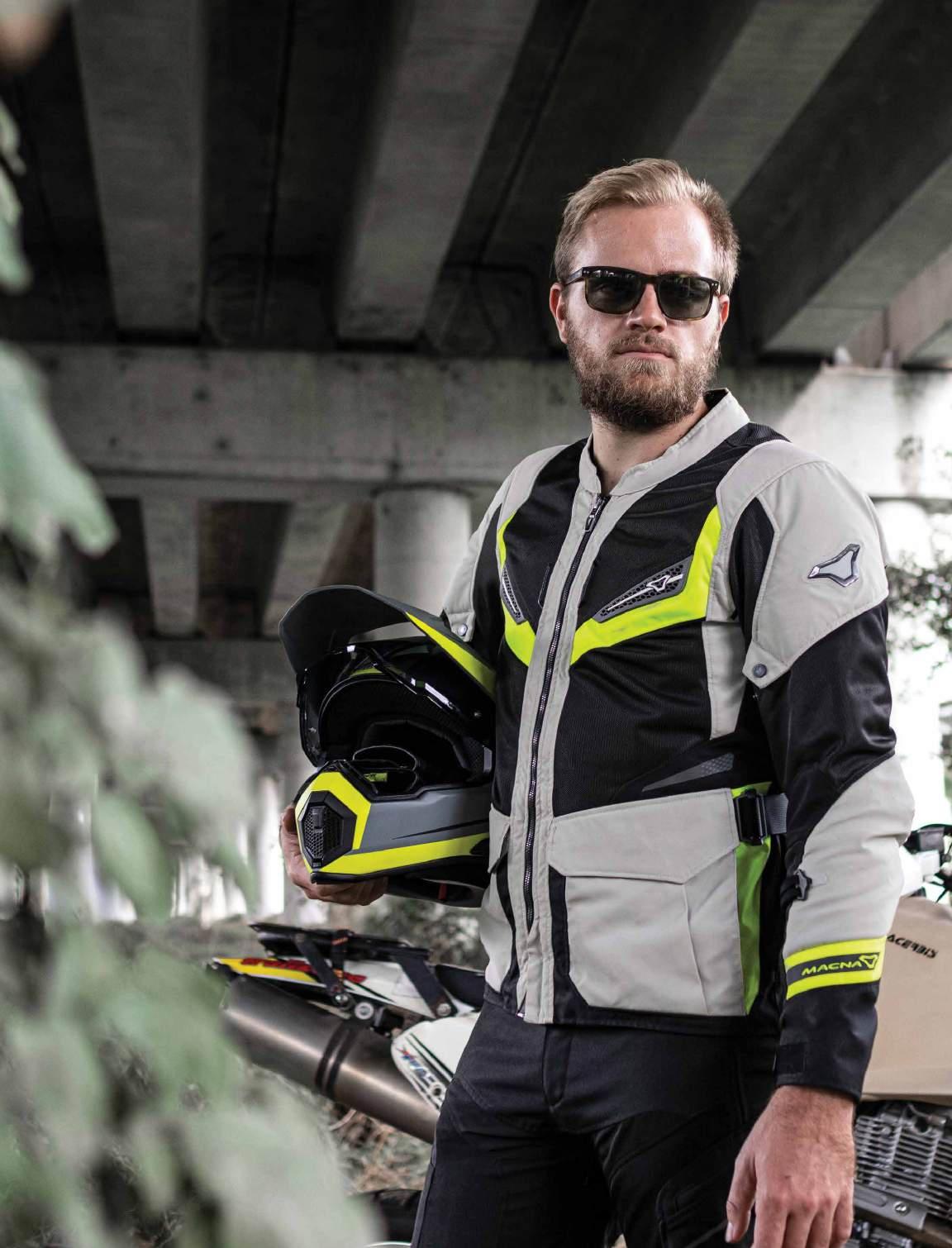








Tom
Foster - Editor
Ibought some crazy stuff while we weren’t riding.
I don’t even know how it happened. I’d be sitting at my desk, working away like always, and at the end of the day I’d realise I’d bought all kinds of things.
Some of it made sense. I’ve been searching for a particular tool I used as a kid when I worked in the lube bay of a service station. I used to work the midnight-to-dawn shift, and when the driveway was quiet – which was most of the time – I did tyre repairs. Back then it meant hunkering down with a couple of tyre levers and a rubber mallet and getting the work done. I was nearly always patching tubes, and the lube bay had a steel wheel with a timber handle which
was used to set the patch on the glue. It was brilliant, and I always wanted one. So, with time on my hands at last, I went looking.
I found a new version which has a rasp built into the handle. How brilliant is that!
But I also bought a couple of supertough phone cables. One was for the car and one for the bike. They turned out to be a strange purchase because I’d also bought a wireless charging head for the bike, and the cable I bought for the car was too short.
“ If I’d been without them for a couple of years, could I seriously need a new pair? And why two pairs? ”
The wireless charging head doesn’t suit my needs either, as it turned out.
And somehow I’ve ended up with a new wireless lavalier microphone.
I’ve been using a small shotgun mic for video for quite a while and it works well, but – and I still don’t understand
why – I inexplicably found myself with a new wireless lavalier.
Okay. I admit I’m a bit excited about that one. But still, I’ve only made two videos in the last year, so what was I thinking?

New Thermalz from Andy Strapz?
There wasn’t anything wrong with the old Thermalz. They were a little beaten up in places, but they were doing their job fine. When Andy’s website came up it was as though someone took control of my desk and I’d bought a new set before I knew what had happened.
A couple of pairs of Rocky Creek Designs safety glasses with the little magnifying panels in them somehow made their way into my shopping basket when I was on that site. I’d lost a pair on a mountainbike ride a couple of years ago and it seemed like a good idea to replace them.
If I’d been without them for a couple of years, could I seriously need a new pair? And why two pairs? I must’ve had some reason, because I bought one yellow pair and one clear pair.
I’m not game to confess to some of the really wacky shit that’s been turning up in the mail. The sooner we’re all back on the bikes and riding the better off I’ll be. Not riding is way too expensive.

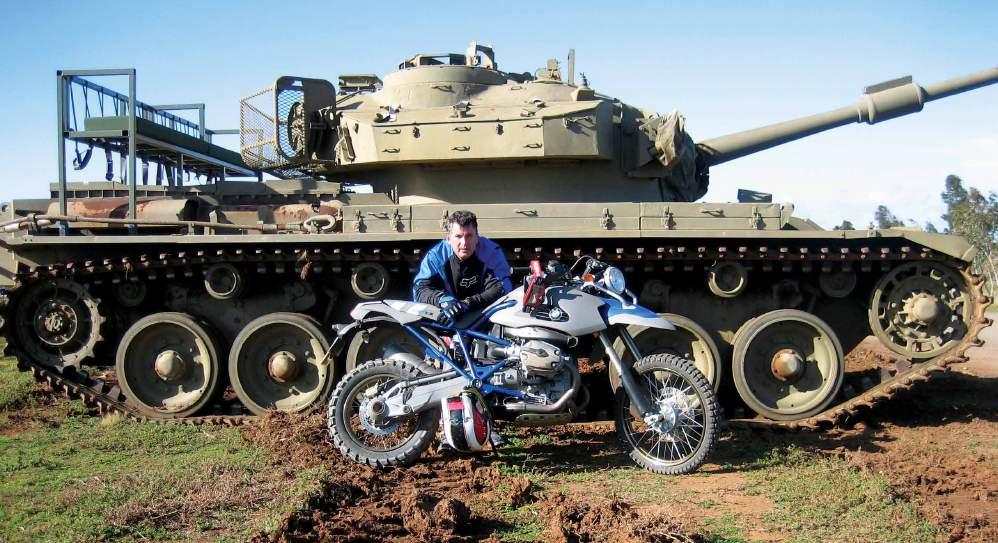

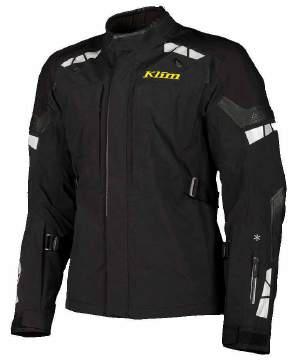
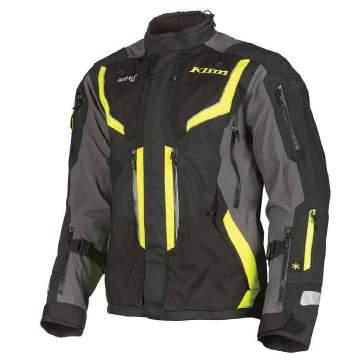







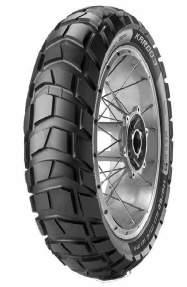

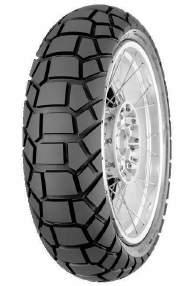







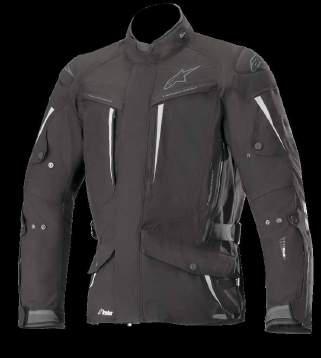
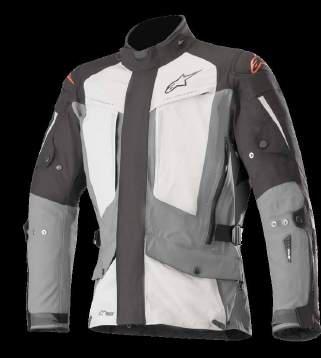
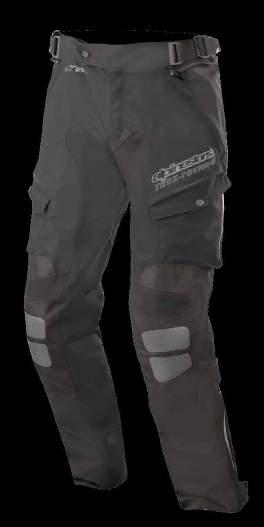

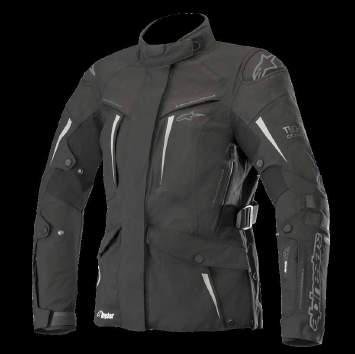
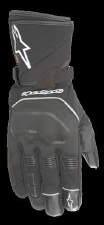


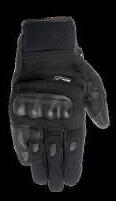
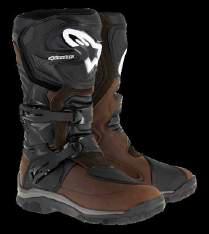


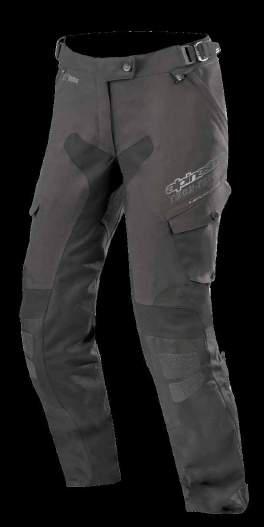
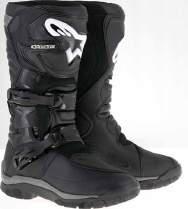

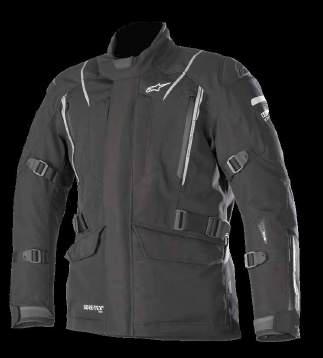

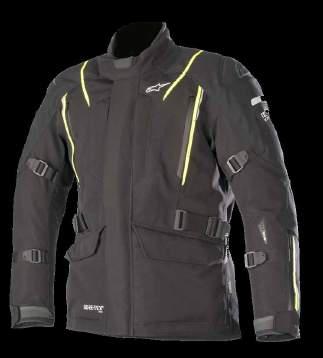








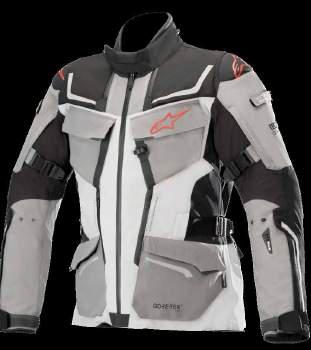

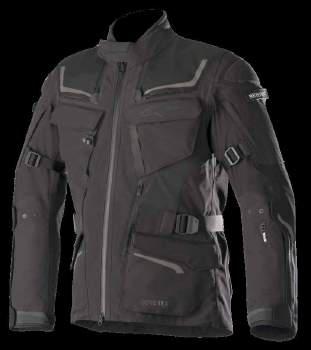


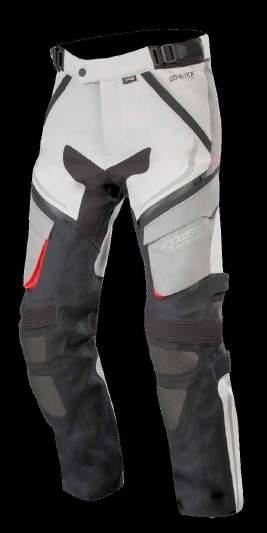

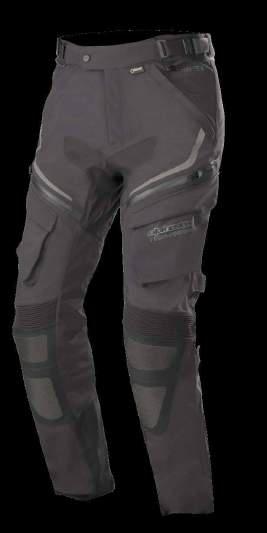






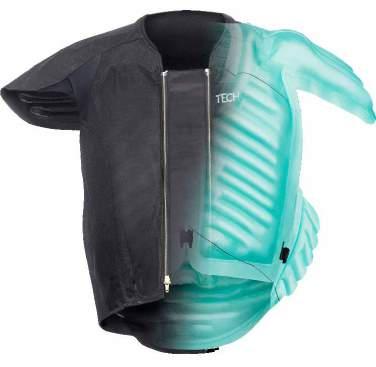


Adventure Rider Magazine is published bi-monthly by Mayne Media Group Pty Ltd
Publisher Kurt Quambusch
Editor Tom Foster tom@maynemedia.com.au
Group Sales Manager Mitch Newell mitch@maynemedia.com.au
Phone: (02) 9452 4517 Mobile: 0402 202 870
Production Arianna Lucini arianna@maynemedia.com.au
Design Danny Bourke art@maynemedia.com.au
Subscriptions: (02) 8355 6841 / (02) 9452 4517 nikita@maynemedia.com.au
ISSN 2201-1218
ACN 130 678 812
ABN 27 130 678 812
Postal address: PO Box 489, DEE WHY NSW 2099 Australia
Website: www.advridermag.com.au
Enquiries:
Phone: (02) 9452 4517
Int.ph: +61 2 9452 4517
Int.fax: +61 2 9452 5319


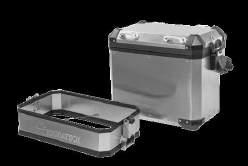
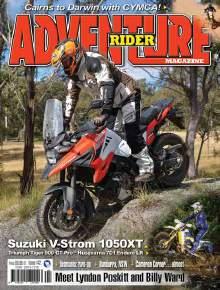
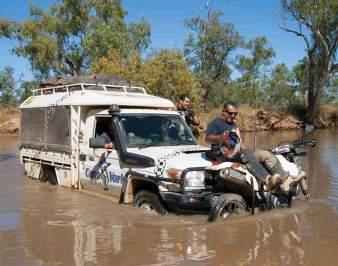


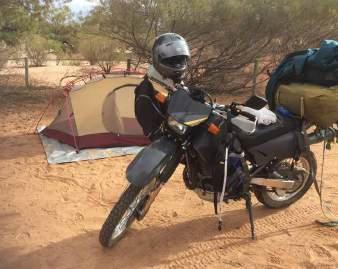
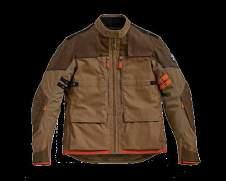



A ride from Cairns in FNQ to Darwin in the Northern Territory crosses the Gulf Of Carpentaria and runs through some of Australia’s most wild and isolated country, and Cape York Motorcycle Adventures has announced it’ll offer this amazing trip in 2020. Adventure Rider Magazine’s editor was with Roy and CYMA when the ride was trialled in 2011, and it was an adventure on a scale only Cape York Motorcycle Adventures could manage. This could be you in 2021…


Water crossings come thick and fast on rides in northern Queensland. Sandy, tractionless riverbeds alternate with submerged gibbers, invisible wheel ruts and uncertain depth to make every crossing a challenge. There’s crocs too, of course. Big, snappy-jawed, ugly bastards that somehow manage to stay invisible until the moment they strike.
So the long, concrete causeway at Drumduff Crossing on the second day looked a luxury. It wasn’t until about three-quarters of the way across it became obvious why there was a causeway in the first place. The raging current slowly but inexorably dragged the DRZs closer and closer to the crumbling
concrete edge. The slippery surface offered no real purchase and the depth and sideways pressure increased as riders juggled throttle and body weight to try and make the other side.
In a last final lunge I roosted to safety, heart pounding, hands shaking and water cascading from bike and rider. There was no way to tell the depth of the river on the drop-off, and I’d made it by the very tiniest of margins.
I looked back just in time to see someone not so fortunate.
It was one of those moments where time seemed to slow down, and a great deal happened in just a very tiny instant. Bike and rider plunged awkwardly sideways off the causeway and both disappeared below the surface. At the

same time, the rear of the bike behind followed, but the rider threw himself off and managed to keep himself and his bike mostly on the concrete. As we gazed in disbelief, the first rider’s head reappeared and began to bob its way downstream in the current as other riders tried to put their bikes in a position to help the pair. Of course, they were in the grip of the current as well, and, for just a few seconds, things looked very grim indeed.
A wonderful start to a long ride had quickly turned to shit in a big way.
Above: Awesome riding. Fast and free. Below left: One of those moments where time seemed to slow down.
Below: The smart way to cross a river in FNQ. u
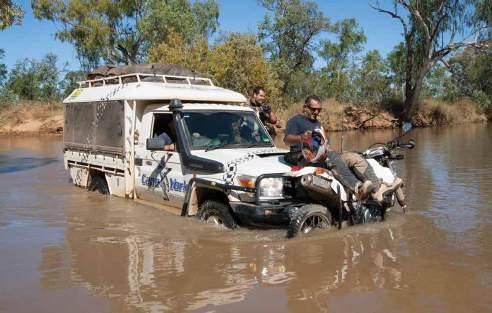

The unknown is exactly what inspires you to get out and tackle the next challenge. With a 23L tank, heated grips, cruise control, ABS, TFT connectivity display and the power to manage all conditions – you’ll conquer new terrain on every adventure with the F 850 GSA . This is a travel enduro made for real explorers, those who want to take on the world of GS.
Book a test ride today → bmw-motorrad.com.au/test-ride
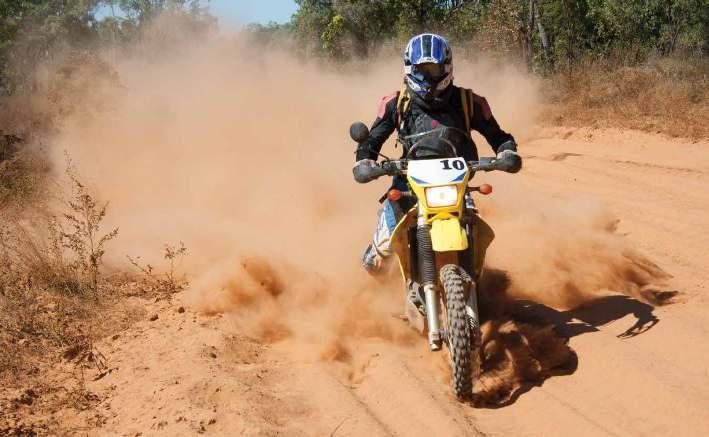
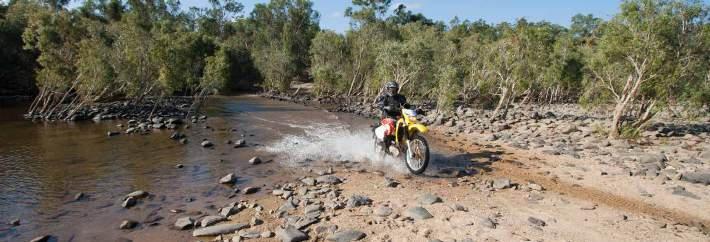
One of the best things about a guided tour is that all the riders have to think about is riding and enjoying themselves. After more than two decades in the trail-tour business Cape York Motorcycle Adventures has this sorted nearly as well as it can be done. Before you could say, “Crikey!”, tour leader Roy Kunda, sweep Lee Schirripa and support driver Bevan O’Conner had everyone back on dry land enjoying a cool drink and a luxurious lunch. The soaked rider was able to offer
up a wry, damp chuckle as he woofed into the lunch buffet and cold drinks while Roy and Lee set about drying out his bike. In 45 minutes or so everyone was well fed and back on the trail with no time lost and no real damage done.
What could’ve been a very nasty situation had been less trouble than a spurting countershaft seal at Borroloola, thanks to the competence of the Cape York crew.
In any case, it was a sobering reminder that despite the comfort and ease of the
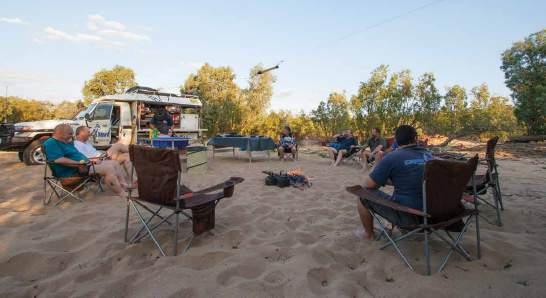
Left: Some sections were a bit dusty...
Below left: ..and some weren’t.
Bottom left: The second night of any tour with Revvin’ Bevan O’Conner was lamb-chop night. No-one’s going to let themselves be drowned and miss out on that.
Below: From left: Revvin’ Bevan O’Conner, Roy ‘The Boy’ Kunda and Lee ‘Prawn Star’ Schirripa.
A first-class crew.
early part of the trip, this was serious shit. It’s a long wait for help of any kind in Far North Queensland once you leave the coast, and by camp on the evening of that second day the group was nearly 750km west of Cairns.
Nobody cared, because the second night of any tour with Revvin’ Bevan O’Conner was lamb-chop night. And that’s backed up with orange poppyseed cake.
No-one’s going to let themselves be drowned and miss out on that lot.
This was Cape York Motorcycle Adventures’ first trip to Darwin, so the group was told at the start things might not go as smoothly as usual. There was some pioneering to be done, but with only six riders and three support crew it was set to be a pleasurable and lowstress tour.
And that’s the best kind.
The first day had been a text-book settling-in run over the hills behind Cairns, through the incredibly dense rainforest to Mount Molloy pub for the usual lunch, then out to a fabulous camp on the sandy banks of the glorious Mitchell River. Around the campfire it emerged that the Kiwis on the tour were dairy farmers, and much technical talk about teats ensued (I tried to join in, but apparently the



type of teats I knew about weren’t the same). While all that was going on, sweep rider Lee wandered off in search of yabbies and arrived back with something the size of a small Korean car. After a great deal of hooting and hollering the cherabin – a freshwater yabby normally the size of a large prawn – was roasted over the coals and carved into bite-sized pieces before being shared around.
Lee had finally realised his dream. He was a prawn star at last.
Tents situation
As always, tents were offered, but everyone followed Roy’s advice and slept on the supplied bunks under the stars, and believe it or not, that’s a major drawcard on this ride. That far from civilisation the skies are a deep, velvet black and the stars form a glittering blanket from one horizon to the other. You can imagine it from your city or small town if you like, but you’ll never understand
the majesty of the spectacle until you lie there and try to grasp the magnificence of it all yourself.
The snoring and farting of your campmates might take the edge off a little, for sure, but it’s still a great experience.
After the slip from the causeway was handled with such ease it was a real shame to have a simple, low-speed fall put an end to that same rider’s trip a couple of days short of Darwin. Nursing damaged ribs, he retired to the front seat of the LandCruiser and was forced to listen to Bev’s Lee Kernaghan albums for the rest of the journey. It may seem harsh punishment, but it’s a harsh life out there, and only the toughest survive.
All that grimacing and those packets of painkillers were nothing to do with his ribs.
But that was later. Before that there were the sights of Borroloola and Normanton to be taken in, camps at the incredible Adel’s Grove and quirky Lorella Springs, and several more waistline-boosting camp dinners to be enjoyed in exotic and secluded locations most Australians will not only never see, but will never hear of or know they exist. That’s along with big stretches of the Development Road and Savannah Highway, of course. There was serious distance to cover each day.
Roy’s sense of humour got a workout at the Calvert River camp.
After crossing into the Northern Territory everyone’s spirits were high as the day’s 400km rolled away.
u
Harder then any of us imagined
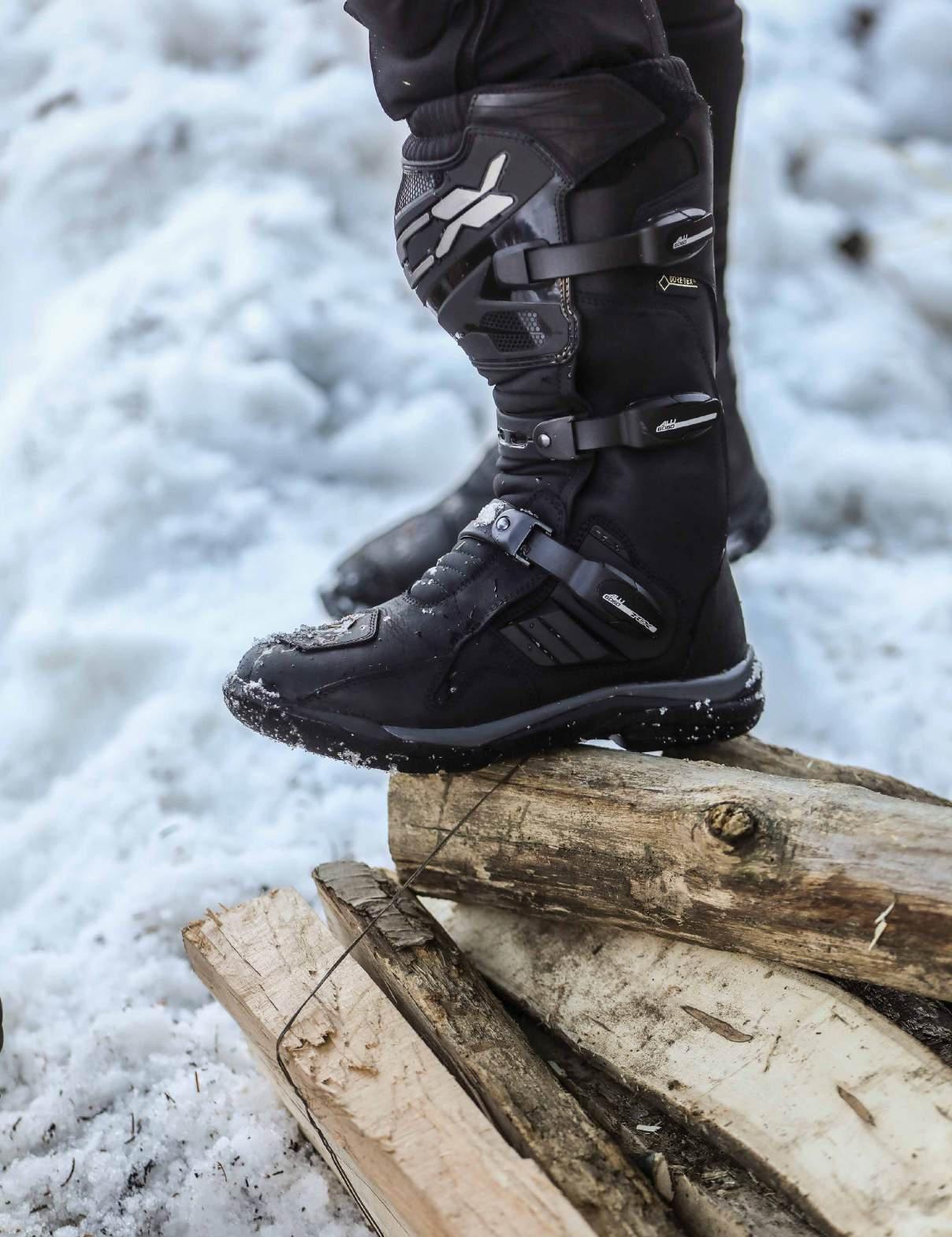
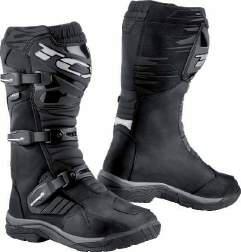
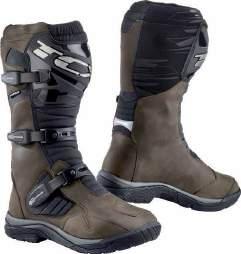
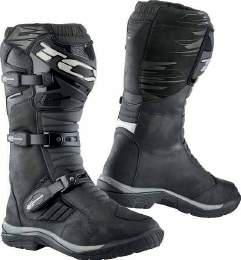

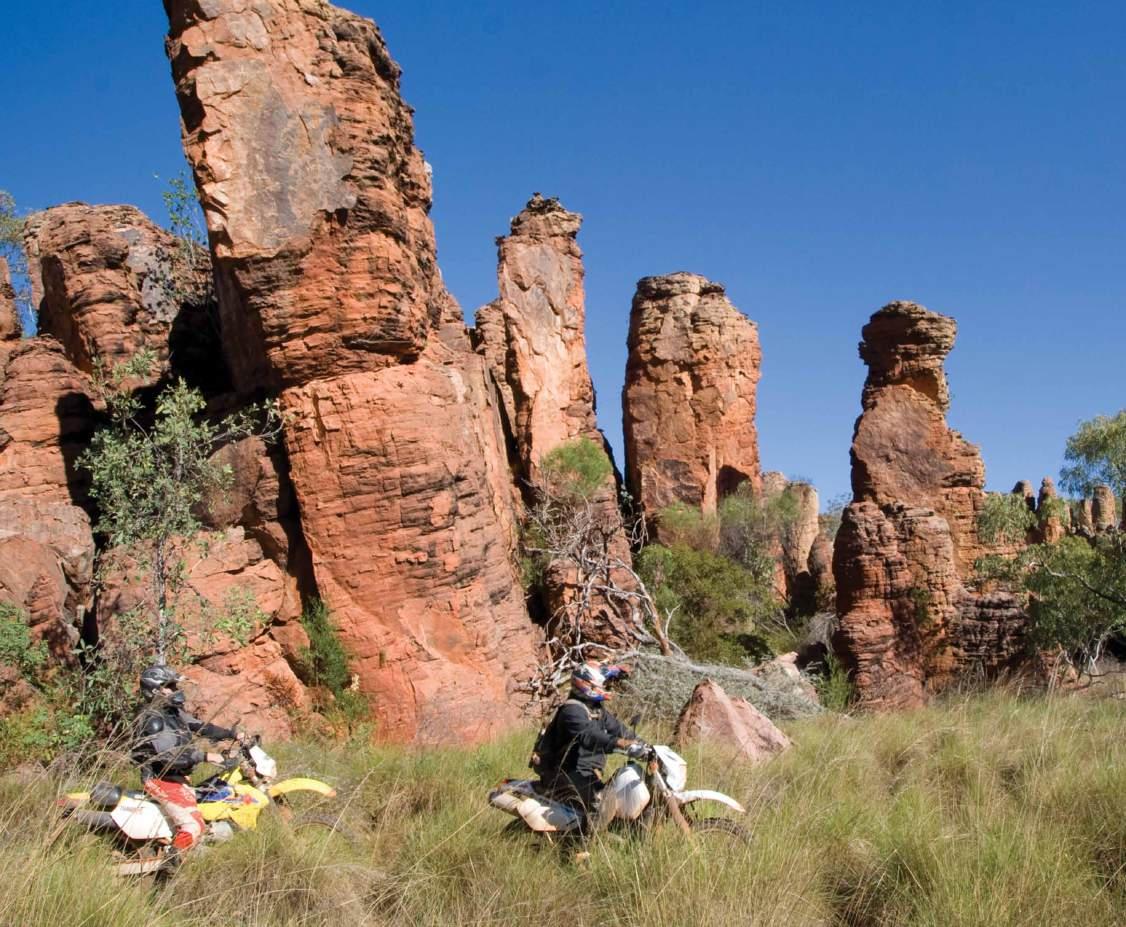
The morning was a superb winding trail past cattleyards and across some astonishing scrub flats, and with the sun setting Roy pulled everyone up to say there was someone at the campsite and to ask how we felt about sharing with a Swedish backpacker. He was left talking to a diminishing dust cloud. At the words ‘Swedish backpacker’ it was as though the gate had dropped at an AMA outdoor and there was a short run to the first turn.
By the time a smirking Roy caught up with the group everyone had introduced themselves to Stefan – who was German, not Swedish – and begun gathering firewood for preparation of the grain-fed eye-fillet steaks promised that evening.
Swedish backpacker, pffft.
It did get everyone into camp quick, though.
It’s not easy to convey in words the sheer magnitude of the isolation and unspoilt beauty of the Gulf country. The images of these pages will say far more than words can, but to be standing there in settings like the Northern Territory’s Lost City or the magical oases of Edith Falls and Butterfly Springs is something only experience can truly convey. These impossibly beautiful places are becoming popular with bus tours and especially with the grey nomads, but right now are as they must’ve been for thousands of years. Better still are the rivers, billabongs and monoliths that don’t have names. They’re just fabulous sites in a country covered in fabulous and amazing sites, and a bike is the ideal way to see them, stopping whenever something catches the eye.
Above: Rock formations like these are a signature of the northern Territory.
Below: Roy pounced on a sizable snake and gave everyone a chance to have a hold of it.
Speaking of catching things, Roy pounced on a sizable snake and gave everyone a chance to have a hold of it before carefully releasing the little feller into the bush. Later on, stopped by a picturesque billabong, one of the guys noticed a tiny snake’s head protruding from a hole and everyone gathered round expectantly. Roy, standing well back, explained the difference between a taipan and a black-headed python, and everyone kind of lost interest in snakes after that.
It was good to see one of the world’s most venomous killers, though…from a distance.


The riding wasn’t technical at any time. There’s plenty of river crossings and some slippery riverbanks, and on this trip there was a lot of dust. But mostly
it’s long, dirt-road and bitumen stretches. A couple of the days covered well over 400km, and one day was 570km. That’s serious distance on a DRZ.
Sometimes stupendous, unbroken
horizons are so wide and so distant that the curve of the Earth seems visible. Other times the dust is an almost solid wall that sits in the baking, still air for hours and challenges a rider to have the courage to keep going. Road trains with four trailers share the roads with buffalo, wild pig, ’roos and, of course, you.
There’s plenty of adventure out there. Just because the terrain isn’t challenging in itself doesn’t mean there’s much time to relax.
Roy trialled a DR650 on this first ride, and the DRZs coped well and were a heap of reliable fun in the swoopy dirt sections (there were still plenty of those). The deep sand in some sections was challenging enough on the lighter and more agile DRZs, but was a right cock-up on the 650 with the stock TrailWing tyres, as was the occasional patch of wet clay. u
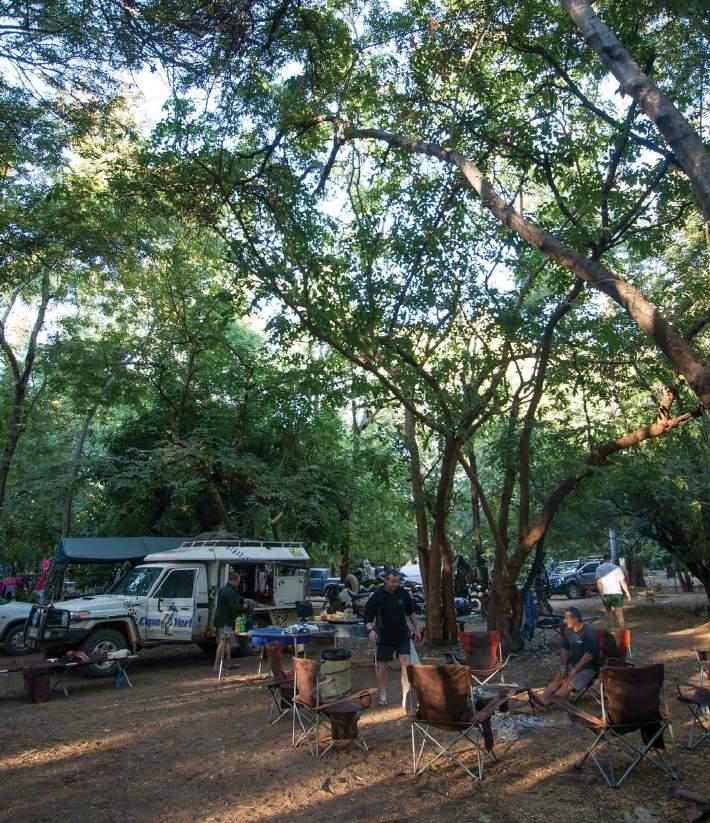
At the end of the eight days the very smelly, dusty, smiling group collapsed in the foyer of the Frontier Hotel in Darwin. Everyone was justifiably thrilled at having made the finish, and everyone was wide-eyed at the things they’d seen and learned.
Everyone was even more wide-eyed at airconditioning, hot showers and the sexy receptionist (definitely female this time, even though she wasn’t Swedish). It’s not a hair-raising enduro ride. The guys from Cape York Motorcycle Adventures make sure of that. Bike maintenance and tyre changes are done quietly by the crew while the riders settle in to dinner or breakfast. Fabulous, restaurant-quality food appears from camp ovens and around the campfires before the bunks can be set up and sleeping bags unrolled. The route, refuelling and emergencies are all covered.
All that makes it sound as though there’s not much adventure left in a ride like this one, but there is. Heaps. Road and trail surfaces change in an instant. Fuel stops that were open when the ride kicked off were closed when we arrived. Exotic animals darted out from behind trees and stumps or snuffled through the open campsites in the middle of the night. Best of all, people did unpredictable things that set everyone to rolling around laughing or jumping into action in situations where seconds could save lives. Even the population centres like Katherine and Normanhurst –where there were sometimes dozens of people – were wild and different in their own ways.
And there’s always the hope of a Swedish backpacker.
Oh yeah.
Adventure rides don’t get much bigger than this one.
Cape York Motorcycle Adventures will be running the Cairns-Darwin ride in 2021 and is looking for expressions of interest. If you’d like the riding experience of a lifetime –one that’s becoming more and more difficult to find as the environmentalists shut us down a bit at a time – give Renae a call on (07) 4055 0050, or log on to www.capeyorkmotorcycles.com.au.


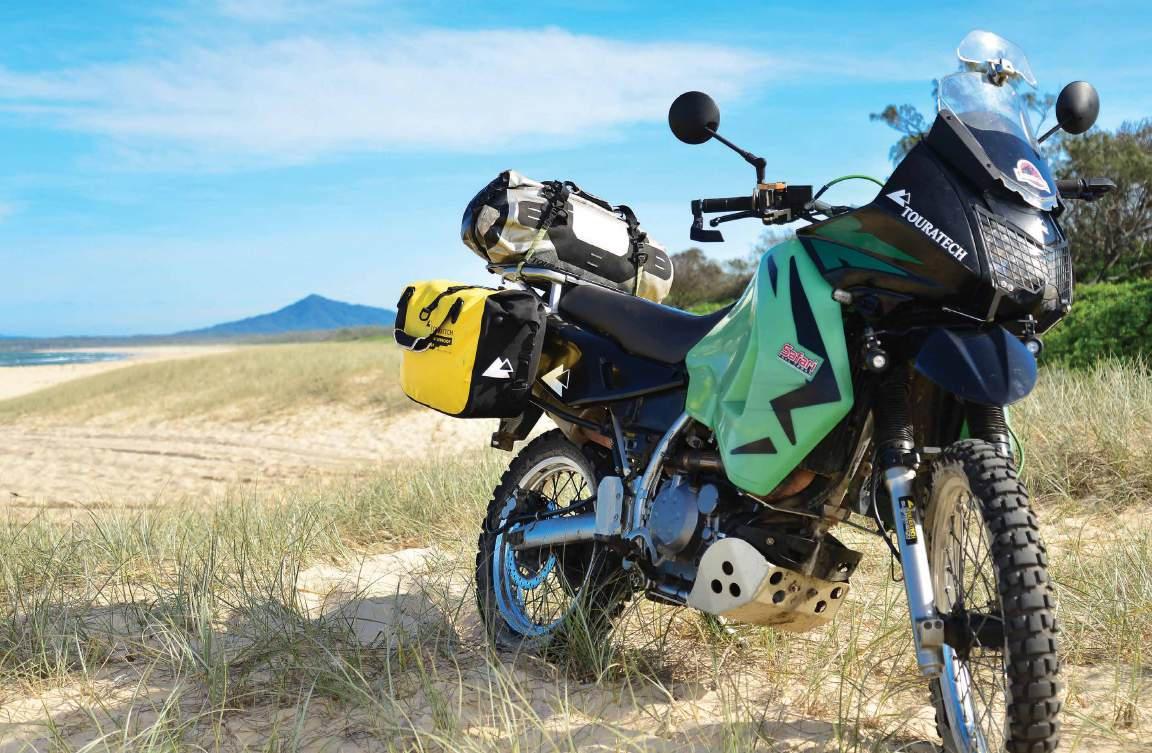
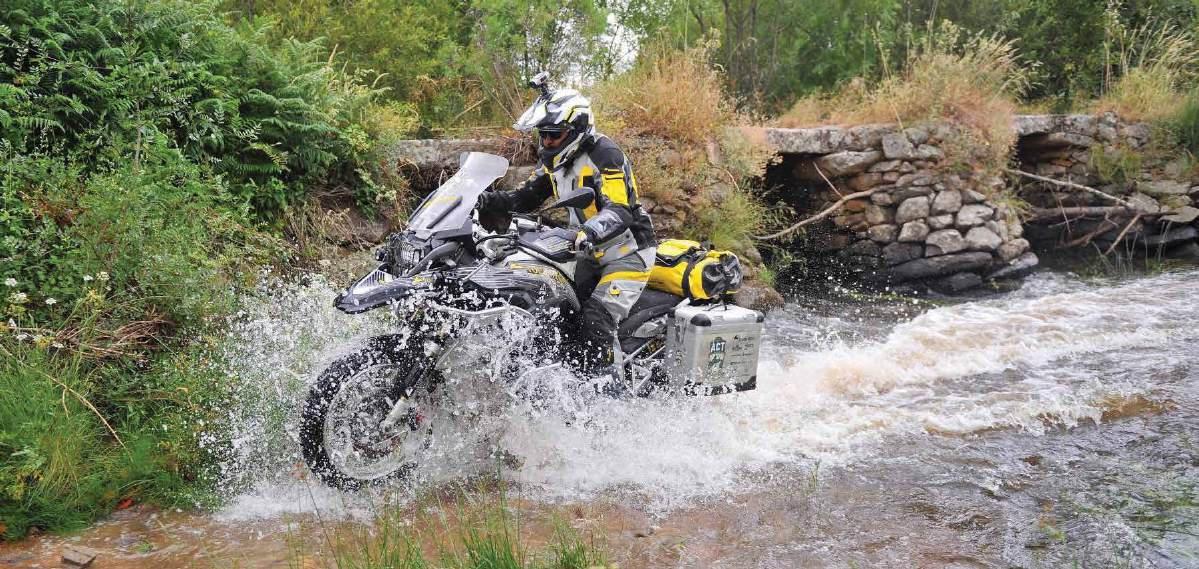


If you’re a fan of the Tiger
800 you’re about to go crazy- ape bonkers. The 900 Tigers look set to be everything that was great about the 800s, but with a heap of upgrades, more power and less weight. The Tiger 900 GT Pro is a good example.
To make it easy to understand the new Tiger designations, the GT and GT Pro are similar to the Tiger 800XRs. They’re the more road-oriented option of the new Tiger 900s. The Rally and Rally Pro parallel the XC and XCA of previous years, and the
‘Pro’ designation is for the higherspec bikes in the range.
We tried not to drool as a sparkling, gorgeous, Korosi red Tiger 900 GT Pro was wheeled from the Triumph showroom. It’s clearly a 50/50 bike with its cast, 17-inch and 19-inch wheels and
Metzeler Tourances, and as we frantically reefed hard on the tie-downs and headed out of the city we could clearly see some long, dreamy days of backroad touring in front of us.
Triumph’s triples have always been among our favourite motors. Both the 800 and 1200 Tiger were fantastic bikes to ride on- and off-road, due in no small part to the incredible, linear power delivery of the smooth-running threecylinder powerplants.
The 900s are an evolution of the 800 motors and have, of course, been through some development.
Capacity is now 888cc, and the firing order has changed to a 1-3-2 pattern which Triumph says is for ‘greater character’ and increased tractability at low revs. The single radiator of the 800 has been replaced with a twin-radiator
arrangement and the motor sits lower in the frame to assist with sharper handling. Outright horsepower has increased, as has torque, up 10 per cent. The engine is Euro 5 compliant and drives through an assisted slipper clutch.
The new bike is lighter than its 800 counterpart – up to five kilos, depending on which models are being compared –fuel capacity has increased, and, in general, the bikes have up-specced from previous models with equipment like Brembo Stylema Monobloc braking.
And what modern tourer could hold its head up without a TFT screen and a stack of electronic rider aids?
The 900 GT Pro ridden here has a 17.8cm TFT screen that’s so sexy we nearly melted when we saw it. Because we had the Pro model, an ‘integrated connectivity system’ is included. That basically means the bike’s on-board systems connect with a smart phone
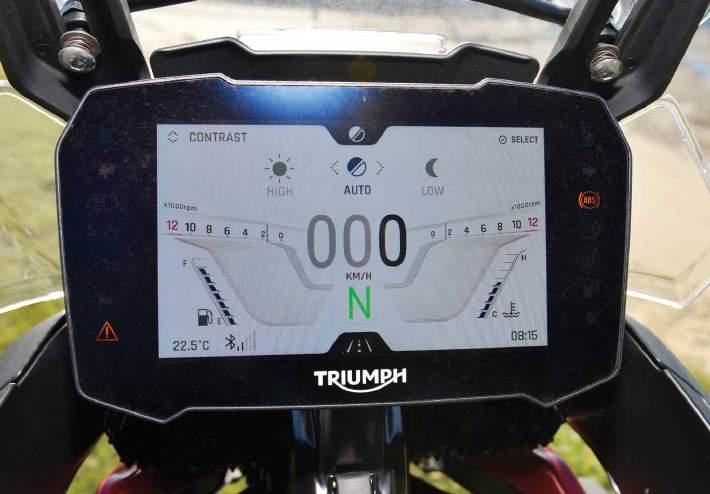
Left: The Tiger 900 GT Pro is a sharp performer aimed at predominantly road use. We still had a lot of fun with it on dirt roads.
Above: Still images can’t do justice to the TFT screen. It’s fairly spectacular. When the display is set on ‘auto’ it continually flicks between day and night – a white background and a black background – as the bike goes through shadows. We found it annoying and set it to ‘night’ and left it there.
and allow everything from music to navigation on the phone to be controlled from the ’bars and displayed on the TFT screen. Triumph built in a waterproof protective case under the seat, complete with power supply, and it’s clearly intended riders will park the phone there while they’re riding and avoid any unwanted attention from constabulary.
Of course, there are a stack of modes and LED lighting, and because this was the Pro, there were also heated grips, heated seats, shift assist, cornering ABS and traction control, tyre-pressure monitoring and electronic control of the shock preload.

The bike is a wet dream on wheels for the long-distance brigade who like a sporty edge.
Before we could climb on board the new Tiger we had to join the rest of the world
and pair the phone to the bike. Our blank look must’ve sent a message as clear as a frequency-modulated radio signal, because Triumph’s incredibly patient representative slowly guided us through downloading the Triumph app and the pairing process – not without a few mumbled comments about how old the phone was. It seems a few years is the definition of ‘ancient’ in the high-tech communications world.
But with that process completed and the phone safely stowed we climbed on board, flicked the key around to light up the TFT screen and prepared for action.
Except there were a further multitude of possibilities offered on the screen, which itself has a few different modes or presentations.
Triumph’s menu system isn’t difficult, and thanks to having enjoyed several Triumphs over the years as the bikes and systems advanced, we were able to grasp it all fairly quickly.
The main feature everyone wants

to understand straight away is how to select a riding mode. On the Tiger now it’s the same as it’s been since the last 1200 we rode: push the ‘m’ button on the left-hand switchblock, use the little joystick under the left thumb to move right or left to highlight the required mode, then push the little joystick in to select. Pull in the clutch at zero throttle and it’s done.
If everything turns to chocolate mousse, hit the home button on the right-hand switchblock and start all over again.
The switches are lit by internal LEDs, by the way, a very nice touch.
Changes can be made on the fly and it’s an easy system to use. The odd-bod is changing into, or out of, any mode where ABS and/or traction control is off. That requires the bike being stationary.
Choose to suit
With the preliminaries sorted the fun began.
The GT is, in Triumph’s own words,
Above: The GT Pro is a bottler for sightseeing and covering distance, especially for those who like the occasional high-speed strop when circumstances allow.
Right: A purpose-designed compartment for a smart phone under the seat includes a power supply.
‘transformed for even more urban adventure, proper long-distance travel and everything in between’.
We feel that was underselling the bike’s off-road capabilities a bit, but there’s no denying that, taken in the context of a lightweight tourer and occasional dirt-road squirter, the GT Pro is a pearler.
We didn’t feel a huge difference from the new firing order. The motor still seemed to give the linear power and torque delivery we loved on the 800, and the feel was very similar. It’s nice to use. Either getting playful on mountain
roads or settling back with cruise control in charge on the highway, it’s an effortless pleasure. It can be lugged in a tall gear way down low in the rev range or it’ll keep delivering when it’s asked to scream its head off up near the redline. That brings the modes into focus of course, and we messed around with the five on offer: Rain, Road, Sport, Off road and Rider. Rider mode allows the setting of each of the parameters, although, as far as we could see, those parameters could only be set to Triumph’s category titles, if you know what we mean. If we wanted to set a particular parameter,

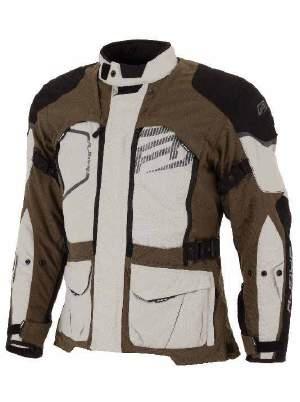
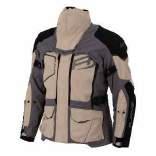

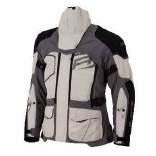

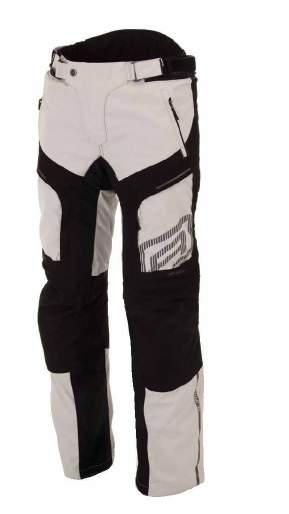
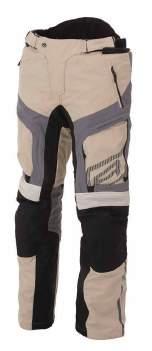
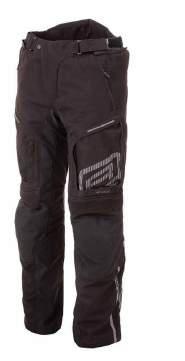
$499.95 RRP
- Outer Shell: CH3532 & Nylon 1000D on shoulders & elbows.
- CE Armour in the shoulders & elbows.
- Elbow protectors are height adjustable.
- EVA Rubber back pad.
- Waterproof & breathable liner (15,000mm/10,000mm).
- Removable 100g thermal liner.
- Detachable all-weather collar.
- (AVS) Air-Ventilation system for cooling.
- Multi panel mesh comfort lining.
- Stretch comfort panels.
- 4 outer pockets & 4 inner pockets.
- Arm & waist adjusters for a customized fit.
- Reflective print.
- Connection zips for pants.
- Available Men’s (SM-8XL) & Ladies (10-18)
$369.95 RRP
- Outer Shell: CH3532 & Nylon 1000D reinforcement.
- CE Armour in the knees (height adjustable)
- Waterproof & breathable liner (15,000mm/10,000mm).
- Removable 100g thermal liner.
- (AVS) Air-Ventilation system for cooling.
- Detachable braces
- Multi panel mesh comfort lining.
- Stretch comfort panels
- 2 outer pockets.
- Waist adjusters for a customized fit.
- Reflective print
- Connection zips for jacket.
- Available Men’s (SM-6XL) & Ladies (10-18)
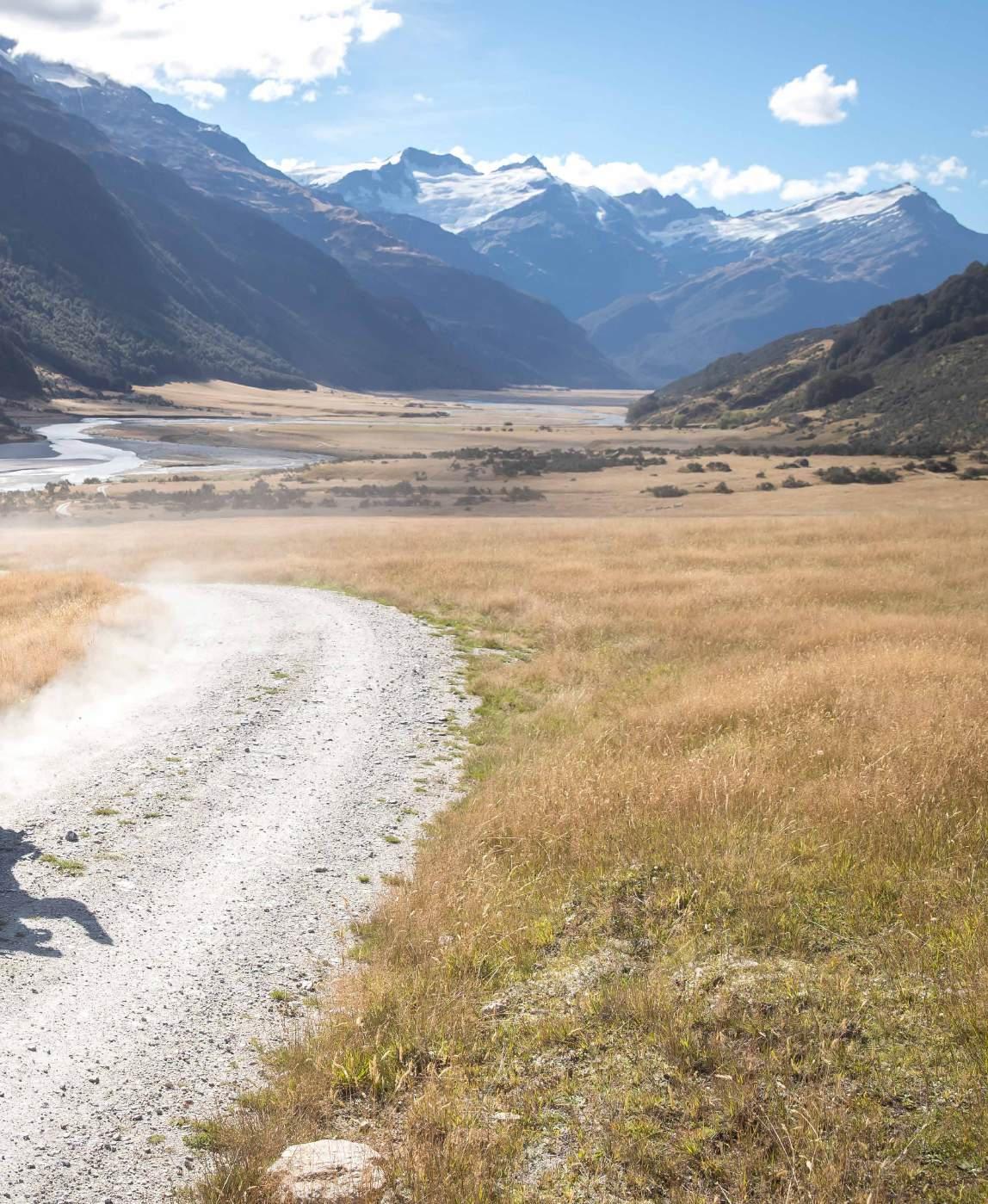


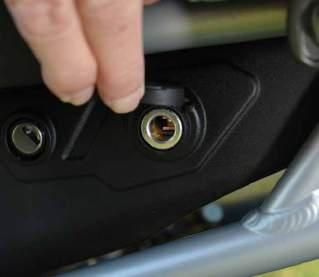
the choices would be on or off, or whatever Triumph offered within the modes. There was no numerical setting available for it to be a bit one way or the other. ABS, for example, could be on, off, or Off road, which meant it was active on the front only.
That was more than enough choice for us, and after a great deal of trial we ended up using only Sport, Off road and, on odd occasions, Rider. Sport is a go-likestink, smile-a-mile-wide option for carving up on the bitumen. Intervention from traction control and ABS was at its maximum and did a good job when things got scary. Off road was a little less frantic from the throttle, ABS was switched off at the rear, and traction control was sensible. We set up the Rider mode with no ABS and no traction control for those occasions when that was what called for. We don’t see the GT being asked to cope with a lot of deep sand or scary downhills, but it’s good to know the option is there.
Cornering ABS and traction control is a big feature on the bike, and we like the
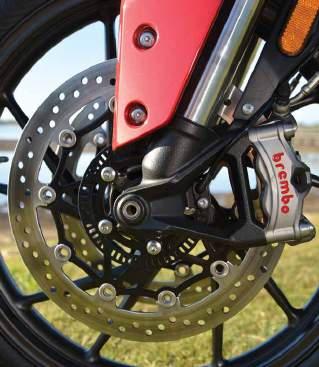

comfort of knowing it’s there on the asphalt. We’re rapt to say we didn’t have it save our backsides during our time with the bike, but anyone who can’t see the advantage of the systems is a mug. When we hit the dirt it was only a matter of pulling up and selecting Rider or Off road to ensure we could enjoy the fun, and that was a small price to pay to be able to cut loose and know the chance of a highside or lowside on the tar was greatly reduced, no matter how limited our talent.
The new Marzocchi suspension both ends is good and the electronic preload adjuster on the rear makes for an easy life. Loading up with luggage and/or a pillion only requires a touch of the button to get the bike sitting level or close to it, and seeing as there’s no tools or crouching down needed, far more riders are likely to make the change. For that reason alone it’s a good idea.
The forks are fairly firm.
We liked them, but messed around a little because we felt they were a touch unforgiving on our test section. It’s a nasty section, and that’s why we go there, but it’s the type of terrain a rider on this type of bike could reasonably expect to encounter. For what it’s worth we went from seven clicks out on the compression to three clicks out and felt we were better off. Like all suspension tuning, it’s very individual, so don’t go making notes for the same adjustment if you ride the bike yourself. Do have a play with the clickers, though. There’s plenty of scope for adjustment.
Both front and rear work well, especially on the road.
We’re holding back a bit here because while we loved the GT Pro, we have
Top left: A 12-volt power supply just beneath the seat is a great feature. It’s the small Hella socket, not a cigarette-lighter size.
Top right: Heated seats! Crikey. The rider’s seat height has the rubber-band adjustment that’s been on the Tigers for ages. It’s simple and effective.
Below left: Braking is Brembo, and it’s first-class.
Below: The switchblocks aren’t too crowded and the menu system was fairly easy to understand and use.
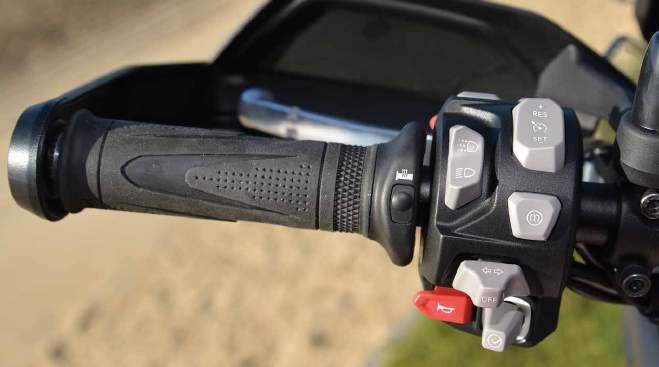

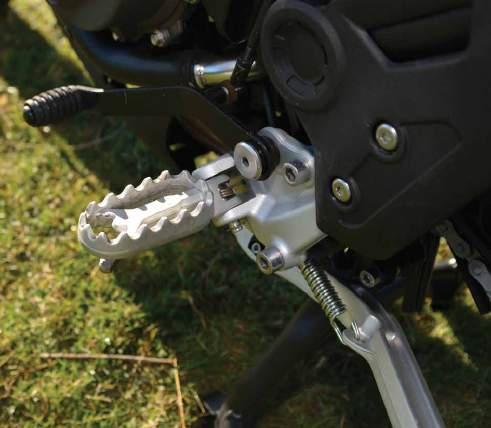
Above: We removed the rubber inserts from the footpegs before we rode the bike. They pull out, no tools needed. The ’pegs are a good size.
a lump in our tweeds for the Rally and Rally Pro, and this bike only confirmed how good we expect the more off-road versions to be.
For those who perhaps don’t chase the more-challenging terrain, especially those who want to sit back and watch huge chunks of Australia roll by on long, untroubled days, the GT Pro is a premium option. The finish and detail is absolutely gorgeous, as it has been on every Triumph we’ve seen in the last 10 or 15 years, and the bike is ready to sit up and join in with anything the rider wants to do, whether that’s explode through alpine bends working the Shift Assist – which worked well up and down through the six-speed box – or wander along a dirt road wondering where it goes. Fuel consumption during our time with the bike was around 19km per litre, so the 20-litre tank gives a range of around 380km. Let’s say 350km to leave a safety margin. That’s plenty in a bike like this one.
The phone connection was nice. We didn’t make the most of it because it stretched our tech comfort zone quite a bit, but seeing the name of a caller pop up on the TFT screen, choosing a song or two and even reading texts without having to do anything more than look down was awesome. GPS navigation is available too, but we forgot how to make it happen. There’s no doubt a whole wide tech world we’re missing out on, and we need to get cracking on catching up.
At the end of it all, the Tiger 900 GT Pro is a stunner and has everything we’ve always loved about the Triumph’s Tiger since we first rode one a decade ago. There’s a big range of Triumph luggage and accessories available, including two ‘packs’. The Trekker Pack has a Trekker 52-litre top box and mounting system, Trekker panniers and mounting system, top-box backrest, tank pad and adjustable screen deflector. The Expedition Pack has Silver Expedition panniers and mounting system, fork protectors, aluminium dual radiator guard, fuel tank crash bars, headlight guard and a waterproof 40-litre roll-top bag. So the bike can be set up and ready to go straight from the dealer floor. It’s a superb, versatile performer and a really beautiful and comfortable choice for long hours and long distance.
We can’t wait to get hold of a Rally.
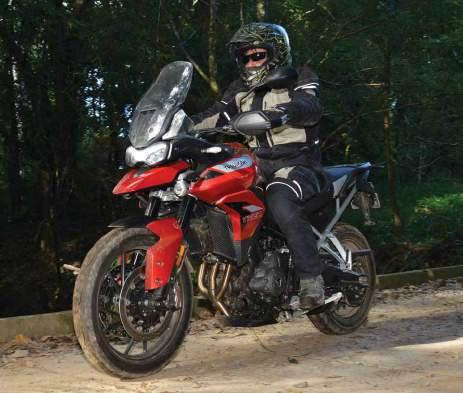
Recommended retail: $21,950 plus on-road costs. Web: triumphmotorcycles.com.au
Engine type: Liquid-cooled, 12-valve, DOHC, in-line four-stroke
Capacity: 888cc
Bore x stroke: 78.0mm x 61.9mm
Compression ratio: 11.27:1
Maximum power: 93.9hp (70kW) @ 8750rpm
Maximum torque: 87Nm @ 7250rpm
System: Multipoint sequential electronic fuel injection
Exhaust: Stainless-steel three-into-one header system with side-mounted
stainless-steel silencer
Final drive: O-ring chain
Clutch: Wet, multi-plate
Gearbox: Six-speed
Frame: Tubular-steel frame, bolt-on subframe
Front wheel: Cast alloy, 19-inch x 2.5-inch
Rear wheel: Cast alloy, 17-inch x 4.25-inch
Front tyre: 100/90-19
Rear tyre: 150/70R-17
Front suspension: Marzocchi 45mm upside-down forks, manual rebound and compression damping adjustment 180mm (140mm GT LRH)
Rear suspension: Marzocchi rear-suspension unit, electronically adjustable preload and rebound damping, 170mm travel
Front brake: Twin 320mm floating discs, Brembo Stylema four-piston Monobloc calipers. Radial front master cylinder, Optimised Cornering ABS
Rear brake: Single 255mm disc. Brembo single-piston sliding caliper.
Optimised Cornering ABS
Handlebar width: 930mm
Height without mirrors: 1410mm – 1460mm
Seat height: 810mm – 830mm
Wheelbase: 1556mm
Dry weight: 198kg
Fuel capacity: 20 litres
Colours: Korosi red, Sapphire black, Pure white
Service intervals: First service at 1000km, then every 16,000km or 12 months, whichever comes first






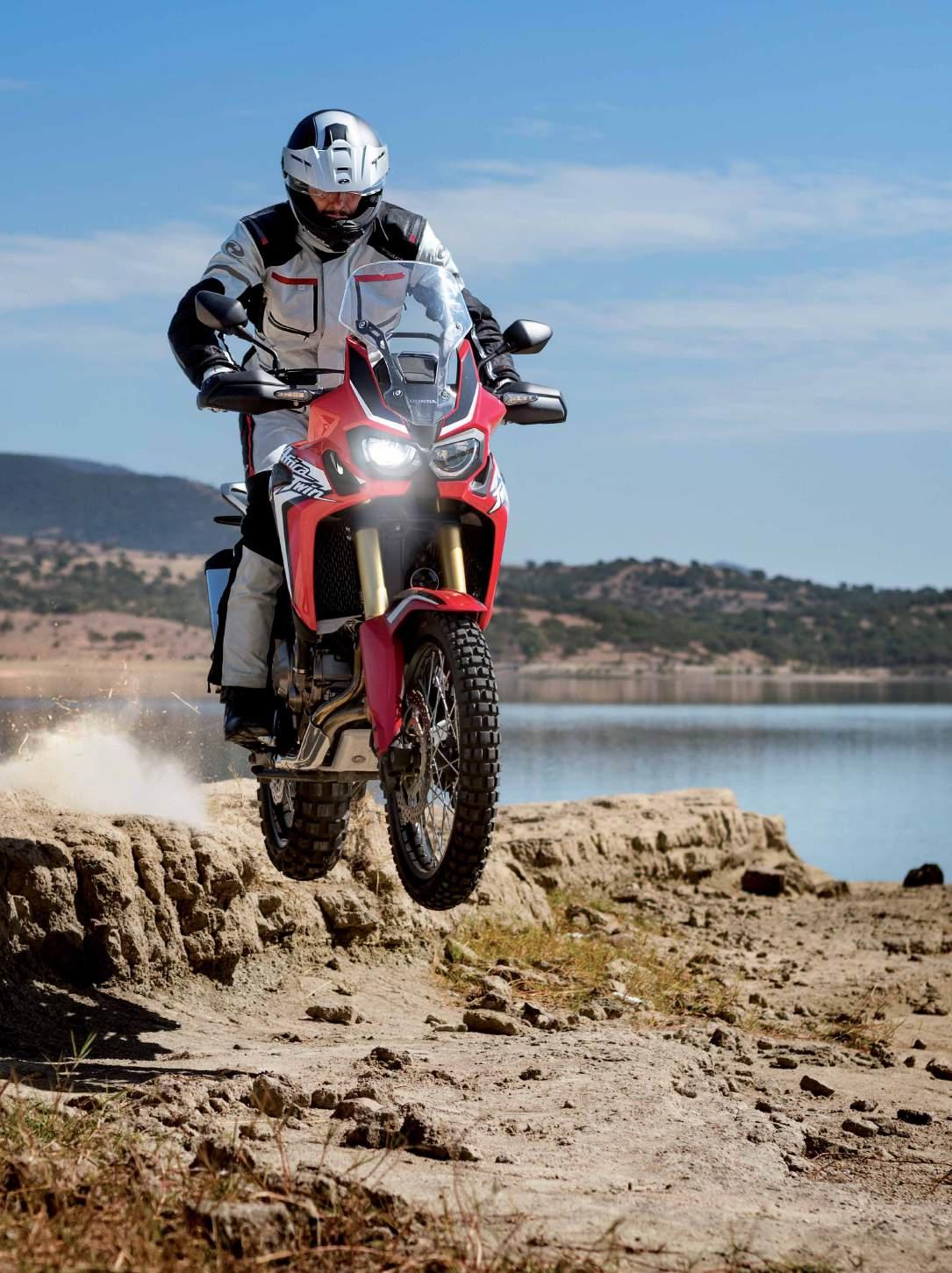












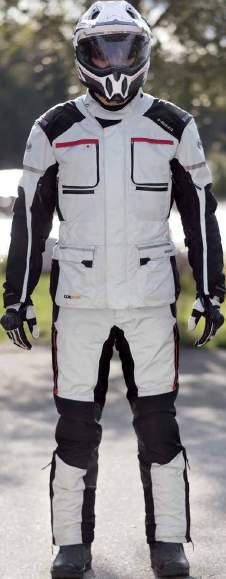

The Home Boss was working and the only mandated decree for the weekend was, “The grass will be cut and yard tidied before I get home on Monday.” Hopper saw an opportunity.
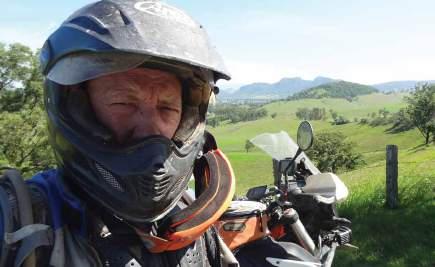
Aconniving plan was formed. I knocked off work early, fired up the Victa and battled the mozzies and long grass into Friday evening to free up the weekend for a blast in the bush. A late-night call to Ruth at Bundarra’s Commercial Hotel locked in accommodation, a toothbrush and a spare pair of undies were packed, and all was set for an early start.
I left Newcastle at 7.45am, rode the highway to Maitland, then backroads through Rosebrook, Elderslie and Glendon to Singleton. The 790 roosted on to Lake St Clair then peeled off, finally hitting dirt and the well-known Bowmans Creek Road. It was awesome riding and a total contrast from heading to the 2019 Congregation when the same route was nothing but a barren brown land and thick with dust. On this day in 2020 lush green paddocks were dotted with the cattle looking like Adventure Rider Magazine’s editor – very well fed. Lizards were sunning them-
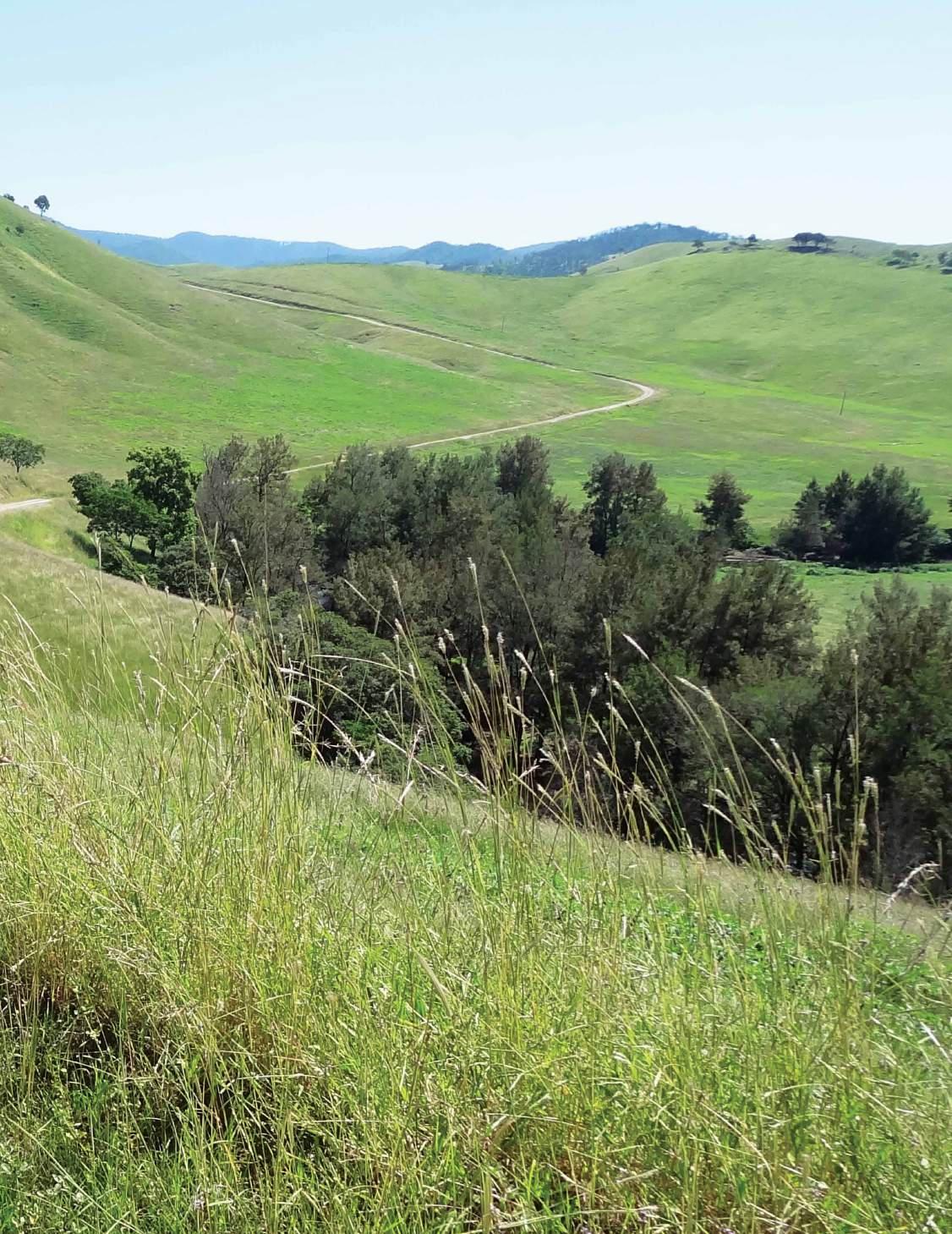
selves. I even saw an echidna.
I rolled through Gundy, resisting the urge to stop at the Linga Longa Pub – I’d enjoyed some good feeds and the odd beverage there in the past – through Timor and Crawney Pass for more great riding, and into the old goldmining town of Nundle. A splash of 95 octane for the 790, and some highly recommended home-made pies and hummingbird cake for the rider, made for a pleasant break. It wasn’t as busy as usual, but there were still a few road riders to share a yarn.
With both bike and rider full I blasted onto Nundle Forest Way. A few loose gravel sections required care, and then Niangala Road and Campfire Road offered up great dirt riding to the small township of Woolbrook. A short stint on the Oxley Highway and some back-
roads through Wollun and Kentucky led to a top up with 98 octane at Uralla, then it was black-top to Kingston, taking the Old Kingston dirt road through Sundown country.
A few culverts across the road could cause the unwary rider some grief on that section, but I coped and rolled into the Commercial Hotel at 3.00pm after 504km. The hospitality was great and I joined the locals for a refreshing ginger ale before unpacking and changing the 1190 prefilter socks which work very well on the 790.
I’d stayed at the same pub a month earlier and the same people greeted me in the bar. It was a great evening. I thought us adventure riders could spin a good yarn, but we’ve got nothing on farmers. It was great to see the camaraderie in these trying times, and how they were working together as a community to get their work done. The talk was mostly of building up stock numbers following recent rain, which was a much better vibe than a few months previously.

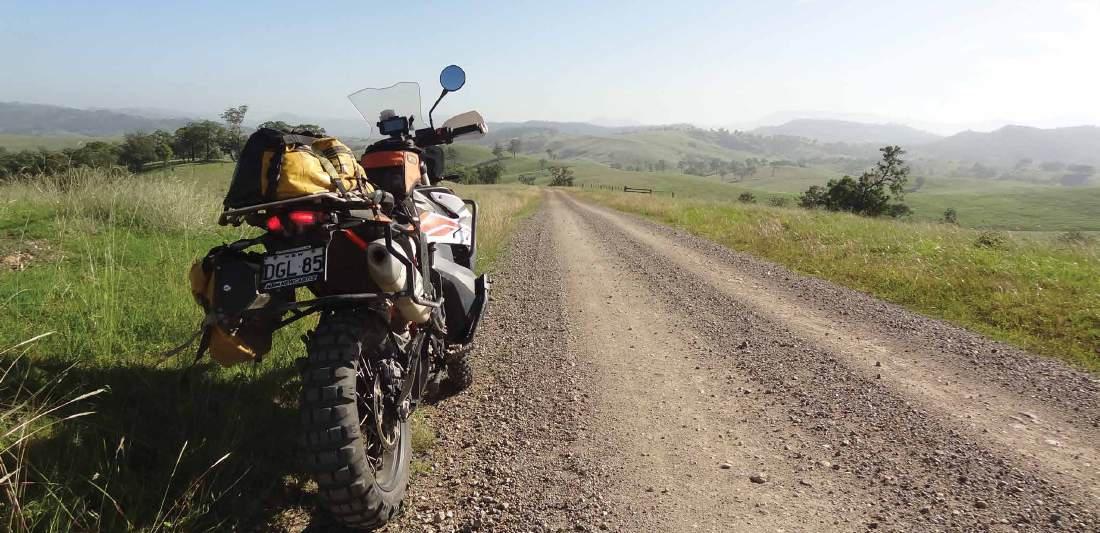
A seafood basket and a ginger ale made for a great atmosphere. I found out after the third glass the ginger ale also had vodka in it, which probably contributed to that night’s sleep being a good one.
The next morning I packed up, chatted with some of the workers staying at the pub, and left at a very civilised 8.45am.
After backtracking to Kingston, I headed south on Bendemeer Road, a good-quality dirt run. The map showed a track running parallel, so I jumped across on to the Airlie Stock Route. It certainly needed a lot more respect than the main track, but was quite doable on a big adventure bike.
I would normally have stopped at the Pioneer General Store in Bendemeer for great food and coffee, but, unfortunately, it’s closed. That’s certainly a loss. It was well frequented by riders.
Bendemeer Station Track was next, another well-known adventure route, and it was great to see the grassy paddocks and the greenery on the fire-darkened trees. There are great views at the top of the track, but ambition overtook ability on one of the cattle grids when the far side dropped a metre or so and tested the 790’s suspension. Thankfully the excellent front and rear saved a poor choice from the rider becoming a very poor choice.
Much relieved at a narrow escape, I
headed back through Woolbrook and on to Walcha for fuel and a chilli-chicken wrap at the servo.
The Oxley Highway snaked its way toward Port Macquarie and I turned on to Brackendale Road and blacktopped it for a while, then hit the dirt again.
It’s normally a good, high-speed run, but on this day, with a lot of large, loose-gravel sections, I was uneasy at the bike’s wandering through the corners. The 790 must’ve had a worn rear tyre – it couldn’t have been the fault of the rider.
Through Nowendoc I blasted, staying on the backroads to Cooplacurripa. It was a good winding road, with plenty of ups and downs, great views and some ideal picnic spots along the river. Several iconic adventure tracks run off this road linking Nowendoc Road to the Oxley Highway –Enfield Range Road, Cells River Road and Knodingbul Road, for example.
On to Tiri Road to cross the Manning
River the 790 and I rumbled, and it was great to see the river flowing again and people swimming. It hadn’t been ‘swimmable’ there for a while.
A high bridge across the Gloucester River gave good views of the rapids below before the road headed through Bundook and on to a good winding section well suited to a brave rider. With the throttle open I joined Bucketts Way and pulled up to check out the incredible views from Mograni Lookout. It’s postcard scenery up there, looking across the Bucketts Mountains behind Gloucester.
After a splash of fuel at Gloucester I was homeward bound along 30km of Bucketts Way then back on the dirt through Monkerai to Dungog. From there it was 470km of backroads to Newcastle.
It was an easy two days of great adventure riding and Bundarra Pub was certainly a great place to stay.
I look forward to seeing many of you at this year’s GVF Congregation.


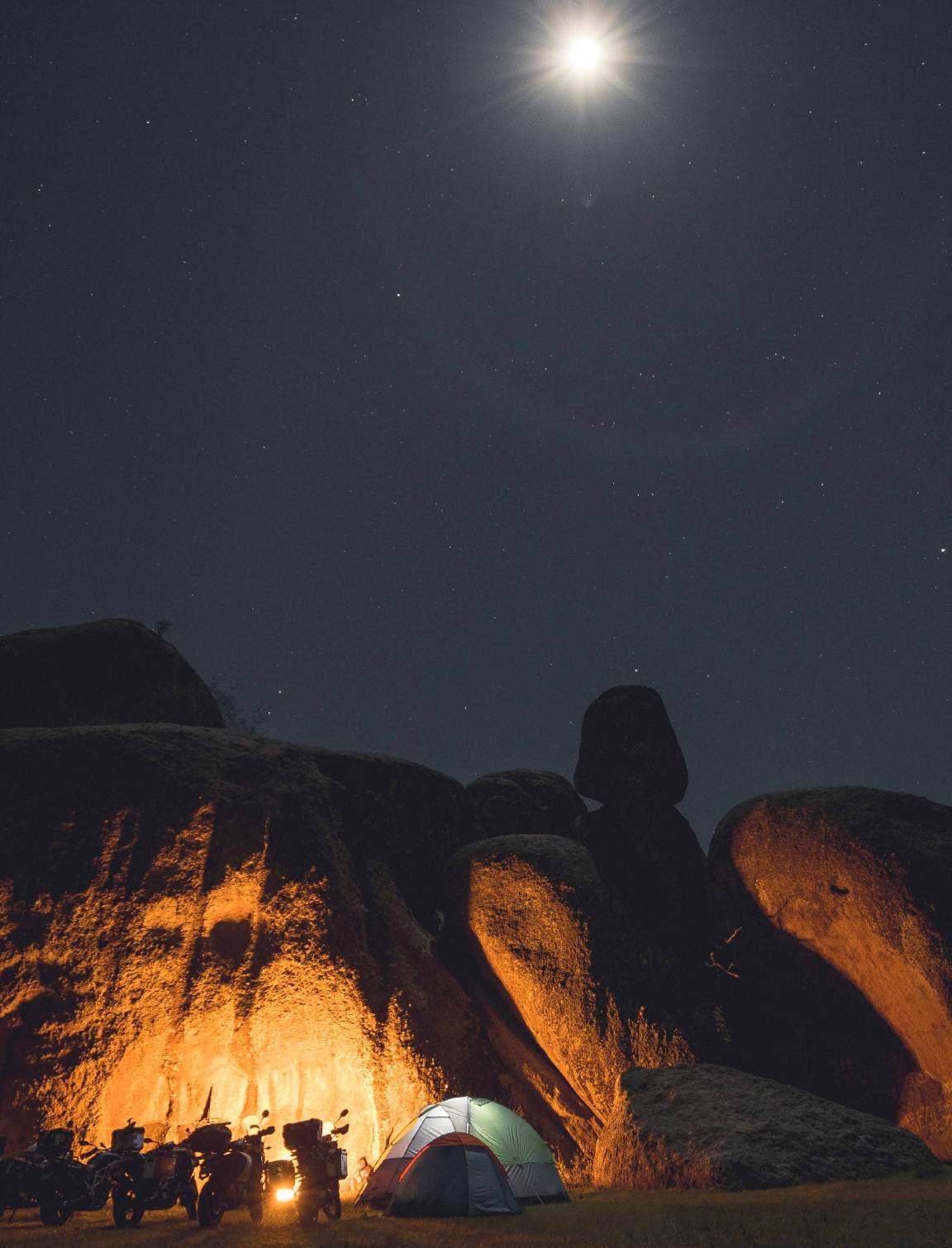
THOUSANDS OF PARTS AVAILABLE. ORDER ONLINE 24/7. DELIVERED TO YOUR DOOR. SUPPORTING YOUR LOCAL MOTORCYCLE SHOP.

Dear Lord, if, when our time comes we’re shown the pearly gates, can we please ride through on a Husky 701 Enduro LR so we can truly enjoy eternal bliss.
Feeling a bit saucy and want to get aggressive? Bring it on!
The 701LR will love it.
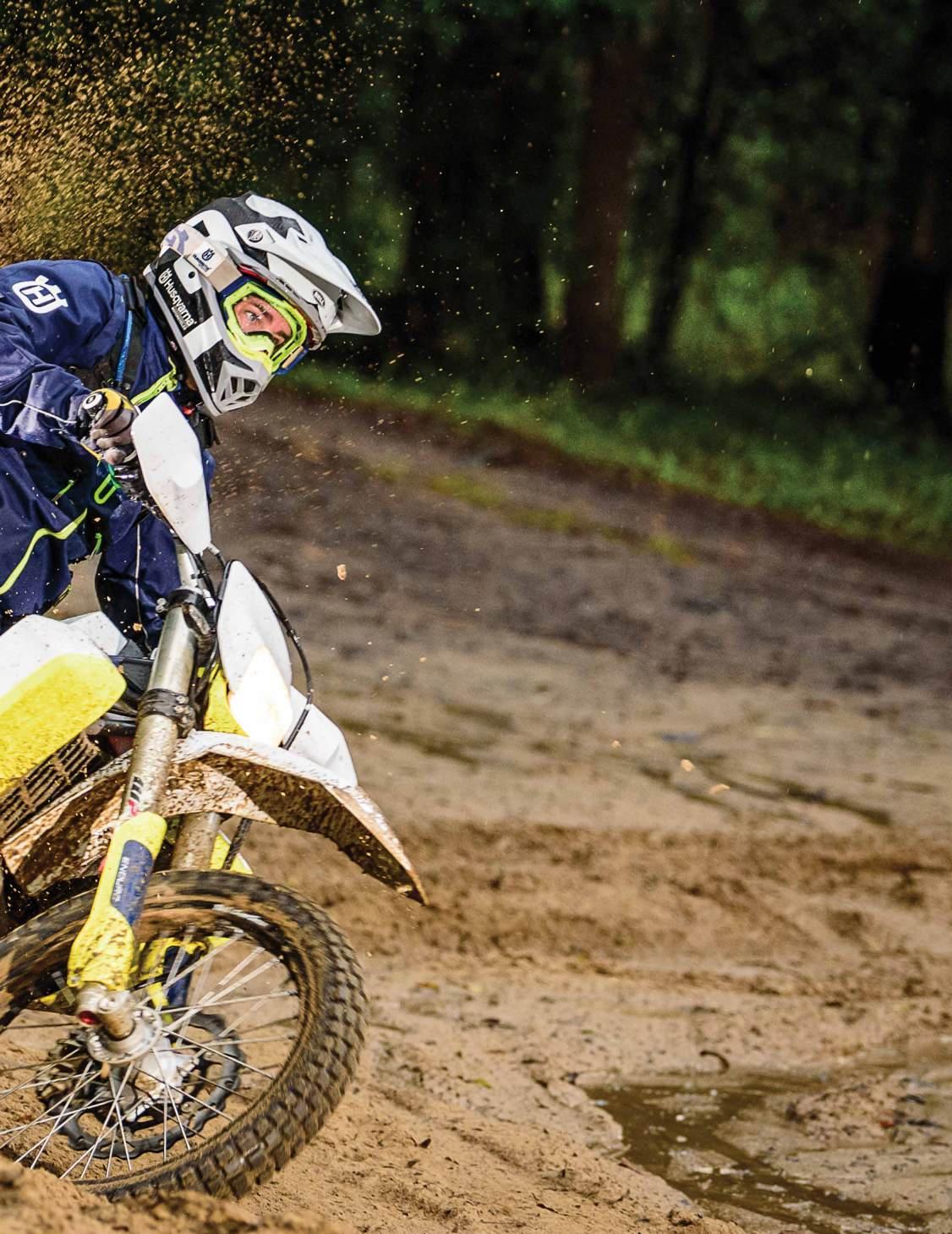
It may not be the perfect bike for everyone, but we refuse to believe anyone who knows anything about motorcycles could ride this bike and not walk away going, “Wow. Amazing.”
We’ve been frothing for the Husqvarna 701 Enduro since the model was first released. In our view it was a performance-oriented dualsporter of the very highest calibre. We rode it all over the place, including from the NSW coast out to Birdsville, into the Simpson Desert and back to the coast again, and found ourselves deeply smitten. On or off the road, the performance of the Husky 701 was a real eye-opener. Naturally, it was off-road where it really shone.
It wasn’t as comfortable as distance bikes like the BMWs, Triumphs and big KTMs, and it wasn’t as aggressive as a 450 enduro bike, but in the hands of a capable rider it could compete with all those other bikes on their home ground. Mechanically it was excellent and, allowing a very dirtbike-type feel, it was quite comfortable.
Now Husqvarna has upped the ante, because the LR version comes with 25-litre fuel capacity, a couple of ignition maps, a superb, smooth, stonking motor and a sweet nature that should have even the hardest-hearted rider smiling.
The 2020 LR is a 692.7cc, liquid-cooled single that, like so many of the currentmodel singles, is all but vibration-free.
Power delivery is strong and, depending on the selected ignition map, distributed nicely throughout the rev range and delivered to the rear wheel via an hydraulically activated slipper clutch, six-speed box with quick-shift, and an X-ring chain.
It won’t surprise anyone that WP suspension does the job front and rear, and that both ends are fully adjustable. The fork springs are one size heavier than the standard 701 Enduro to help with the extra weight of the front tank when it’s full, and we’re still a little stunned at how good the suspension was on the LR. With both tanks chock-a-block, several kilos of tools strapped to the grab bars over the rear guard, and some bits and pieces
u
Main: Just as happy puttering around taking in the scenery as it is shredding the place.
Insert: The pannier racks were sturdy and fitted close to the bike.
Below: The look of the front tank is sure to divide opinion, but the fuel load is kept low and the tank doesn’t interfere with rider movement.
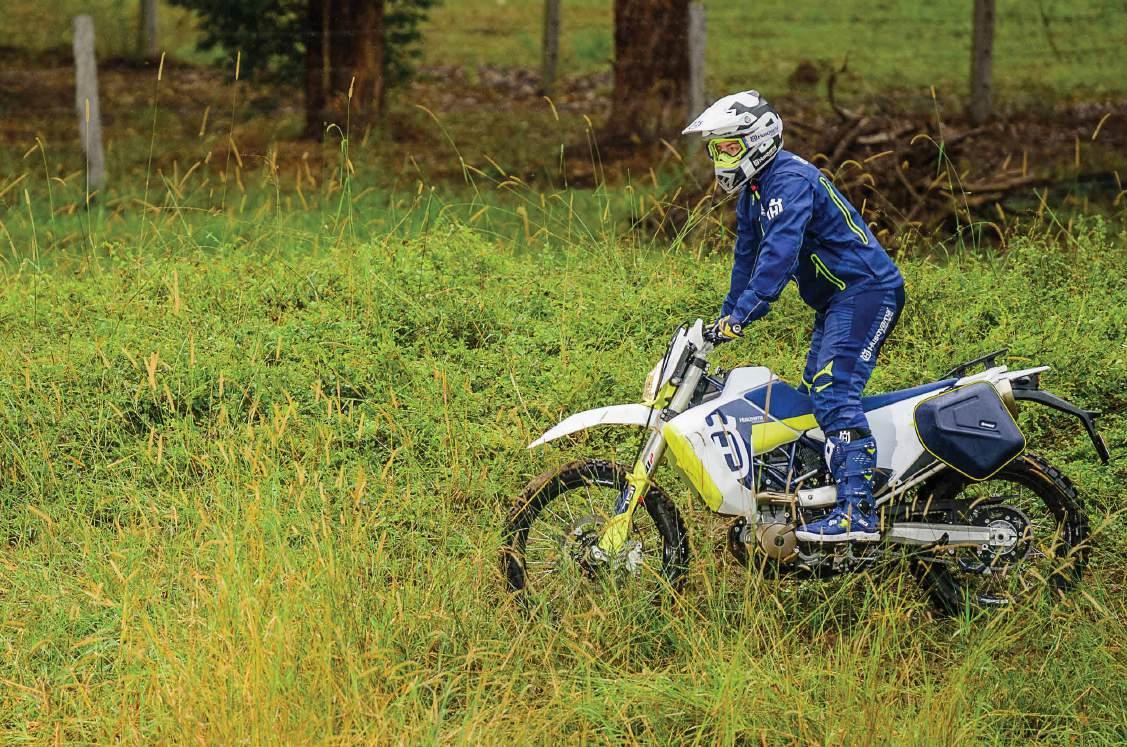

of camera gear in the panniers, the LR floated over rough ground, resisted bottoming on all but the most ridiculous landings, and gave a trouble-free and comfortable ride on the asphalt.
Fuel capacity will be on the minds of people interested in this bike, and front and rear tanks combined hold 25 litres, give or take, and on a bike like this one, that’s a substantial load that needs to be considered. Our mixed riding continually turned in consumption of just a smidge under 20km per litre, so 500km is the range.
Braking is as good as would be expected from Brembos, and the cream on the cake for us was Husky setting up our test LR with optional pannier racks and panniers.
It was a complete adventure package which looked to have been put together with Australia in mind.
Not only did Husqvarna supply an adventure-ready bike, it also supplied a feisty rider with a ready laugh and a huge sense of fun. Lewie Landrigan, race tech for the Husky off-road team, was ready to send the bike, at speed, into situations where even photographer Wilko and editor TF were looking a little doubtful – and those two love to send riders into huge piles of poo and sit back for a quiet giggle.
The LR coped with it all, and, even considering the ability of the rider, seemed to do it without any fuss or bother.
There’s no doubt the bike’s well capable of handling endurostandard trails and terrain, and it looked pretty happy when things went a bit motocrossy as well. Lewie found he couldn’t get the handlebar to touch the ground in a rutted turn, so he decided to go for what he called a ‘bag drag’, meaning getting the pannier
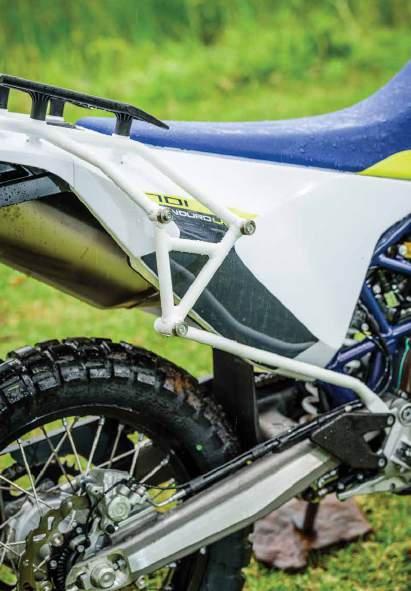
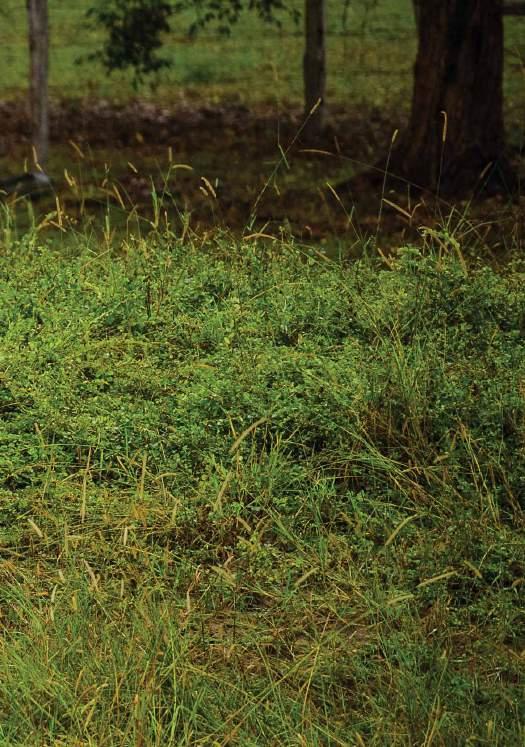
on the deck instead.
It was a very impressive performance from both bike and rider.
Away from the spectacular world inhabited by riders with far higher levels of skill than Adventure Rider Magazine’s staff, the Husqvarna was fired up and set out on the more mundane donkey work demanded by the more mundane donkeys of the real world, and having seen the bike perform so well during the photo session it was a little disheartening to think how little the bike was actually going to be ‘tested’. Nothing we could ask of it would even come close.
But ask we did.
The first step was to fill both tanks to the brim, strap on our regular tool pack with spare tubes, beadbreaker and all the other crap we have to carry these days, chuck some camera gear in the panniers and hit our regular suspension track.
The result was still an eye-opener.
The LR suspension is really exceptional, but even more so is the way bike felt so well balanced between front and rear. As we hammered it across the rounded, chunky gibbers sticking up through the red clay, it stayed straight and steered well. While so many riders judge suspension on how it reacts landing from jumps, for us, how a loaded bike tracks over this type of terrain is the ultimate indicator of how well the suspension is doing its job.













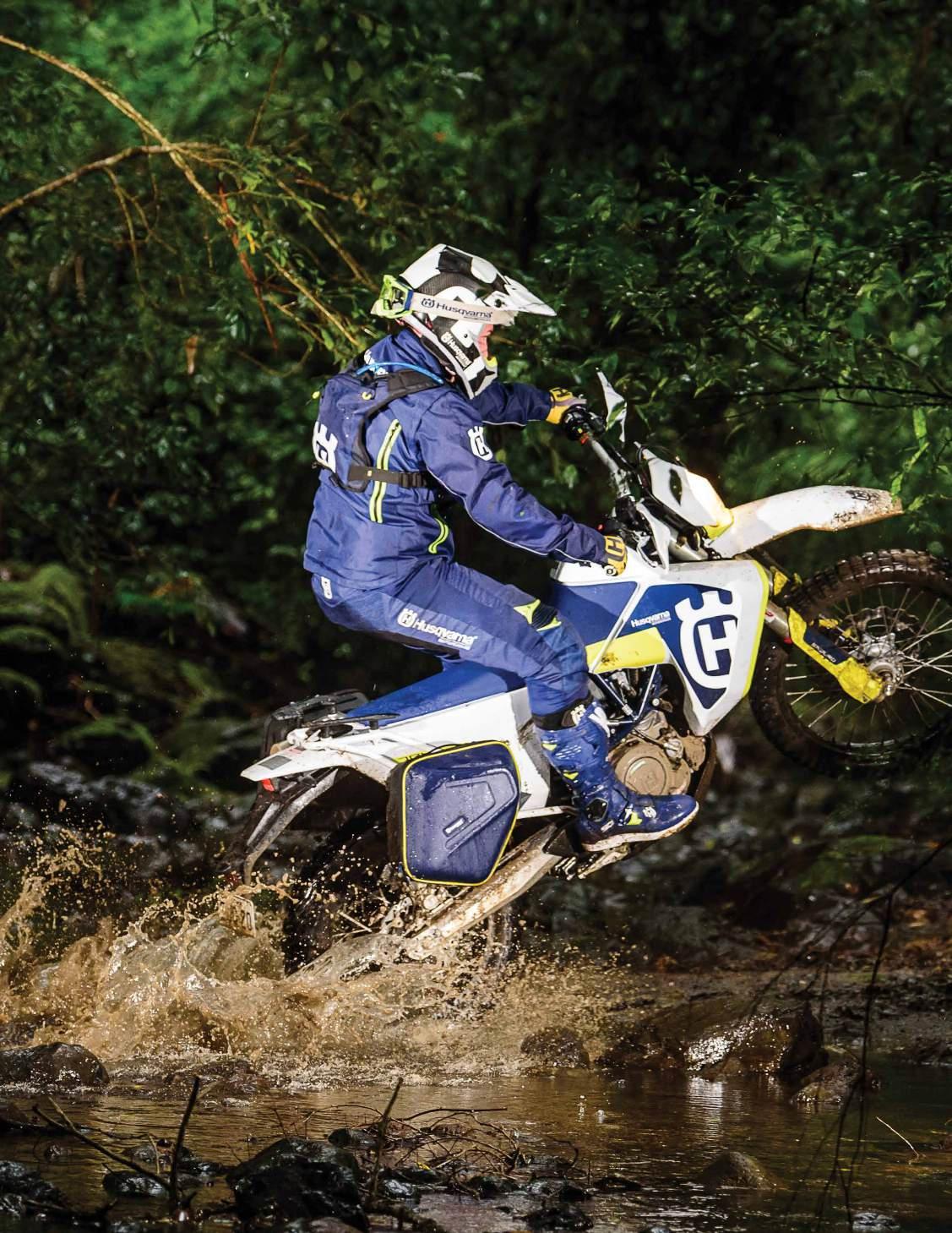
701
is an absolute joy to ride anywhere, anytime.
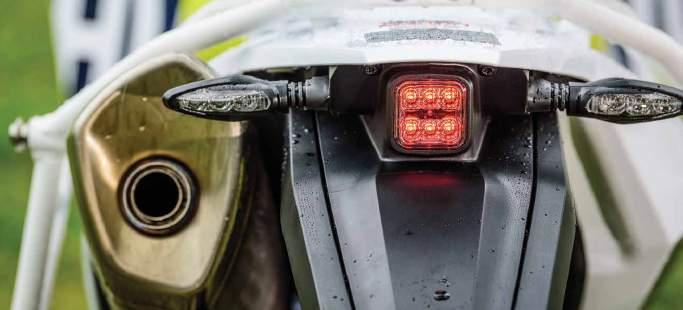
Crap suspension will have the bike crossed up and the rider in all kinds of trouble within a few metres. The fully loaded 701 scooted through the lengthy section as well as any bike we’ve ever taken through there. Later on with the front tank empty it jittered a little, but it straightened up when ridden harder.
Both front and rear are adjustable. There’s a clicker for compression on the left fork leg and rebound on the right, and three or four clicks in either direction made a noticeable difference. The shock was the same. A few clicks either way had the bike feeling different.
Had we not ridden the KTM 690 Enduro a few months ago we wouldn’t have believed stock suspension could be this good.
The motor and drive train are smooth and a joy to use.
We’re not huge fans of lots of rider modes, and even the two ignition maps available on this bike made us roll our eyes a bit, but it’s impossible to deny they’re both very different and both very usable.
Selection is just a matter of a press

of the button on the left switchblock. Push the button, flick the clutch, and the change is done. Map 1 gives a grunty, tame drive ideal for wet or slippery conditions, and map 2 is for humbling sportsbike riders and pulling glorious, controlled monos – or spinning up the TKC80 on the rear – on the bitumen. We actually liked map 2 on the dirt in the dry as well. With the traction-control off, map 2 made for the kind of throttle response and rider challenge we all dream of, but very few can truly use to advantage. We couldn’t push the limits of map 2 either, but far out, we had a ball trying. It was awesome fun.
Braking was incredible, as it is on most modern bikes, especially performance bikes, and especially with Brembos. The ABS has the big yellow button next to the speedo we’ve seen on KTMs and Huskies for a while now, and it’s dead easy to mash down on it with a thumb until the ABS is turned off. Perhaps it’s a symptom of our age, but we’re leaving the ABS active on just about all bikes all the time now. It’s developed to where there’s no need to turn it off except for when
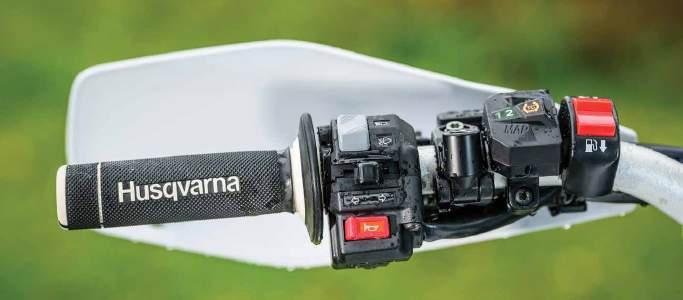
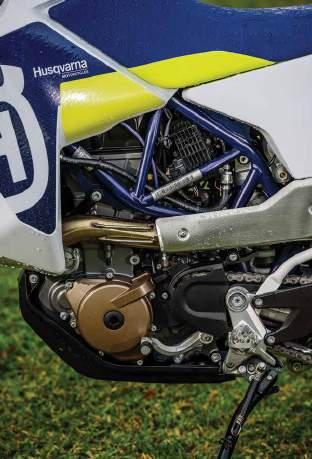
Above left: Gotta love a tight, tidy rear end. Above: A great motor, and almost vibration-free. Bottom left: Simple switching. Awesome. The innermost red rocker switch is to choose between front and rear fuel tanks.
confronted with a steep downhill, and that’s what we found with the Husky. We left the ABS on for our entire time with the bike, and happily left traction control on for all bitumen riding – except for the wheelies and when we discovered we could light up the rear wheel.
That was an exciting session. Yeah!
Below: Airfilter access is unchanged. The tank hinges up out of the way, and the supplied foam filter is the go. u

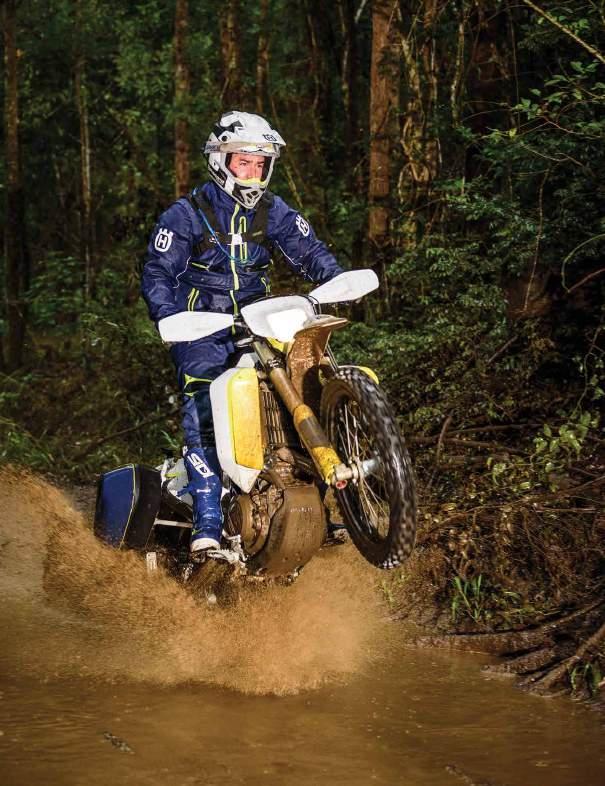
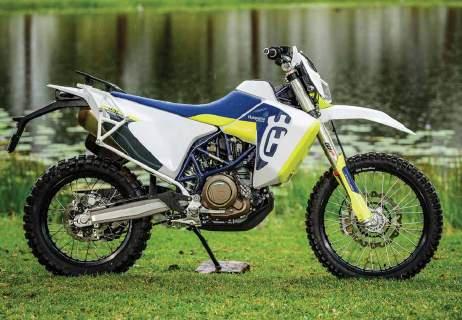
Web: www.husqvarnamotorcycles.com
Rec retail: $18,345 + ORC
Engine: Single-cylinder, liquid-cooled four-stroke
Capacity: 692.7cc
Power: 55kW
Bore x stroke: 105mm x 840mm
EMS: Keihin EMS with RBW, twin ignition
Starter: Electric
Lubrication: Forced lubrication with two oil pumps
Transmission: Six-speed
Clutch: APTC slipper clutch, hydraulically operated
Frame: Chromium-molybdenum-steel trellis frame, powder coated
Front suspension: WP-USD XPLOR 48
Rear suspension: WP XPLOR with Pro-Lever linkage
Front brake: Brembo twin-piston, floating-caliper, brake disc 300mm
Rear brake: Brembo single piston, floating caliper, brake disc 240mm
Suspension travel front/rear: 250mm/250mm
Seat height: 925mm
We weren’t rapt in the quickshifter, but we’re not convinced quickshifters offer much advantage outside of a road-race situation. It’s nice to have the option to be lazy and ignore the clutch, but the hydraulic clutch on this bike was a pleasure to use. If we went for a lazy change from fifth to sixth, we’d often end up in a neutral. If we made a strong definite change, no problem. The quickshifter encouraged us to be a little lazy, so it was half a trap.
Handling wasn’t as razor-edged or as precise as a 450, either. That might seem a strange comment, because no 700 single is going compete with a 450 in handling, but everything else about the bike is so good it came as a small surprise. Handling and steering are good, and the turning circle, like a lot of KTMs and Huskies, isn’t as tight as it might be. The bike’s easy to manhandle though, and we didn’t have any problems manoeuvring in tight places or around the shed. It just seems to hit the steering stops a fraction earlier than we expected.
The optional panniers and racks were a nice addition. The racks are strong and the panniers clip on and off which makes for supereasy packing and unpacking. Just spin the key in the lock, bump the soft-shell pannier up off the rack and head for the motel room. Both the locking mechanisms and the zips on the panniers became a little cantankerous after they’d been dragged through the wet sand, but a clean and some silicon spray soon had them working well again, and
Ground clearance: 270mm
Fuel capacity: Approximately 25 litres
Weight without fuel: 155kg
the supplied dry bags inside the well-designed panniers themselves kept all our gear in good shape. Capacity’s not huge, but we felt they were a very good option for the bits and pieces we wanted to get at quickly. They’re light and strong, and a roll-top dry bag across the rear guard could hold spare clothing and so forth.
There’s nothing we didn’t like about the Husqvarna 701 Enduro LR as far as riding and performance was concerned. More than that, we felt it’s a truly exceptional bike in just about every way.
The idea of a dirtbike-feeling single won’t appeal to everyone, especially the long-distance brigade, but the crisp, sharp performance of the bike in all conditions, and its clear love of an off-road challenge, will have it winning the hearts of many.
It certainly won ours.

Distributed in Australia by motorcycleadventure.com.au 1300 898 560
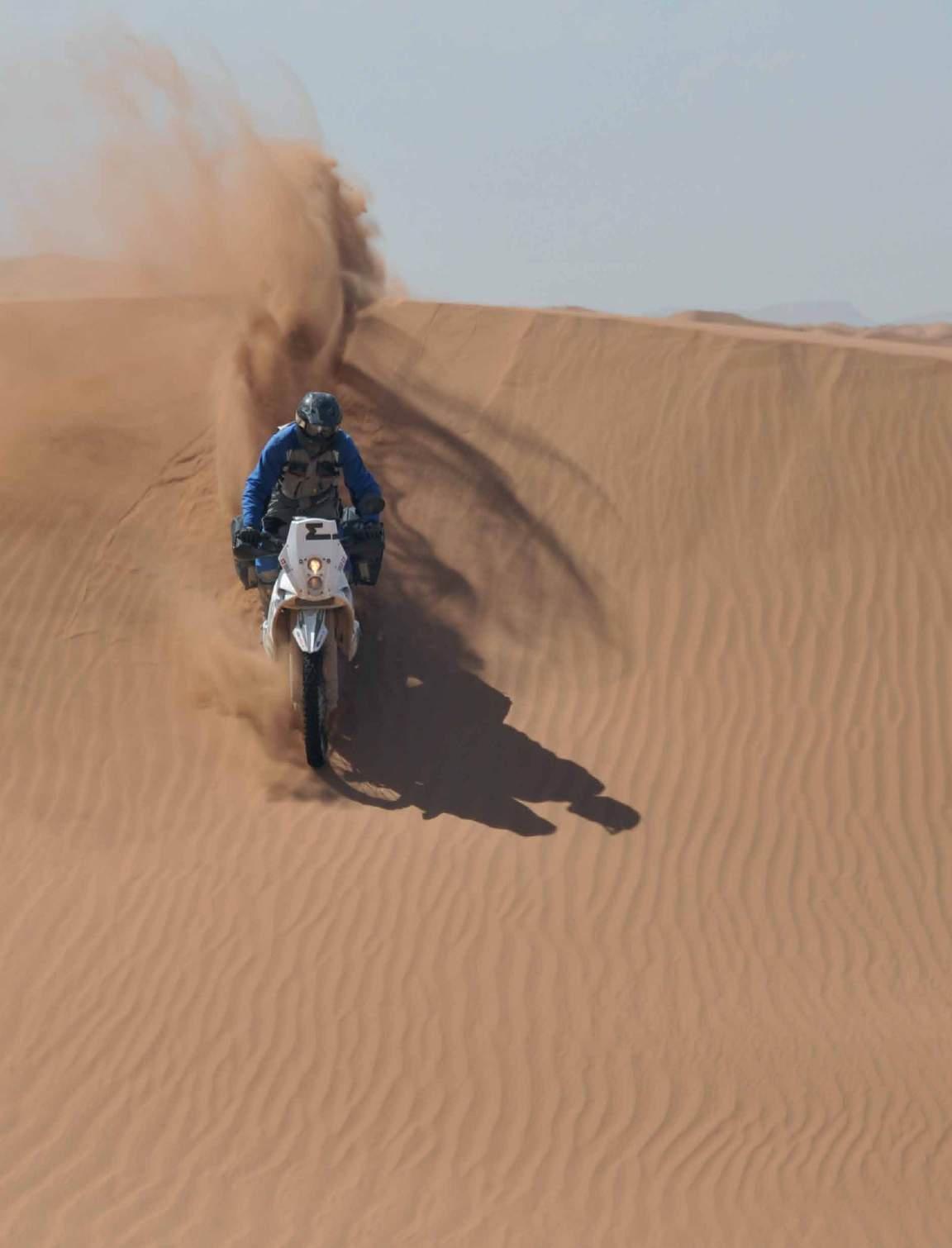
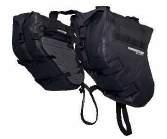
BLIZZARD

RALLY PACK
100% waterproof saddle bags. No rack, modular, 3 sizes available
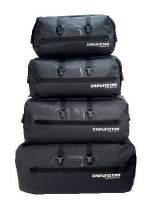
TORNADO 2
100% waterproof bag for the rear fender. Optimized for fast access
100% water, mud, snow and dustproof pack sacks. 4 sizes available
WHEREVER YOU RIDE…

PANNIER TOPPER
100% waterproof, 2 sizes available

HURRICANE
100% waterproof, 2 sizes available, hydration compatible
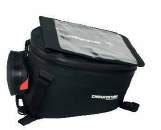
SANDSTORM 4
100% waterproof tank bag. Quick release buckles, 5 sizes available
Tough rides need even tougher luggage. Enduristan is enduro ready luggage made for adventures off the beaten track. ENDURISTAN.COM.AU

Jodie Box discovered a grain of truth behind an old joke on a pillion ride through Tasmania.
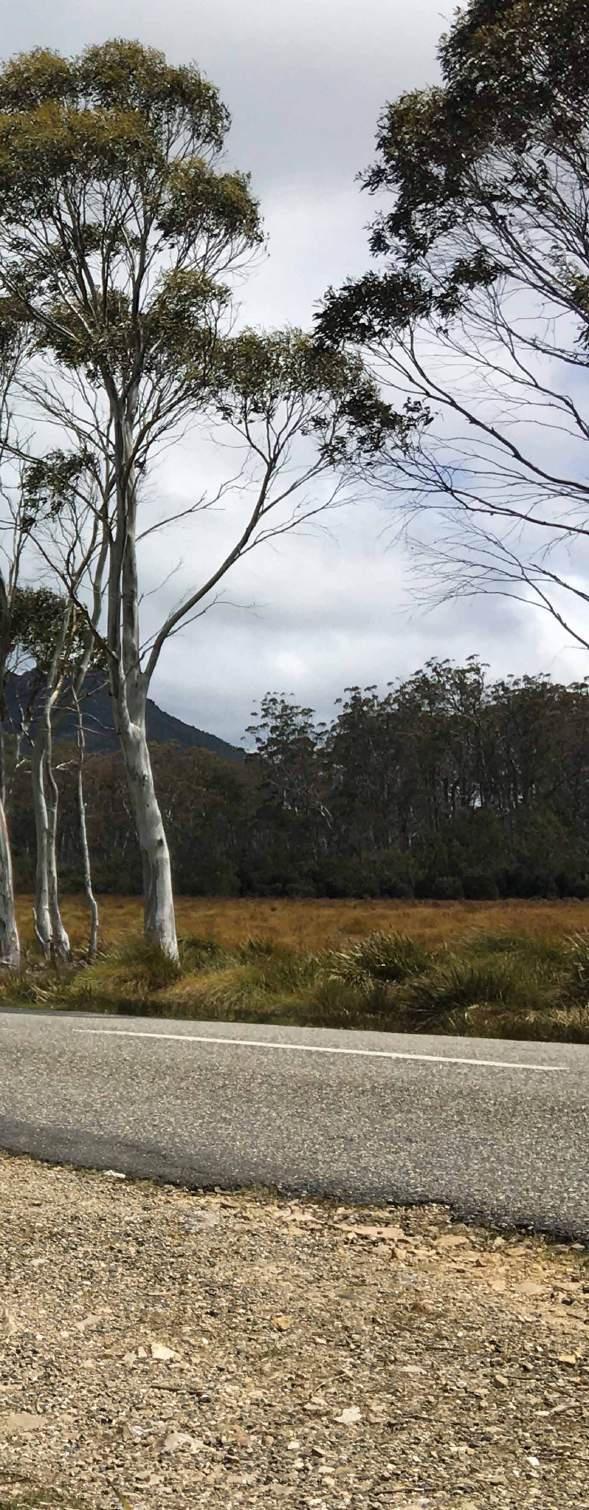
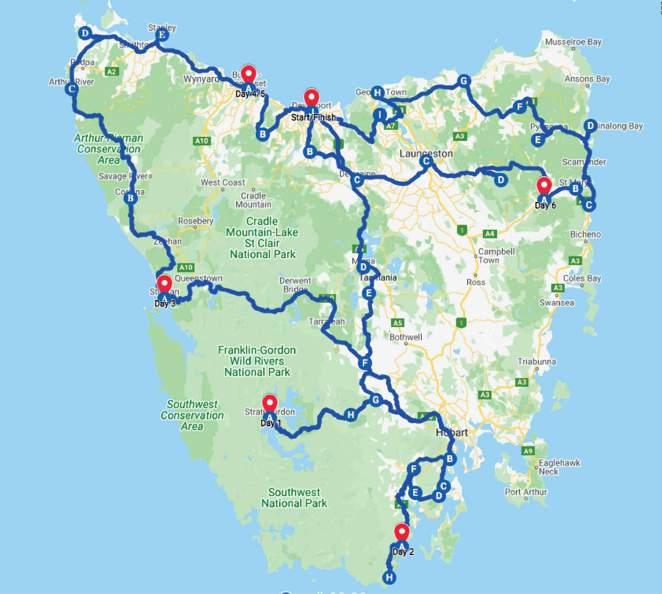
By 5.00am we were off the mighty Spirit Of Tasmania and on the open roads leading out of Devonport. Despite it being summer we were welcomed by heavy rain clouds that stayed hot on our heels for the whole day. Apparently Tasmania doesn’t care too much for what Victorians think the seasons should be.
It didn’t take long to realise the landscape of Tasmania changes with the blink of an eye. We rolled through rich, deep-red soil and found ourselves in marginal sheep-grazier country within the rise of a hill.
Heading south, toward the central highlands, we stumbled upon the Waddamana Hydro-Electric Power Station and museum. Hidden away along a dirt road, the grand old building was home to the first hydro station in the southern hemisphere, built back in the early 1900s. Run by volunteer staff, the plant is manned seven days a week and is well and truly worth a visit. Even if you’re not a hydro power aficionado, the sheer size of the old operation is quite a sight.
Nearing the end of the first day we trundled on to Lake Gordon.
If for some unearthly reason the mood strikes you, you’re able to abseil from the top of the Lake Gordon dam wall, which, at 140 metres high, is the tallest in Australia.
A stone’s throw from Lake Gordon was Lake Pedder, and there we called it a night after a final 100km in the rain.
Heading out of the bush and scrub and into Hobart, we popped into MONA (Museum of Old and New Art) for a quick visit which was, how do I put this…eye opening. I won’t say too much more about MONA except that if you think you know what an art gallery or a museum is, think again.
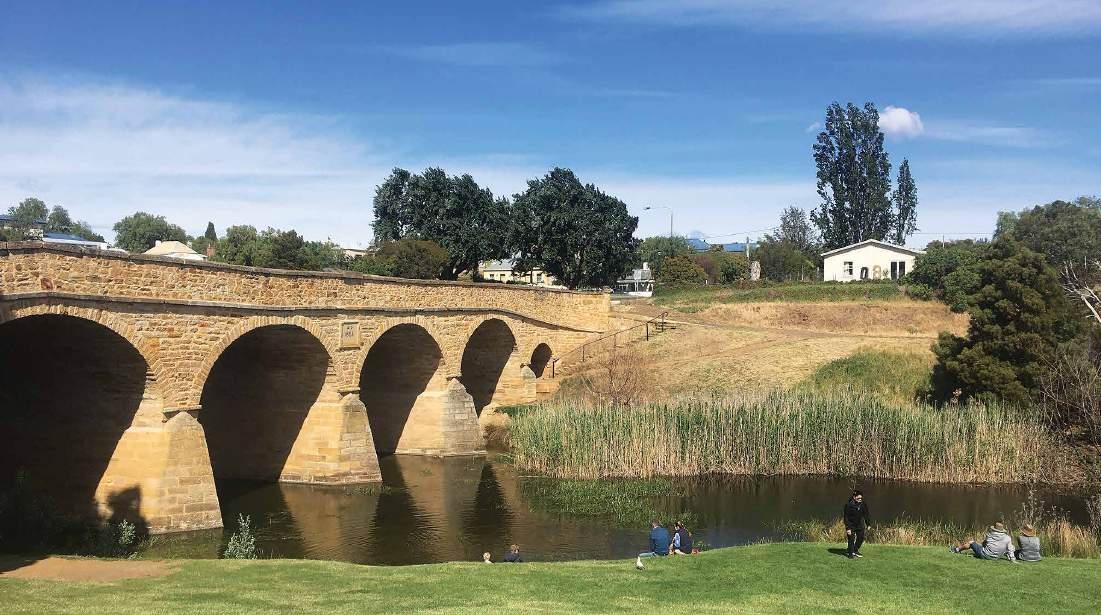
Oh. And the exhibitions start 13 metres below the entrance to the museum. All that culture worked up quite an appetite, so we stopped at Franklin for some well-earned fish and chips before motoring on toward Cockle Creek and the southernmost road in Australia. The end of the road leads to a brass sculpture of a southern right whale,
Top: The Richmond Bridge. Still in use some 200 years after it was built.
Below: Waddamana Hydro-Electric Power Station and museum. The grand old building was home to the first hydro station in the southern hemisphere.
Right: Even if you’re not a hydro power aficionado, the sheer size of the Waddamana operation is quite a sight.
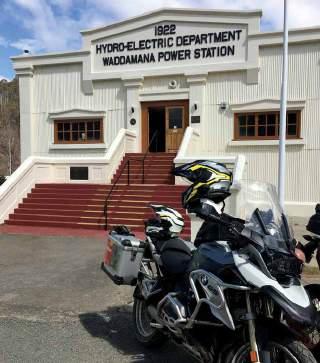
representing the whale-oil industry that developed Cockle Creek into a town during the 1800s. The pace of life down there is relaxed to say the least, well and truly reflected in a big old pet dog that wouldn’t even bat an eyelid – let alone leave the middle of the road – as the bikes passed. What a life.
Turning back toward the north and then west like some kind of disoriented rabbit zigzagging here and there, we started making our way down to Strahan. The route took us over the Richmond Bridge, the oldest stone-arch bridge in Australia. Construction started in 1823 to allow wheat growers to transport grain carts
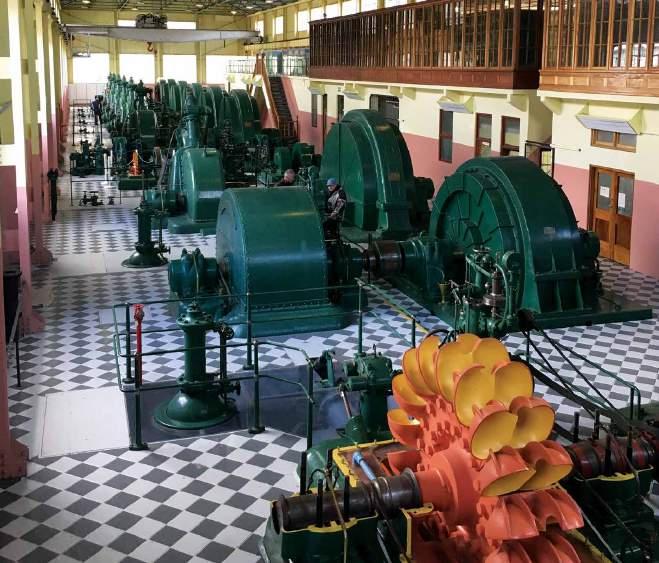
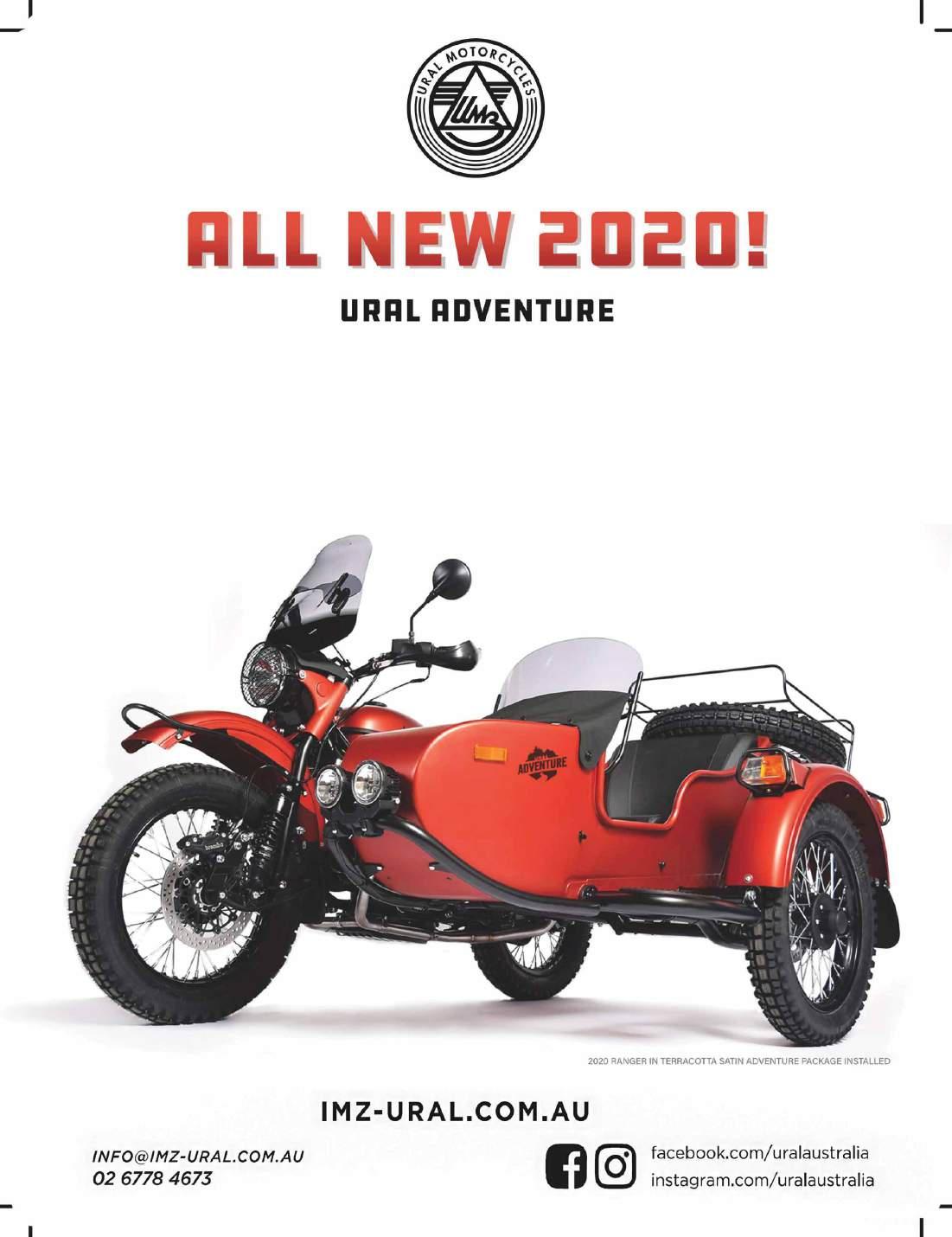

across the Coal River and it’s still in use today, with a 25-tonne load limit, some 200 years later.
Passing the hand-carved, 100-metrelong Wood Wall crafted from slabs of Huon pine that depicts the vast history of West Tasmania, and not far from the Derwent Bridge, tucked away behind a temperate little rainforest full of running streams, is Nelson Falls. It’s a lovely little retreat when the Tassie sun decides to come out and the riding suit is getting a touch warm.
Heading on toward Queenstown we were greeted with a white sign on the side of a mountain much like in Hollywood, although this was where the similarities between the two places quickly ended. Due to the extensive copper mining and logging during the early 1900s, what was once the world’s richest mining town is now a moonscape hill range. Coming down the hills through 90 or more bends and corners – yes. I counted – into town is quite surreal and
makes a stark a reminder of the town’s industrial history.
As the day drew to a close we rolled into the small coastal village of Strahan. Situated on the edge of Macquarie Harbour, the town is the entrance to the Franklin-Gordon Wild Rivers National Park, and also home to nearby Sarah Island, once a notorious convict prison.
As I’d learned was typical of Tasmania, we left Strahan in the pouring rain and made our way to the old silver-mining town of Zeehan.
Once upon a time Zeehan was the third-largest city in Tasmania, but it’s now a small rural town that, like many on the west coast, is reinventing itself into an historic landmark. It’s also a perfect spot to grab a cup of coffee before winding up to the remote village of Corinna.
Corinna was once a prosperous mining town and is now an eco-tourism destination complete with accommodation
and a lovely little pub. Getting across to Corinna means paying the ferryman –or remaining stuck on one side of the Pieman River while everyone else heads off for lunch.
A trundle down the Western Explorer Road took us across some dense forest and exposed plains that crossed the path of the Roaring 40s and had us leaning heavily into the gale-force wind. As well as being Australia’s largest dairy operation, Woolnorth is home to Tasmania’s first wind farm, which, after riding through the area, made a whole lot of sense.
The final stop before Burnie was Table Cape.
If you’re around the Table Cape area from the end of September to the end October you’ll be able to catch the Table Cape Tulip Farm in full bloom. The hectares and hectares of tulips fill the coastal paddocks and their bright flowers sit against the horizon of the Pacific Ocean. It was a picturesque way to finish the day.
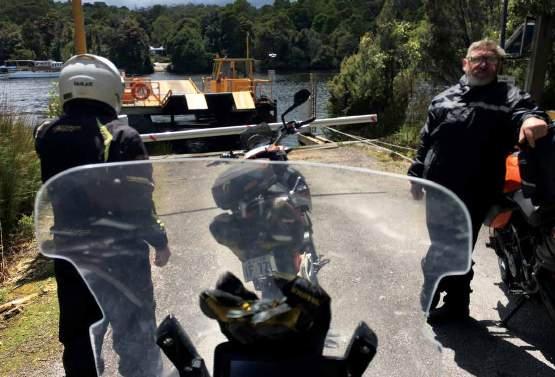
Left: Tasmania has too much to look at for one set of eyes.
Above: Getting to Corinna means paying the ferryman – or remaining stuck on one side of the Pieman River while everyone else heads off for lunch.
Below: A sign of experience at the Pieman River ferry.
Although it was only a relatively short day of 350km, the trip between Burnie and Fingal was full of sights which deserved a really good look, and top of the list were the Gunns Plains Caves.
Just south of Burnie, the caves are simply spectacular. They were formed by an underground stream that still flows today, and is home to giant freshwater lobster, fish, eel and occasionally even a platypus. Tours are available through the spectacular caverns, and a place so unique deserves an expert guide.
u
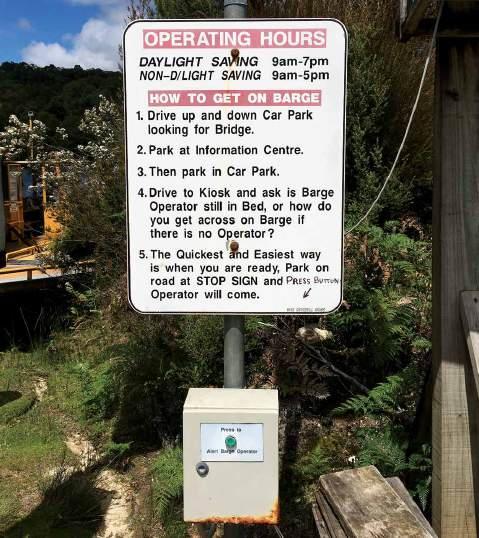

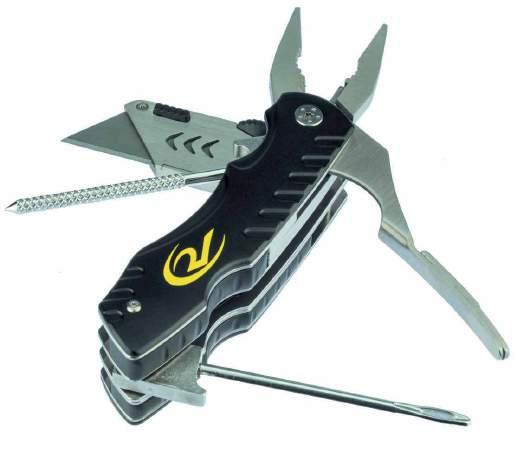



Pliers, rasp, needle insertion tool, knife and 5 pre-glued plugs, all in a handy pouch.
1 Remove offending item from your tyre.
2 Use the rasp to clean out the hole.
3 Thread needle with plug, push into the hole, twist 1 ½ times before pulling out.
4 Separate the knife from tool and cut the plug flush with the tyre.
The knife slides off the tool to easily cut the plug.

For further information on this and all our products, please check our website for details.
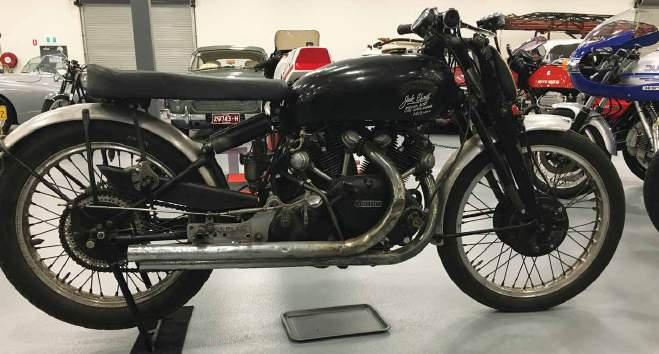
Once in Launceston we headed straight for the National Automobile Museum of Tasmania.
For me a motor museum wouldn’t usually be my first port of call, but the impressive presentation and sheer number of cars and bikes on display meant there was something to pique everyone’s interest. The impressive line up showcased everything from Australian muscle cars to a 1951 Vincent Black Lightning, the most expensive motorcycle to ever sell at auction, going for a cool $1.16million.
We wound our way up to the plateau of the Ben Lomond National Park, seemingly sitting above the clouds at 1500 metres. The weather changeability that was so common throughout Tasmania was heavily amplified at the Jacobs Ladder lookout. What was sunshine when we arrived quickly turned to fog and rain as the change of weather could be seen enveloping the entirety of the mountain peak in a matter of seconds. And getting to the lookout via Jacobs Ladder is a feat in itself. Its tight, gravel hairpins kept everyone on their toes. Each corner is skirted by piles of dolerite rocks that have fallen and created boulder fields at the bottom of the mountain, and my advice as a passenger is don’t look down until you are safely to the top!
Riding back down from the peak of the Ben Lomond National Park revealed a vast range of wildlife going about its business. The most common appeared to be the echidna that, based on the number we saw, may outnumber people in Tasmania.
As the sunlight began to fade behind the mountain ranges we made our way to the
Started by two mainlanders, Darren and Louise, after a lap or two around Tassie while on holiday, the accommodation is set up with motorcyclists in mind. Beloved steeds can rest safely in a garage all night while riders catch some much-needed rest.
Possibly the most needed thing at the end of a day on the bike is a nice, home-cooked meal, and if you swing by Chelle’s Place in Fingal that’s exactly what you’ll get – and in a big way. It’s possibly the first time in my life I’ve been scared of the amount of food I was going to have on my plate as I saw the sheer size of meals.
My fear both peaked and subsided as I was presented with a burger not only nearing the size of my head, but which was also absolutely delicious.
The last day on the island was filled with blue skies and plenty of open road to guzzle up before getting to Devonport that night to set sail back to Victoria. The first lot of winding roads down through St. Marys warmed up both riders and tyres for the final day ahead. We travelled along the east coast to picturesque Binalong Bay, paying a visit to the Bay of Fires.
St Columba Falls in the rural region of Pyengana was a must-see and wasn’t situated too far off the Tasman Highway. The falls are hidden away through dense, towering tree ferns and trickling steams, and the waterfall itself, at 90 metres, is one of the highest in Tasmania. St Columba Falls hasn’t been seen without water flowing over its rock ledges since its discovery.

Top left: The impressive presentation at the National Automobile Museum of Tasmania included a 1951 Vincent Black Lightning, the most expensive motorcycle to ever sell at auction.
Above: Chelle’s Place in Fingal presented a burger nearing the size of the author’s head, but which was also absolutely delicious.
Below: Low Head Lighthouse, rebuilt in 1888 and the country’s oldest continuously operated pilot station.
Right: St Columba Falls in the rural region of Pyengana was a must-see and wasn’t situated too far off the Tasman Highway.
The final stop before boarding the Spirit Of Tasmania was Low Head Lighthouse. The original lighthouse was built in 1833 and, at the time, was Australia’s third. The structure which sits there today was rebuilt in 1888 and is the country’s oldest continuously operated pilot station. Often little visitors to the Low Head Lighthouse can be seen coming
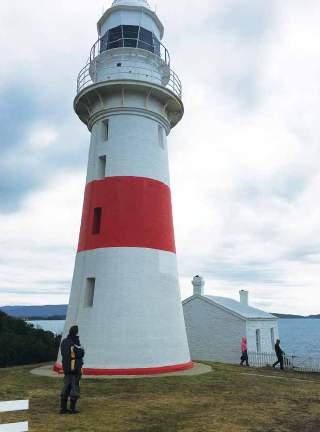

up from the shore or hiding among the shrubbery during breeding season. The little locals are the Blue Penguins or Little Penguins that make their way from the shores to build nests and lay eggs in the area surrounding the lighthouse.
There’s an old myth about our Apple Isle counterparts having two heads. It’s not always well received, but I’ve found since visiting Tassie as a pillion that there may well be an evolutionary explanation: there’s too much to look at for one set of eyes. If you truly want to discover the Island State for all it has to offer I can recommend two options:
* Grow a second head (this takes considerable time and effort and is not recommended); or
* DIY a second head by taking a pillion passenger (highly recommended).
With the second option you’ll begin to get a true view of everything Tassie has to offer.
Take my word for it. Tassie definitely deserves a second pair of eyes.


facebook.com/andy.strapz
Honda
Kawasaki
Versys
Suzuki
Triumph
Tiger
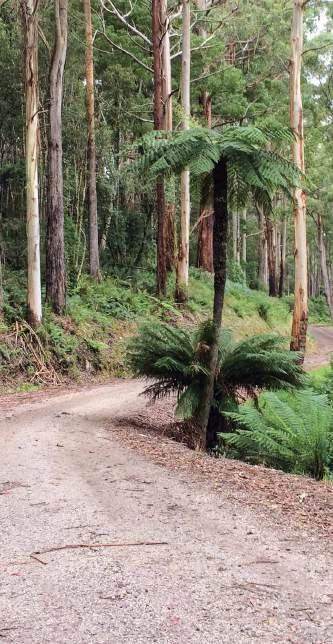
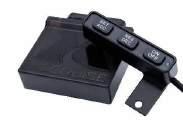
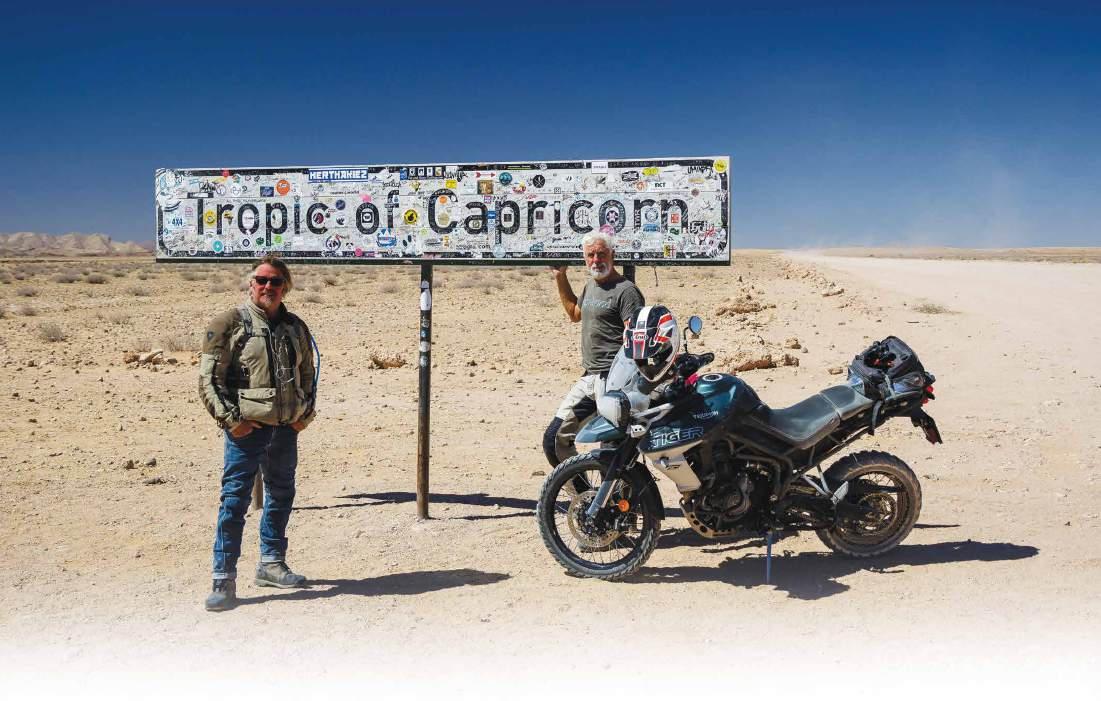
Any time Charley Boorman is around you can bet Billy ‘Biketruck’ Ward isn’t far away. But Ward has a strong adventure pedigree of his own
and is as friendly and happy a character as any rider could hope to meet in a
country pub. Graeme Sedgwick has first-hand experience.
“I
’d take bikes from the UK, Ireland and Scotland, put them in a truck and take them down to north Africa. Customers would fly into Malaga and take the ferry across, pick up their bike and have their adventure,” said Billy Ward with his usual intense stare. “That’s how I got into the industry.”
Ward was spending his time that way when an innocuous ad caught his eye. The ad suggested he listen to a guy who’d done an adventure ride with others, but when he arrived he wasn’t impressed. He couldn’t see or hear much, so when things paused he persuaded the venue’s catering staff to get the guy a table to stand on and allow him to use their megaphone. Having waited until most of the crowd had dispersed to directly express his disappointment, he, at the same time, offered his mobile number and told the speaker – Charley Boorman – his presentation was ‘shite’.
Months later Billy, out of the blue, received an invitation to meet Boorman and Long Way Round director/producer Rus Malcom. Ward remembers the meeting as a tedious battle of wits and questions, with each individual keen to gain the upper hand.
Above: Billy Ward ended up Boorman’s manager and accompanied him on rides around the world. Below: One of Ward’s most interesting rides was to Iraq with cameraman and documentary maker Claudio von Planta (left).


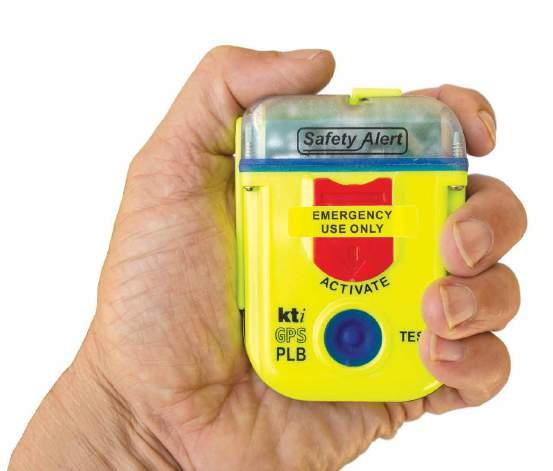

Above: Always looking after a client, even during breakfast.
Below: Billy’s love of Africa and adventure riding offered some big possibilities.
Right: A registered African Field Guide, able to lead motorcycle adventurers into and through localities sometimes tricky to access without the right accreditation.
But the dynamic changed suddenly, and for the better, each time Malcolm answered his mobile and left Boorman and Ward to chat between themselves. As Malcolm’s phone rang yet again Boorman ushered Ward out and Billy seized his moment, propositioning Charley with a talk-show challenge and consummating the deal with a handshake followed by an immediate and polite departure.
Billy walked away believing he had a chance at possibly solving his employment dilemma and the rest is history. Billy Ward ended up Boorman’s manager.
Ward’s work was originally calculating risk strategy for a very large company. The work required a great deal of travel and

he was keen for that to continue. The idea of becoming a guide and roaming one of the world’s wildest landscapes captured his curiosity so he did something about it. He’s now a registered African Field Guide, able to lead motorcycle adventurers into and through localities sometimes tricky to access without the right accreditation. Billy’s connection with Boorman, and Boorman’s love of Africa and adventure riding, offered some big possibilities which have developed into the enormously successful African tours which are so popular today.
Ward is a true motorcyclist.
“I love riding almost any sort of motorcycle because they all offer something special,” he thumped. “Like the Harley Davidson I was recently charging around Tasmania on – kidding myself I was as good as those I was riding with.
“But it’s hard to beat the immersion adventure riding offers. Destinations and crazy places wrapped with amazing stories are all part of the very reason I like riding adventure bikes in places like Morocco, South Africa and coming to Australia and being involved in Compass Expedition’s local adventure rides,” he explained, obviously before Compass had had to call it a day.
Ward also leads rides from South Africa or Zimbabwe travelling through Botswana or Namibia.
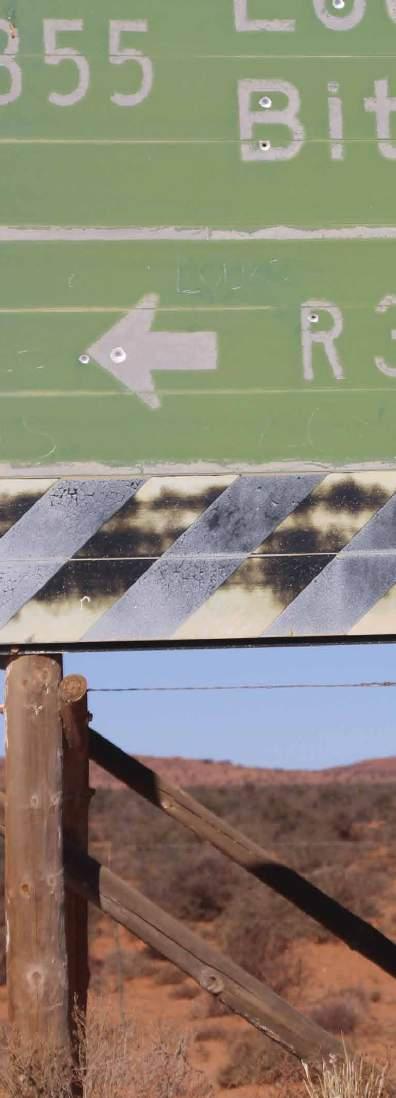
One of Ward’s most interesting rides was to Iraq with cameraman and documentary maker Claudio von Planta.
“I’m not sure who was the most courageous…Claudio, myself or both of us,” said Ward, looking a little bemused. “There were plenty of moments, many of them a by-product of Claudio’s ambitions to capture the best possible imagery he could.
“He travelled with the best kit, including a high-grade military drone.
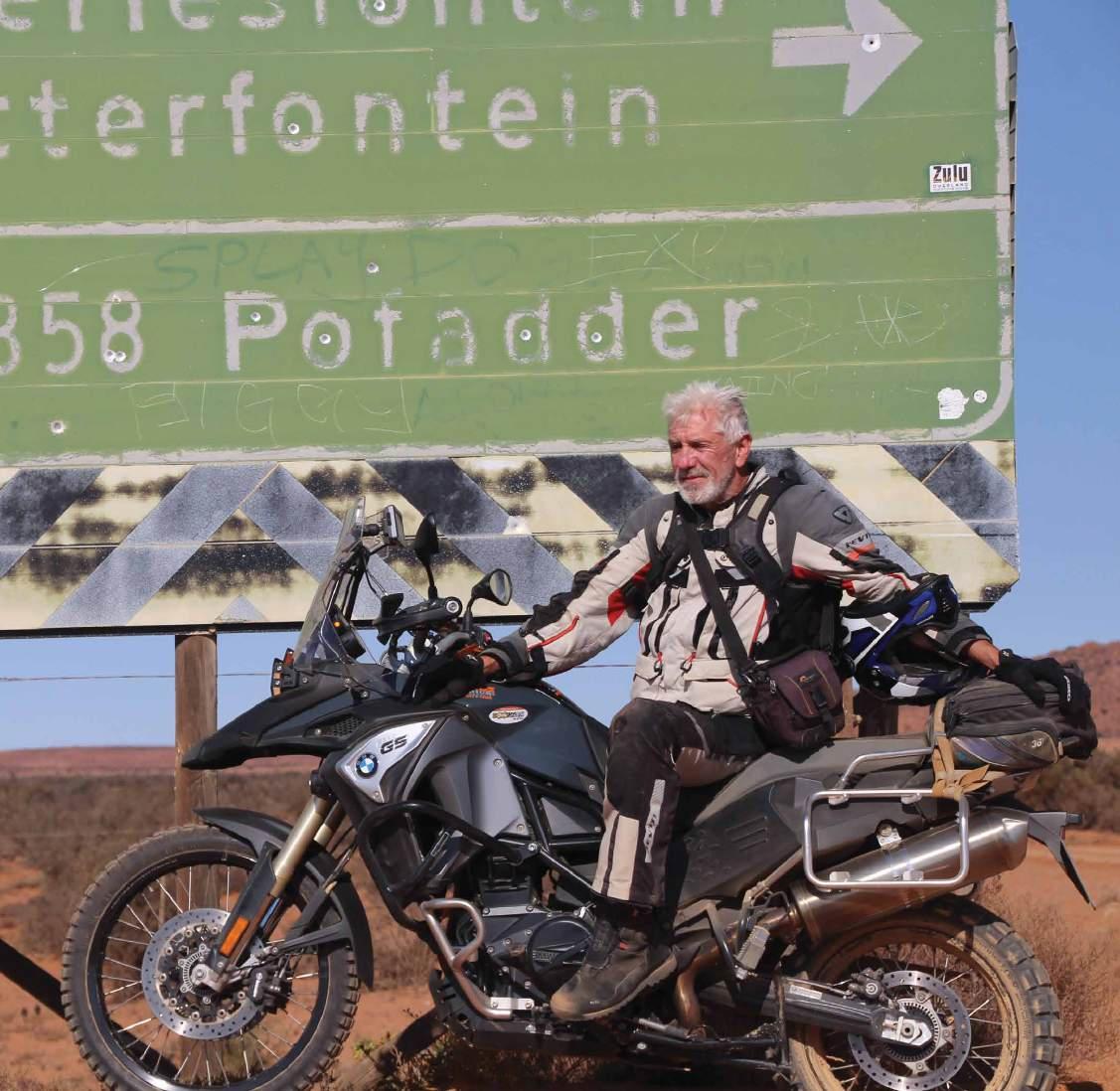
It was no surprise it caught the attention of Iraq Security big time. But somehow he/we managed to convince all those surrounding and challenging our motives we were well-intended.”
“Then there was the plan to hire a couple of adventure bikes. It turned out the best we could come up with was a couple of 125s which, no surprise, weren’t going to cut it. We ended up having to explain our good intentions again, this time to the head of an Iraqi police operation. He decided after
some very lengthy consultation and reflection our aim to ‘create some positive storytelling about life for the people of this ancient and important part of the world caught between the crosshairs of unrelenting unrest and effect of US intervention and withdrawal’ wasn’t necessarily such a bad idea.”
Thankfully the police bigwig eventually decided he’d organise the loan of police motorcycles for the pair to ride to Iraq’s Mosul frontline, which at the time was
surrounded by military of one type or another with coalition jets above.
The amazing situation left Ward wondering what on Earth was he doing there, in the midst of it all. But now on reflection, with the documentary concept before Sky television, a wideeyed Billy explained, “I was totally amazed by the adventure’s countless life-changing moments and how wonderfully good and bad people can be.”
That’s adventure at its best.


After an unbroken run of over two decades BMW Motorrad’s GS Safari was finally stopped in its tracks. The challenge for the organisers was immense. With everything balanced on a knife’s edge as we write this, the event is poised for a restart in September.
There wouldn’t be too many Australian adventure riders on any brand of bike who don’t know of the BMW GS Safari. It kicked off in 1994 with a ride from Sydney to Fraser Island and has become the standard for other manufacturer rides to measure up to. The service and support provided to riders is astonishing and the terrain and destinations are always awesome.
The huge success of the GS Safari has led to BMW Motorrad hosting similar rides for the road riders and more hard-core adventurers, and it’s not unusual for any of the BMW Safaris to sell out in less than 24 hours. Typically, that means up to 250 riders serviced by up to 20 BMW staff. It’s a hell of a logistical feat, and Adventure Rider Magazine has been lucky enough to ride several
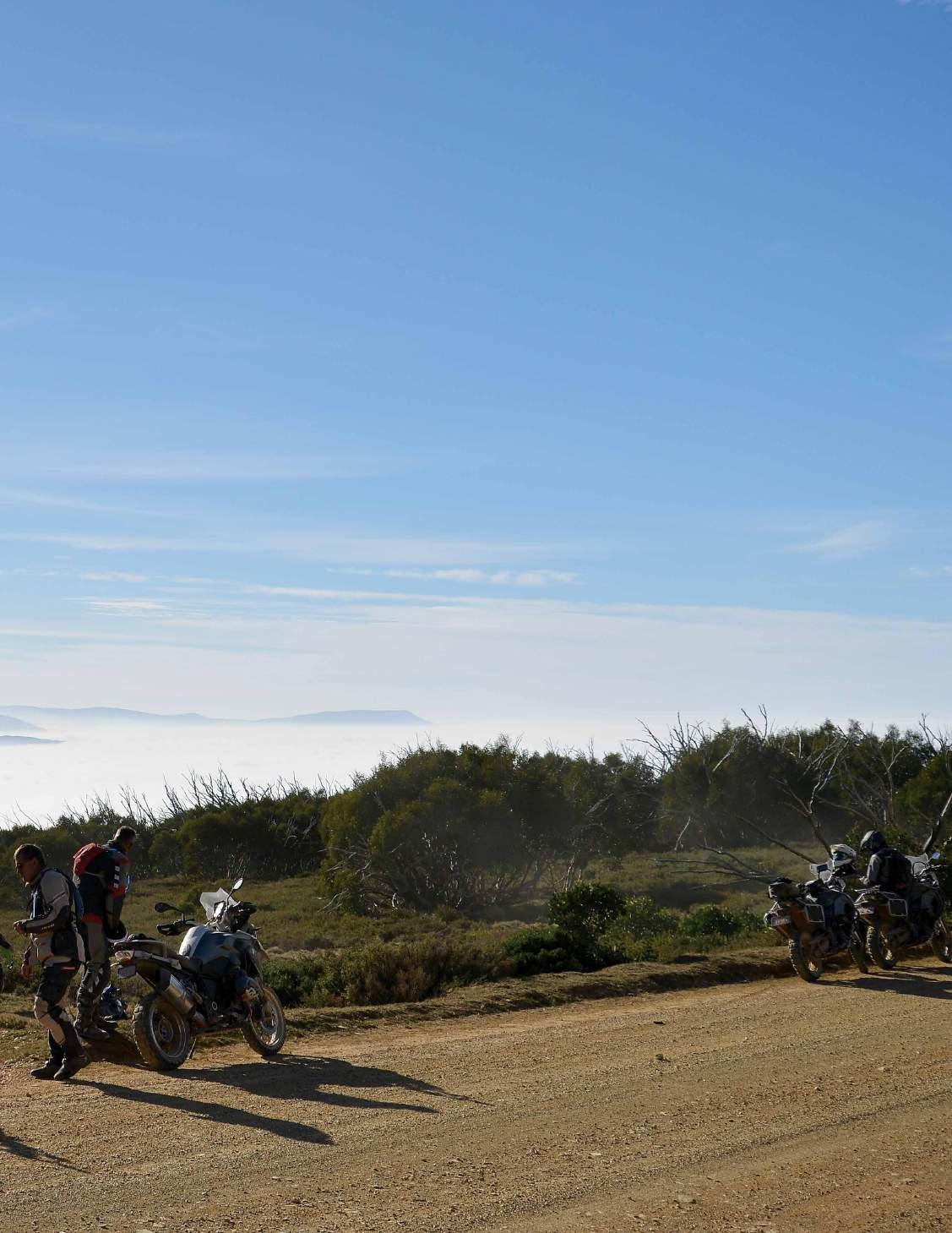
events over the years, and the precision and attention to detail in the planning and execution of every one of them has been astonishing.
But 2020’s brought a lot of things to a grinding halt, including this customerfocussed adventure-riding juggernaut.
Organisers Shane Booth and Chris Urquhart of Moto Development have had to deal with some serious setbacks, but, like true adventure riders, they’ve held tight to the ’bars, kept everything upright while they regained control, and are ready to get going again.
It wasn’t easy.
“It was our second year of running GS and TS Safaris.” Said Urky.
“We’ve been running BMW Off Road Training since 2013, so we had a feel for the riders and were ready to rock and roll for the 2020 GS Safari from Phillip Island in Victoria to the
u


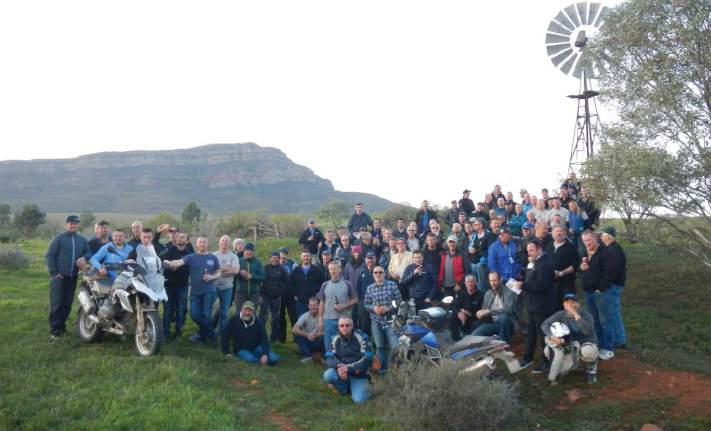
“We’d done three recces and mapped everything out. Everything had been designed and all the printing had been done for the riders. All customer and crew bikes were booked on freight and a lot of bikes were in Melbourne ready to roll. We’d booked all our flights and all the hotels for the 240 riders and staff had been paid deposits. We were literally ready to hit the go button for the event.
“Then, within a matter of days, the COVID lockdown came around.”
Organisers went from full throttle on the rev limiter to bogged at a dead stop.
“It was almost panic stations,” Chris remembered. “We had the hotels calling to say we couldn’t come and customers ringing and wondering where their bikes were and what the situation was…all that sort of stuff.”
Of course, the boys themselves, and Moto Development logistics guru Anthea Verdoorn, didn’t know what was going on at that time. No-one did.
After a couple of weeks of what Chris described as ‘scurrying around’ the pin was pulled on the March event completely and everyone began looking
The GS Safari – along with its sister event for road bikes, the TS Safari – is unique to Australia. Other countries have BMW-branded events, but the GS Safari only happens here.
The event started in 1994 when the German manager at the time decided to run a customer ride and came up with the idea. It started from Pyrmont Bridge in Sydney and had a police
for a postponement date.
Right now Moto Development is back on the front foot and aiming at September 13 to 18.
“We’ve been working flat out in the background during the lockdown,” said Chris eagerly. “We had a lot of cleaning up and a lot of loose ends to tie up, and then a complete reschedule.
“Leading into a Safari is a three- or four-month build up getting all the dots to align so the event runs smoothly. For us it was basically hitting the reset button on that. We had to feel our way through a lot of unknowns. At the same time we had to reschedule our BMW Off Road Training calendar. We’d had 25 events booked nationwide at the same time as the Safaris, so we had to postpone and move and change all of those as well.”
So thanks to Moto Development never giving up and BMW Motorrad Australia maintaining its commitment, the 2020 GS Safari is back in the starting gate and ready to roost.
The gate drops on September 13 at Phillip Island.
escort out of the city.
Adventure Rider Magazine on Safari and Safari Enduro

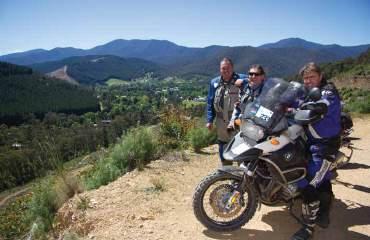





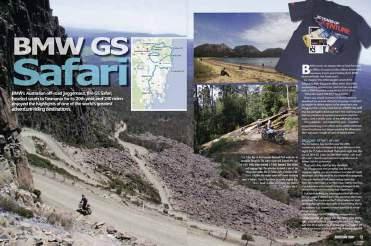



Since that first GS Safari it’s grown consistently, year after year, to become a centrepiece for the Australian motorcycle division of BMW and spurned sister rides like the GS Safari Enduro and the TS Safari. All three rides sell out quickly and all three embrace the same philosophies of safety, fabulous routes and locations, and a premium customer experience.
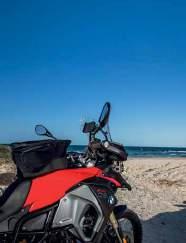


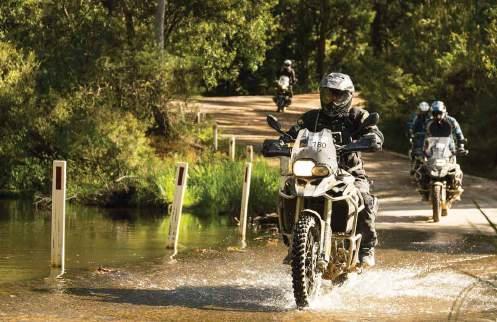

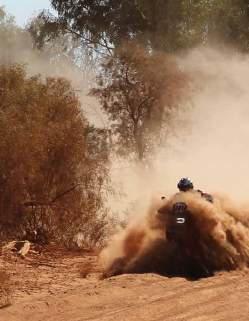
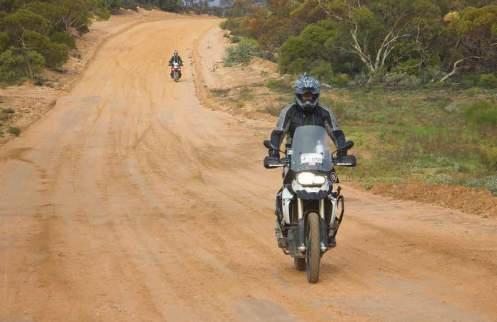
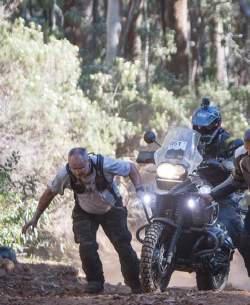





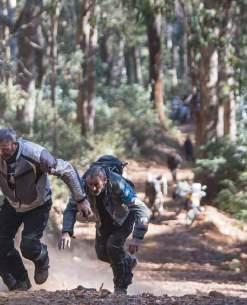




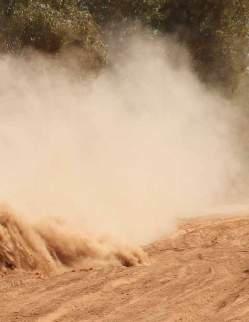




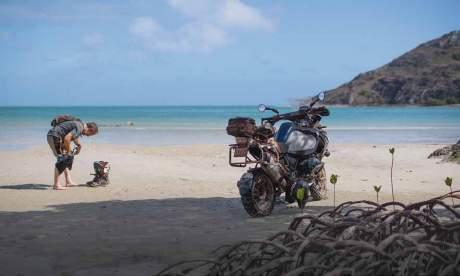

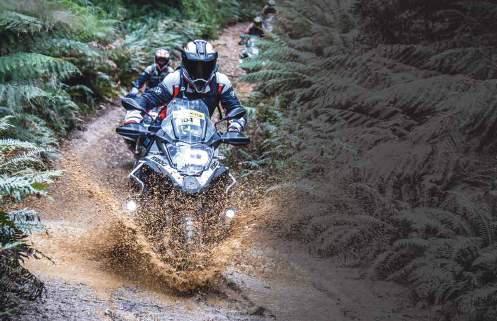





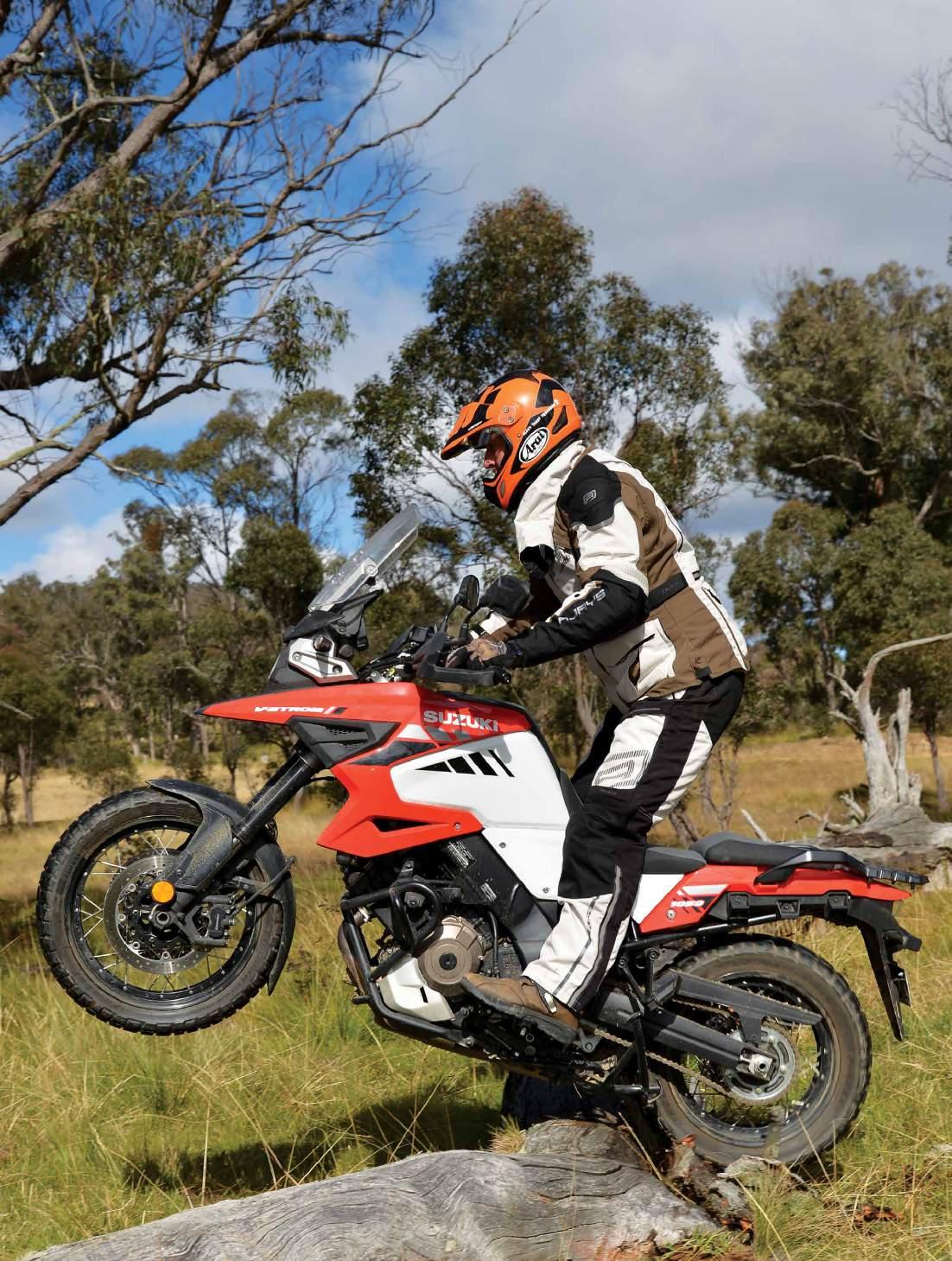
The good ol’ V-Strom is the Swiss army knife of dualsporters. It’s incredibly versatile, but for 2020 Suzuki has sharpened its edge and added a couple of very nice features.
Suzuki’s V-Strom has been a winner since its release in 2002. Not everyone’s seen it that way, but those who’ve taken the trouble to discover what the ’Stroms can do have usually ended up firm fans.
That’s us.
Once we discovered just how damn good the DLs were – we don’t think they’re called ‘DL’ any more, but they were when we first rode them – we never hesitated. If there was long distance or tough terrain to be dealt with, we backed the V-Strom to do the business, no matter what.
In 2017 the XT – XT for ‘cross tourer’ – 1000 and 650 were released in the sexy yellow colour and we raged around the Bloomfield Track in FNQ and came away more impressed than ever.
For 2020 there’s now the 1050XT, and while the colour scheme’s new, and there’s been some upgraded tech, the heart and soul of ’Strom is as big and strong as it’s always been.
Let’s get straight to it: the biggest differences between the previous 1000XT and this new bike are:
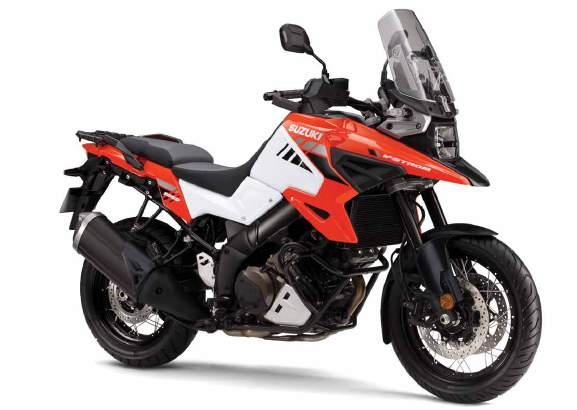
v A suite of electronic rider aids including cruise control (yay!)
v A gruntier motor at low revs (sort of yay. The old motor was a good one, but this one’s a snorter)
v Some new colours (yay), and
v An instrument display so frigging busy we didn’t know where to look on the damn thing.
They’re the highlights.
The bike is still a super-comfortable tourer with plenty of poke and great handling manners, is still well capable of covering dirt roads at a brisk pace and, if the rider gives the bike just a little leeway, will still pick its way through some surprisingly technical and challenging terrain.
There’s a bit more to the newest ’Strom than that of course, but they’re the things which we felt most.
u
Left: The ’Strom’s nearly 250kg was surprisingly manageable off road. Below: The heart and soul of the ’Strom is as big and strong as it’s always been. We felt the motor had more low-down grunt, but Suzuki’s graph supplied with the media briefing shows that not the case. We’ll go with what we felt. We reckon it’s stronger at low revs than last year’s motor.
Above and below:
The 2020 colours for the XT: Pearl brilliant white/ Glass Blaze orange, Champion yellow, Glass Sparkle black.
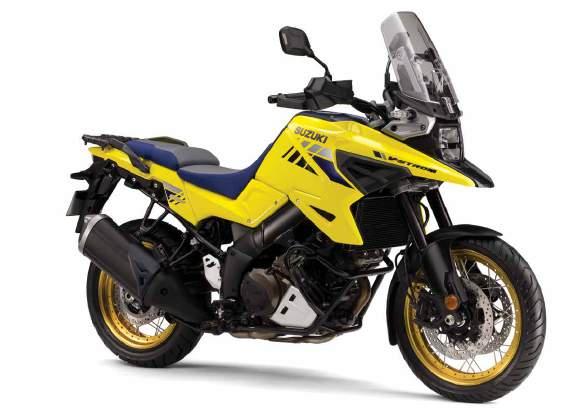
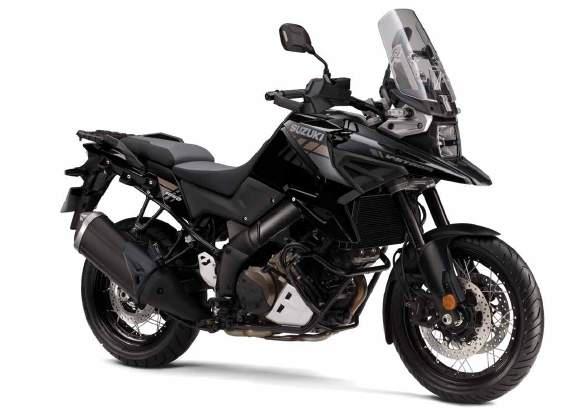
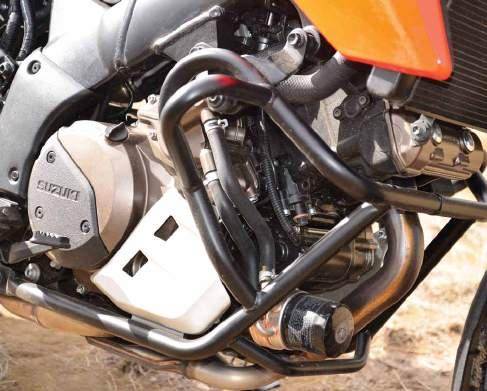

The spec sheet on the motor, clutch and gearbox reads pretty much the same as last year’s bike. Subtle changes include increasing the lift on both camshafts, setting the timing with less overlap and increasing the throttle-body bore size from 45mm to 49mm, resulting in increased peak power. Otherwise the liquid-cooled, 1037cc V-twin four-stroke is basically the same, but Euro 5 compliant for 2020. Fuel consumption is claimed to be the same as well – around 20km per litre – and the assisted hydraulic clutch is a slipper.
Cruise control is a very welcome addition, as is the ride-by-wire throttle set up. The new slope- and load-dependent systems, along with the combined braking system and ‘motion track’ braking, make for safer riding and we’re all for that. Traction control has three modes plus off, while ABS – one of the best ABS we’ve used –
has two settings. In one of those embarrassing moments we’re getting used to, we couldn’t get the ABS setting to change no matter what we did. We were running through the functions of the bike with photo rider Matthew ‘Pottsy’ Potts – himself a V-Strom owner and one of those people with an engineering turn of mind – and he held down the lower button of the cruise control rocker and the cow of a thing changed straight away.
So that’s how that’s done.
An IMU does what IMUs do. Monitoring bike pitch, yaw and speed it controls the traction control and braking systems to ensure they can do their jobs when the ’Strom’s cranked over or off level. That includes ensuring the rear wheel doesn’t get airborne on downhill braking and adjusting traction control and ABS for the load of a pillion or luggage.
The new 1050XT isn’t giving away a whole lot to the competition in the tech department, that’s for sure. But still,
the V-Strom philosophy of simplicity is still there. The rider can’t fine tune the settings through hundreds of different variations or menu pages. It’s essentially WYSIWYG – what you see is what you get. The systems are mostly automatic, and where they can be adjusted by the rider the options are fairly limited.
We don’t think that’s a bad thing.
We really liked the new colours. That’ll be very much a personal judgement, but the Champion yellow keeps with Suzuki’s off-road colour scheme, the Pearl brilliant white/Glass Blaze orange combo – like our test bike – brought back memories of the DR Big and some of Suzuki’s rallye-racing exploits of the 1980s and early ’90s, and the Glass Sparkle black…well… that didn’t do much for us. It’s a bit Darth Vadery. Maybe if we’re being generous we could say it’s ‘stealth’.
Whatever floats your boat. If you like it, you go for it.

Above: There’s plenty of information

The seating position is very relaxed and can be adjusted 20mm higher for long-legged riders, while the ’bars sweep back just a little, and that makes for a really comfy, lazy posture. Standing up was no problem – we removed the rubber inserts from the footpegs – but the seating was so comfortable we started asking ourselves whether we really needed to stand. The more comfortable we became, the more we decided we could hack most of what was going on from the seated position.
Call us lazy if you insist, but…okay. We were lazy. It’s the bike’s fault. It encourages the rider to enjoy the comfort.
We’ve left this a little late, but what’s it like to ride?
Smooth, grunty without being scary, and very comfortable. With the traction control off we got all playful on the dirt roads and swished the back end around a little. It was a lot of fun because power delivery is strong but predictable. When we were being sensible we were in awe of how well the ABS and traction control both did their jobs. The common perception of V-Stroms being a bit of a ‘cheap-o’ choice is given the lie by how good those systems were on the previous model and still are on this model. For the first time on a ’Strom we get a choice of three power-delivery modes, A, B and C. Peak horsepower is the same in all three, but with varied response and low-end torque being slightly reduced in B and C mode. Mode A gives a sharpish throttle response which we found a little grabby at low speed, B is less aggressive and C has a lazyish action.
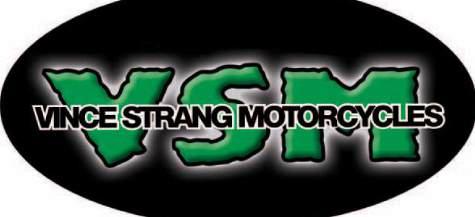

Vince Strang Motorcycles is the place for all DR650 advice and gear-up parts. That’s why VSM is also the best place to buy your fully prepped adventure DR650. We have the experience and knowledge and we have the catalogue of parts. Ride in with a stock DR, ride away totally fitted-out. Discuss requirements with Vince and VSM will supply your built-to-spec DR. Station bike, city commuter or full-blown acrossAustralia adventure bike, get the lot – or anything in between – at VSM. Shop ONLINE for our huge range of DR650 parts and accessories www.vsm.net.au
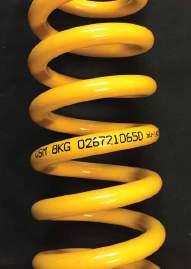
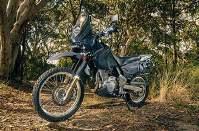
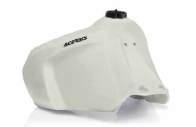
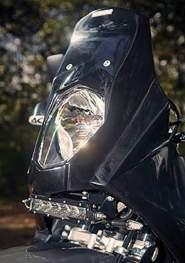
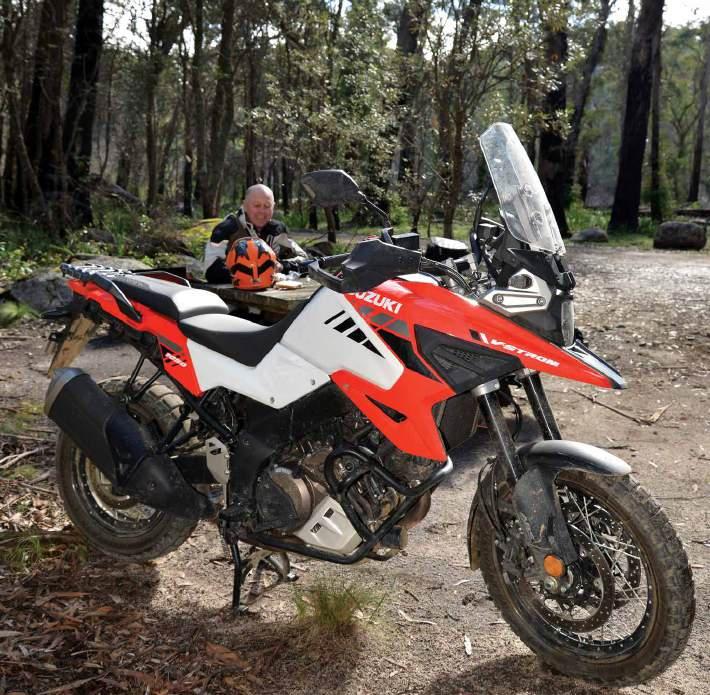
Top: In its natural habitat: a campground somewhere a long way from anywhere, with a beaming, happy rider nearby.
Below left: Both switchblocks were simple and uncluttered. The cruise-control rocker doubles for scrolling through modes and making selections.
Below middle: Rear preload adjustment. When we were riding that meant the bike had two big knobs.
Below right: The rack and grab handles made a good combo. It was easy to tie things down.
And we have to say, there’s nothing budget about the finish, features or paintwork of the bike. Our XT had cruise control, crash bars, tubeless tyres front and rear – Suzuki had fitted Pirelli Scorpion STRs in place of the standard Bridgestone Battlaxs – adjustable suspension, hill-hold, the three ‘drive’ modes, a jabillion possible readouts on the LCD display and very nice paintwork. An LCD instrument display is certainly far less expensive than a

TFT screen, and there’s no arguing a TFT screen is easier on the eye, but this screen did the job once we became used to it.
On the road the bike put no effort we could discern into speeds around the 150kph and 160kph mark, and had plenty on offer when we asked for more. We don’t just mean the engine, the whole bike was remarkably stable and easy to ride at those speeds, even swooping through choppy corners where we were
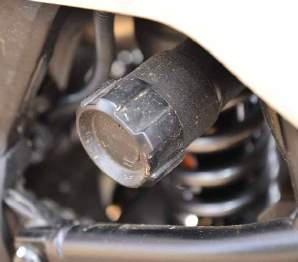
expecting to have to hold on tight. Off road its nearly 250kg was surprisingly manageable. It’s still a litreclass motorcycle, but gee, it sure does feel good to push hard on the throttle through a loose turn.
We’ve already said the ABS and traction control are exceptional. Both work well and are very smooth in their intervention. It would be nice to have the option to turn off the ABS for steep hills off-road, and we can’t help but feel that would be a problem for us at some stage if we owned the bike. Still, we expect most V-Strom owners would probably never find themselves confronted with that type of terrain. And if they did find that oncein-a-lifetime problem, they could always dismount, kill the engine, and bulldog the bike down like we used to in the good ol’ days.
Remember how much fun that was?
The bike threatening to club you around the ears while you both slid down some shitty, greasy, mile-long near-vertical slope with zero traction and a load in your pants?
Good times.
The two levels of ABS were clear enough. We can’t remember which was which, but one was noticeably less aggressive than the other. It’s plain as day while riding.
We’ve already mentioned the LCD display, and it’s one of the very few things on the 1050XT we weren’t keen on. Maybe it was the only thing.
There’s plenty of information on display, and that’s where we came a little unstuck. There’s so much going on, all in the same panel and all in similar colours, we couldn’t settle in to finding information quickly and easily. We liked the old
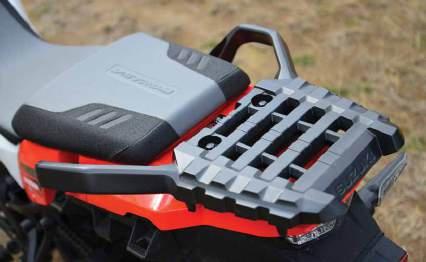
instrumentation better. Having the tacho as an analogue dial separate from individual LCD panels made it easier to flick the eyes to where they needed to be.
That’s what we found, anyway. Your experience may be different.
The other feature we didn’t believe an improvement is the new system for moving the windscreen up and down. The screen itself is a good one which sits solid and gives good protection, but to adjust the height the rider has to move around to the front of the bike, flick open a clip, set the height, then lock the clip again.
It’s an easy system and, as we said, the screen sits strong, but having to dismount to change it is a shame.
That’s it. They’re the only things we could find to whinge about.
KYB suspension front and rear is fully adjustable and did its job well. The 43mm upside-downers are plush in the initial feel but the action is firm and coped easily with both spirited road riding and rough terrain, although it wasn’t hard to find the limitations of both. The thing is, we could find the limitations if we pushed hard and tried to make the components pack up or bottom out. Neither end misbehaved once during what we think would be called ‘regular’ riding. The forks and shock, and their internal damping, are well-suited to the type of riding this bike is designed for. There’s also a big revolving knob to adjust the preload on the rear. It’s easy to get at and easy to use.
Suzuki has a stack of luggage, protection and comfort accessories available for the 1050XT. Over 50 of them. Everything from a centrestand – which is standard on the XT, by the way – to a tank bag, and from panniers to fog lights are available. The panniers fit neatly into the build of the bike and fit onto the existing bodywork, so there’s no need for separate frames. Ask your local dealer for a rundown.
At the end of our time with the 1050XT we felt we were saying goodbye to an old friend as we handed it back to Suzuki. It’s so damn comfortable, easy to ride, and, although it sounds a bit goofy, eager to please. We found ourselves enjoying every minute we spent on it, on or off road, going hard or plodding along deep in thought, and when it was time to wave goodbye it hit hard how much we’d enjoyed it and how quickly we’d settled in to it.
It’s a bike for which it’s very easy to form a deep affection.
Perhaps photo rider Pottsy summed it up best when he offered: “It pushed the fun clean out the front of my pants!”

Web: www.suzukimotorcycles.com.au.
Rec retail: $20,990 including 12 months rego
Engine type: Liquid-cooled, four-stroke, DOHC, 90-degree V-twin
Displacement: 1037cc
Bore/stroke: 100mm x 66mm
Compression ratio: 11.5:1
Starter: Electric
Fuel system: Fuel injection
Lube system: Wet sump
Ignition: Electronic
Clutch: Hydraulic
Transmission: Six-speed, constant-mesh
Suspension front: Inverted, telescopic, coil spring, oil-damped
Suspension rear: Link-type, coil spring, oil-damped
Final drive: Chain
Front tyre: 110/80R19M/C 59V tubeless
Rear tyre: 150/70R17M/C 69V tubeless
Front brake: Twin disc
Rear brake: Disc
Overall length: 2265mm
Overall width: 940mm
Overall height: 1465mm
Wheelbase: 1555mm
Seat height: 850mm
Ground clearance: 160mm
Oil capacity: 3.5 litres
Fuel capacity: 20 litres
Kerb mass: 247kg


Plenty of us dream of walking away from a mundane existence and living off a bike with every day a revelation of new people, places and adventures. Lyndon Poskitt made the dream a reality.
At 42, Englishman Lyndon Poskitt has earned a solid reputation as one of the world’s most recognisable adventure riders, largely thanks to his highly regarded and hugely popular Youtube presence. His resume includes Dakars on both teams and malle moto, and the Races To Places video series, in which he covered something like 70 countries, 230,000km and competed in 11 major races. He’s crossed The Simpson, covered 34,000km around Australia and 15,000km around New Zealand, ridden from the Arctic Circle to Tierra Del Fuego and South Africa then back to Europe. The series had more than 170 episodes and viewer numbers are in the millions.
It wasn’t as if Lyndon was living in shared accommodation in a housing commission when he made his decision to change his life. An aerospace engineer by trade, at 30 he was running an aerodynamics test facility in the UK after living and working all over the world. He’d been racing bikes since he was a junior and competed at a high level in seven different disciplines.
But in 2013 a near-death incident while running a half marathon caused him to re-evaluate his priorities and he set about devoting himself to riding around the world and competing on each of the six continents. Races To Places documented the ups and downs of chasing that dream, and in the process eventually helped finance the lifestyle.
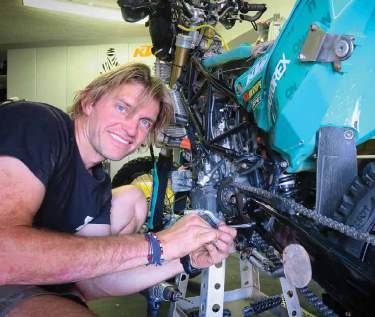
Naturally, with his huge on-line presence, and the sheer magnitude of his adventures, Lyndon has attracted some strong partnerships with a few brands, including Enduristan, especially significant because the company uses Poskitt and his travels as a test bed for its product and has even developed some products branded with his name.
Main: Poskitt’s resume includes completing Dakars on both teams and malle moto.
Above: Lyndon Poskitt must be one of the world’s most recognisable adventure riders.
Right: Races To Places documented the ups and downs of chasing the dream.
Far right: Lyndon has attracted some strong partnerships with a few brands, including Enduristan.

u



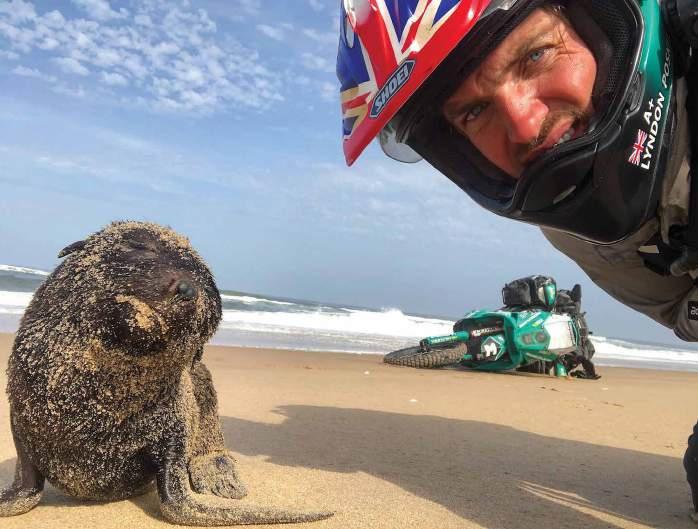
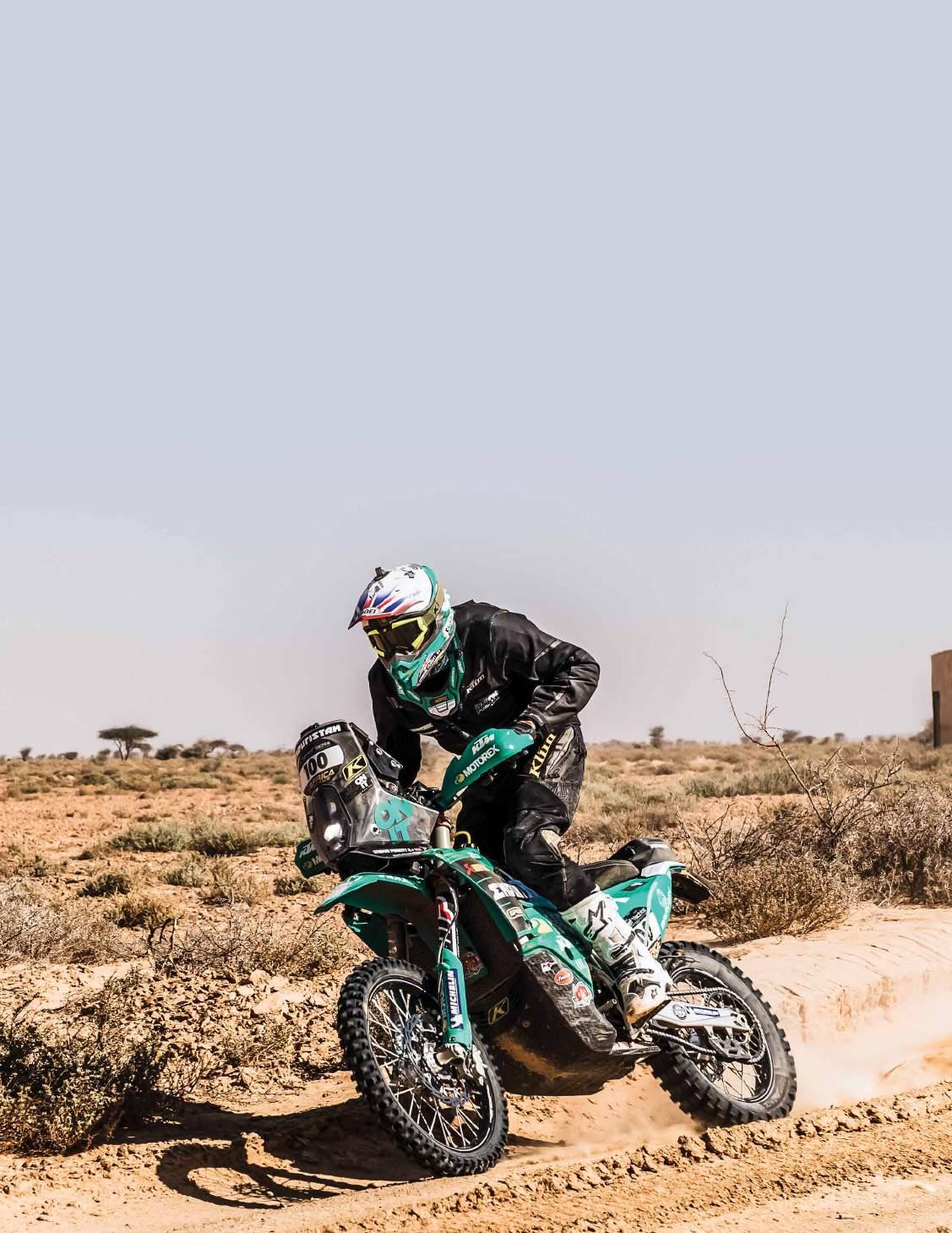
Left: A seal of approval.
Below: The Races To Places video series covered something like 70 countries, 230,000km and 11 major international races.
We missed Lyndo’s previous visit and were keen to know if we’d see him here again soon.
“ There’s a few things mulling around my head for Australia,” said the instantly recognisable KTM rider. “There are some remote rides I didn’t get to due to a lack of fuel availability on the long, remote routes.”
Lyndon also never hit one of Australia’s adventure-riding highlights, and he’s keen to tick it off his list.
“I never made it to the northern cape as it was the rainy season,” he pondered. “I’d also like to do a proper road-book rally in Australia if the Australasian Safari ever comes back.”
Although it seems Poskitt has done just about every major ride an adventure rider could dream of, he’s not sitting still. There’s plenty he wants to achieve and there are still races and places he wants to see and do.
“I’m working on a few things at the moment,” he beamed. “A new adventure for Races To Places and some possible video opportunities.
“I’m also working on a new business looking to give people the opportunity to experience factory rallye bikes in the racing environment without the need to race, which I think will be fun for a lot of people.”
These days Lyndon is based in Spain, and his plans for the near future include helping others to learn from his travels through publications, roadshows and riding events. He’s also currently writing a book about his experiences and positive attitude and hopes to have it released in 2021.
Have a wander through the random grab bag of photos from Lyndon’s adventures and see if you think he made the right decision leaving behind a career as a highly paid technical expert for a life of adventure and riding…

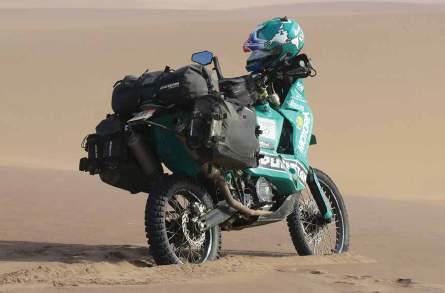
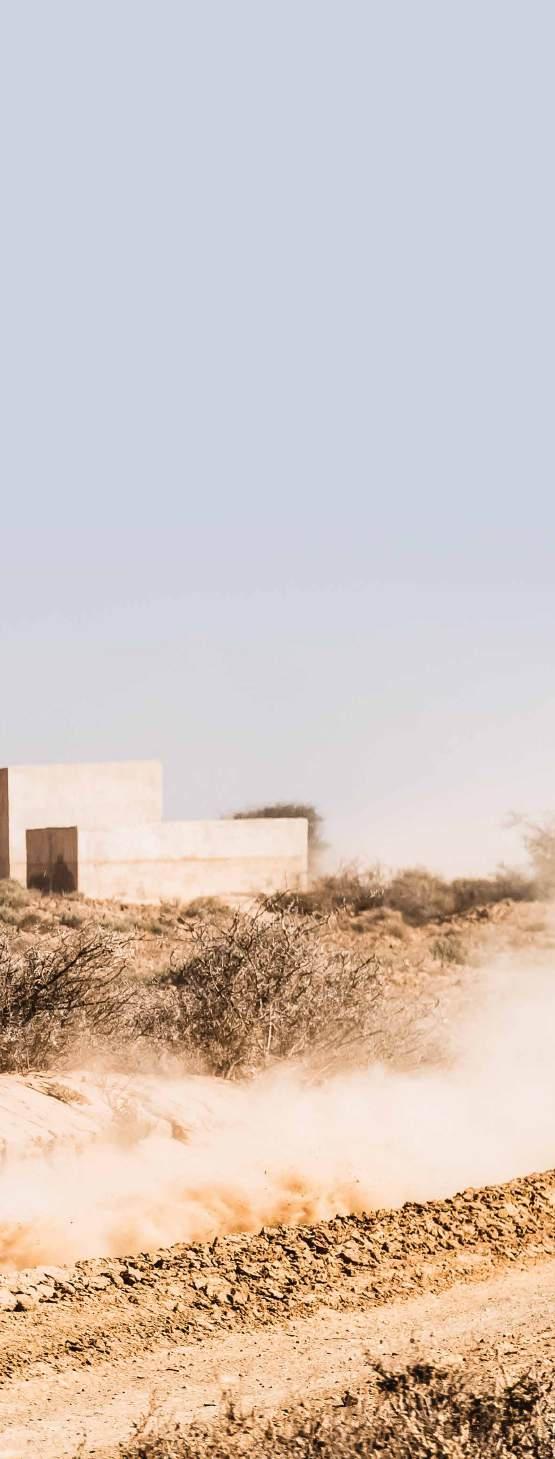

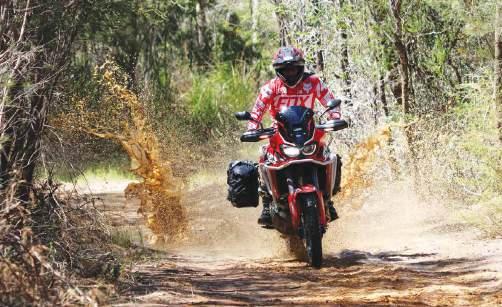

The three-wheeled brigade is underway again. Late October is the expected running of another amazing Ural annual get-together, and Adventure Rider Magazine joined the recce for a day-and-a-half of sensational trundling through the wilds of the NSW Mid North Coast. The other half day of the two-day trip was a bit how’s-your-father.
It was back in issue #29 Adventure Rider Magazine’s editor last joined a Ural recce ride.
On that occasion the route wandered from Ural Australia’s home base at Uralla, near Armidale, NSW, south through some fabulous open country and rolling hills, and ground to a halt when ride leader, Greg Jansen from Rocky Creek Designs, disappeared down a trail off Cells River Road west of Port Macquarie and wasn’t seen again until Police Rescue dragged him out later that evening.
The editor and Ural Australia’s Mat Hodge spent a very anxious afternoon and evening trying to organise a recovery, but it all ended well.
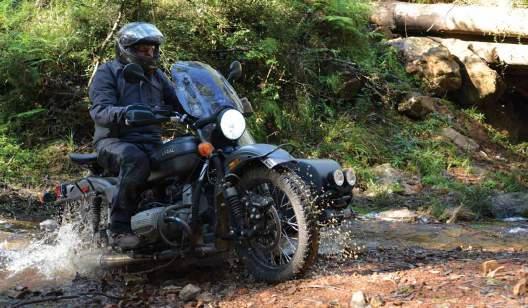
Despite the drama of the recce, the 2017 ride itself was an absolute blinder. The weather was perfect, the people on the ride were some of the nicest, most colourful, polite and generous riders ever, and TF still gets all glassy-eyed and wistful when he spins a yarn or two from that event.
For the 2020 recce the same three riders got together at Ural Australia in Uralla and headed south to map out a new route for the 2020 ride.
What could go wrong?
‘It’s not cold’
A glorious sunny morning welcomed the riders as ice was chipped and melted of windscreens and vertical surfaces. Teeth chattered and knees knocked as Mat Hodge assured the other two that for Uralla it was ‘a bit chilly’, but they should stop carrying on like sooks.
Greg was on his own Ranger, a new rig with winch and emergency beacon, and Mat and TF shared a showroom-ready Ranger Sahara with about 300km on the clock. Sales had been very strong and the third rig set aside for the ride had been handed over to an eager customer at short notice, leaving the two to pair up in an arrangement that seemed well-received.
Well…it was well-received by Adventure Rider Magazine’s editor.

While the others were still pulling on riding gear he scuttled in to the sidecar, dragged the tonneau cover across and, with icicles still clinging to his two or three layers of polar fleece and flannel undies, called out, “Rightio, Mat! You can have first drive!”
And so it began.
At first the route was fairly familiar.
From Uralla the trio trundled on down to Gostwyck, where a scenic chapel in a postcard setting makes for great photos and an ideal place to pull up for any early adjustments.
Greg managed to generate some warmth in Mat by continually referring to the location as ‘Gospers’. Mat, although protesting against the other two’s judgement of the temperature in his quiet and measured way, probably appreciated it.
From there it was the long, lazy, gorgeous run along Hillview Road and into Walcha. The sunshine continued, the temperature rose all the way to…ooo… must’ve been nearly double figures, and by the time the three were checking their phones and sipping cappuccinos at the bike-friendly Aspley Arms things were looking pretty damn good.

From Walcha TF was assigned control of the shared Ural and Mat endured a terrifying session as passenger while Adventure Rider Magazine’s editor attempted to negotiate the twists and turns of the Oxley Highway.
It didn’t go too badly, really. There was some lurching and swerving, a few poor gear selections, and the occasional left-hander turned into a straight-line with some muffled squealing from the driver, but both Mat and the Ural handled the situation with unruffled calm. On a sunny, fantastic day there was still nowhere else anyone would rather have been, and it was clear the
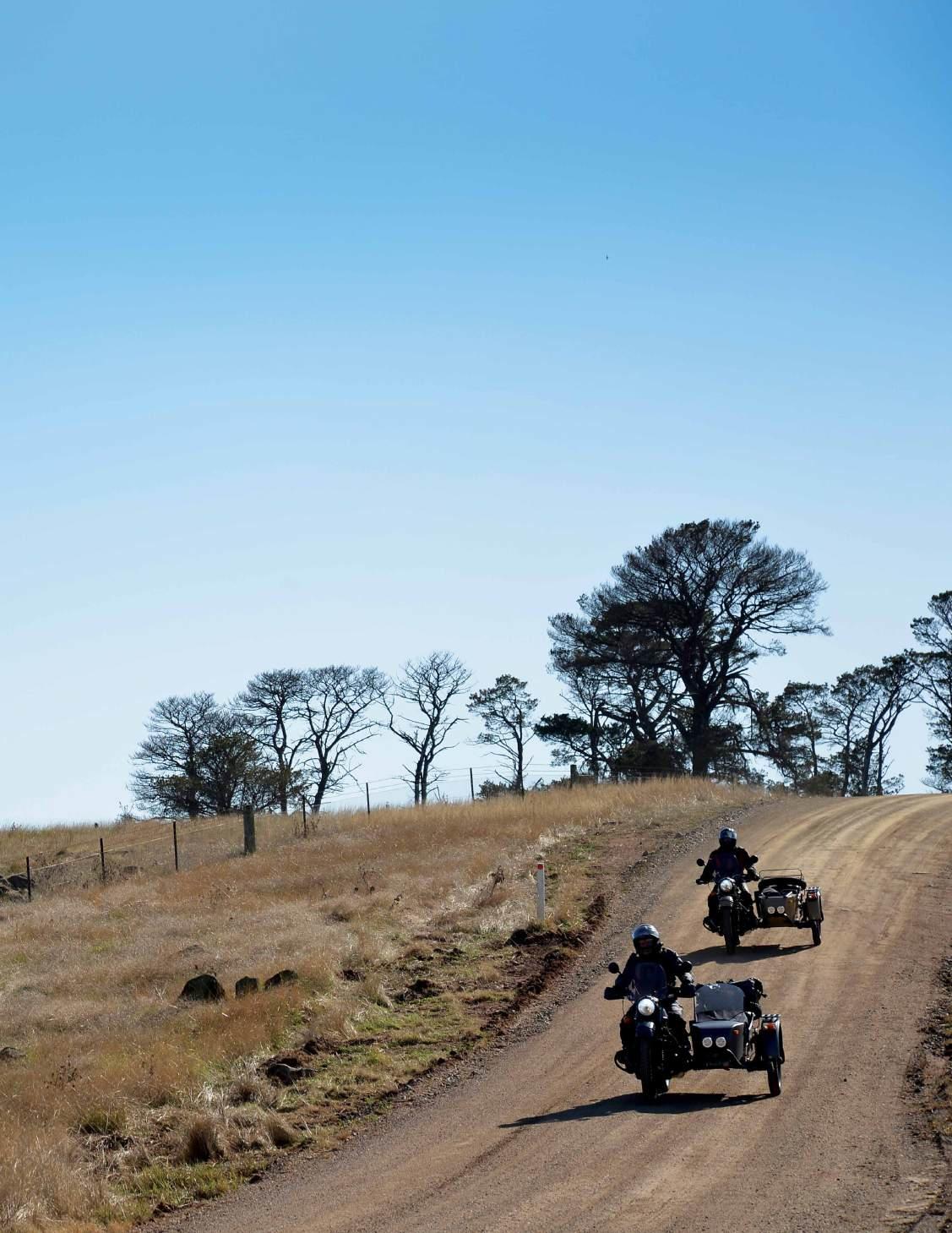
Left: It was decided not to call in and say hello. Below: Rolling out of Gostwyck on a clear and sunny morning. It wasn’t cold.
Adventure Ride itself was going to challenge previous rides for majestic scenery and premium countryside.
Things may have become a little tense when a smiling Greg came into view indicating the route followed Cells River Road.
Those with good memories may recall it was along that road somewhere things unravelled last time the same three riders were on the same mission.
Greg reassured the other two, as he had in 2017, “The GPS says this is the way,” and, sphincters puckered, the three set off into the unknown. u

Except on this occasion Greg and the GPS were spot on. Cells River Road is one glorious and superb wander through fabulous subtropical rainforest. Dense ferns and huge ancient trees line the smooth, wide, dirt road. The kilometres ticked by in dreamy splendour.
A bridge offered the setting for a few good photos, and in the spirit of fun Greg elected to have a crack at the creek crossing underneath.
The crossing went well, but climbing the bank on the other side turned out to be a bit of a challenge. It was nothing the three couldn’t handle though, and with a lot of hallooing and a bit of a push Greg and his Ranger were back on the road and raring to go.
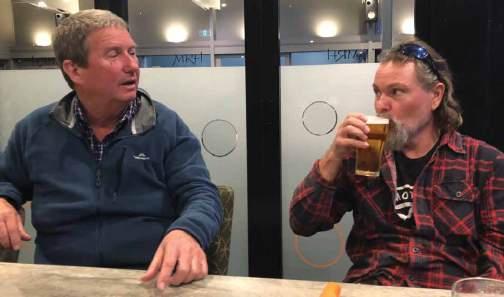
Left: Asked to find alternative accommodation.
Greg (left) and Mat were sure they’d done nothing wrong.
Below left: Too nice to not stop for a look. Right: Oh, no. Not again.
As the afternoon slowly and peacefully unfolded the two sidecars tackled some slippery dirt, some freshly graded roosty sections, some glorious, rolling hill country and, eventually, found themselves in Taree.
The happy and well-satisfied three made their way to their motels and settled in for the evening.
less said…
Things became a little strange that evening.
Adventure Rider Magazine’s editor emerged from his luxurious motel accommodation to find two Urals parked at rooms nearby. Greg and Mat had booked into a different motel, so that seemed a little weird.
At dinner it turned out the pair had been asked to leave their booked accommodation.
Hmm…
The less said about that the better, probably.
The next morning dawned bright and clear, and after signing in to Macca’s, giving names, serial numbers, length of in-seams and various other personal details, coffee and comfort food set the
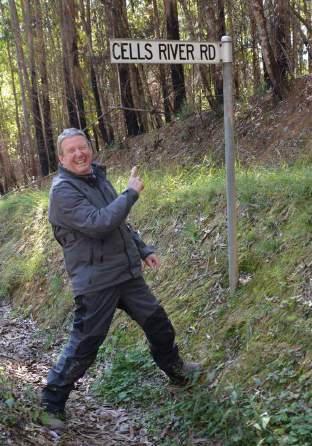
riders up for another beautiful session of chugging along Bulga Road, Blue Knob Road then Knodingbul Road. The goal for the day was to continue the run through the forest to meet the Oxley Highway, ensuring the whole section was suited to the crew on the 2020 Adventure Ride, then scoot back along the asphalt to Uralla to finish the task.
Greg mentioned a couple of times he might run back out to ‘Gospers’, but he may have just been grilling Mat’s bacon a little.
As it turned out, the rest of the route was every bit as beautiful and
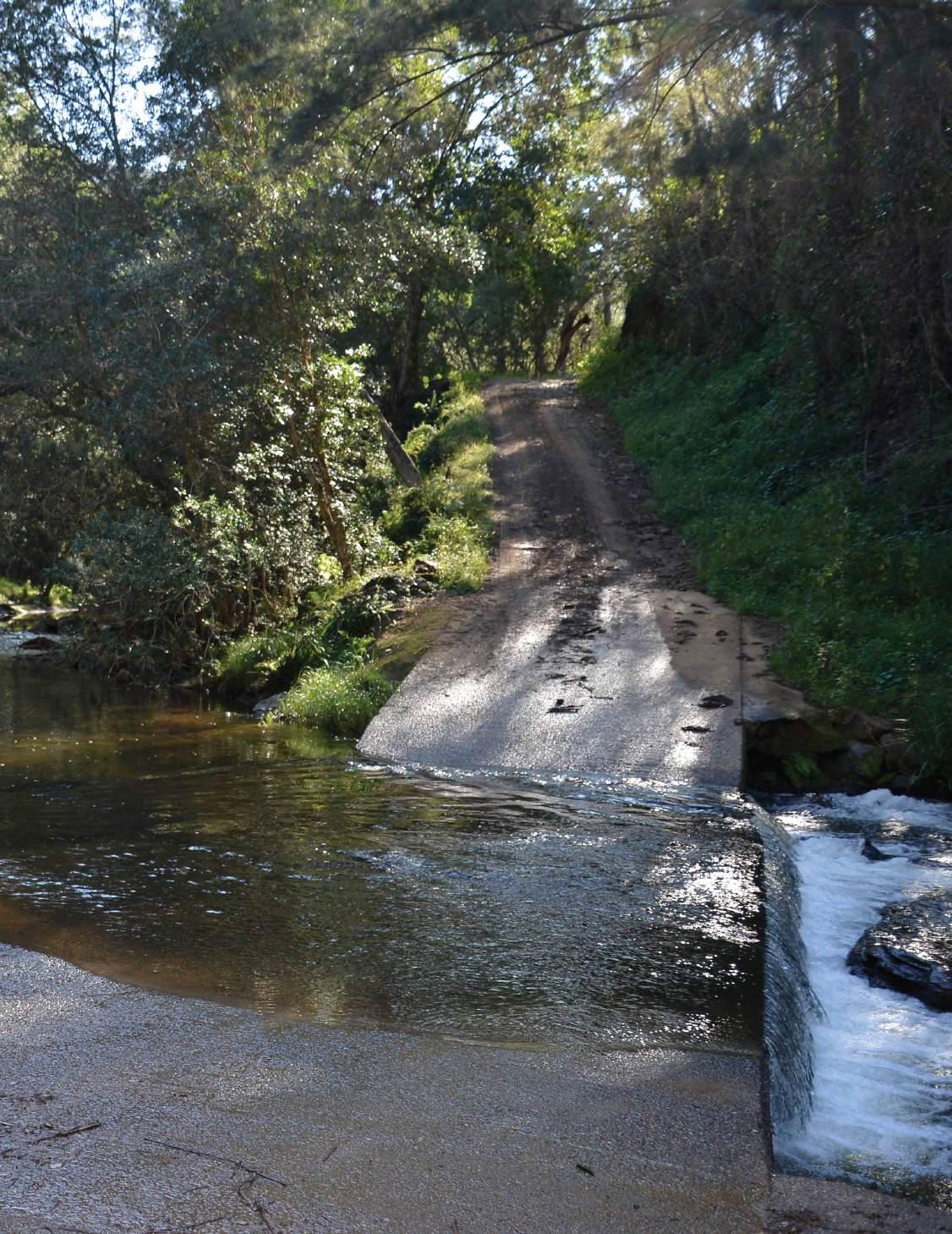
sensational as the first part. The smooth dirt road wandered along the mountainside and the morning sun filtered down through the giant, old-growth eucalypts and the lush green forest.
Except for one little section right near the end where one of the trees had fallen across the road. TF was driving at the time and miscalculated the room left between the tree trunk and the edge of the road.
Gravity took over and there was some very bad language…but the less said about that, the better.
The recce was successful in that the route is not only suitable, it’s fantastic. The Ural crew from previous Ural Adventure Rides will enjoy every kilometre, every cupcake-and-coffee stop and every amazing and breathtaking scenic view. A couple of sections were just a little challenging, a few were ideal for a bit of Ural rorting, and the road sections curved and swooped in a most rewarding way.
The 2020 ride is going to be good one.
Maybe Greg will add a chainsaw to his kit.
Keep an eye on imz-ural.com.au and the Ural Australia Facebook page for an announcement of a firm date. Hopefully, we’ll see you there.

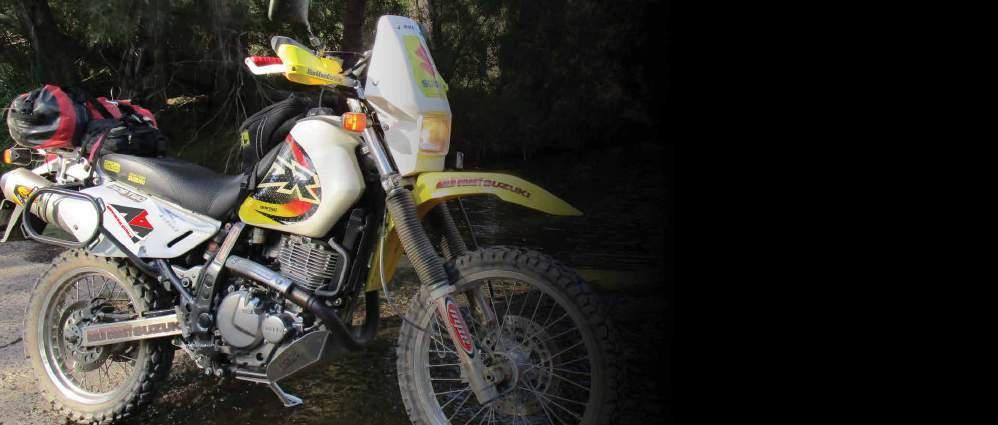
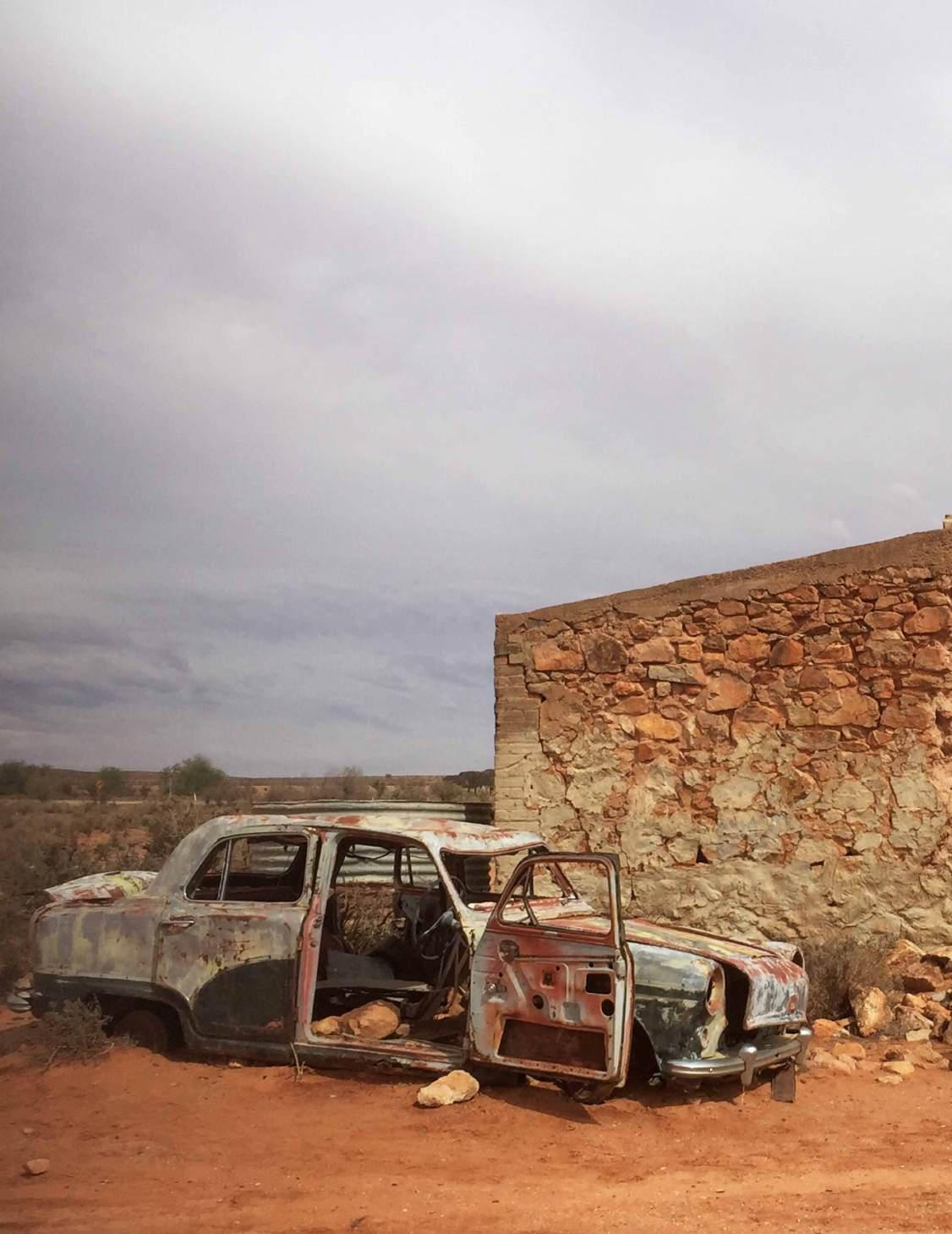
Cameron Corner sits where the borders of NSW, Queensland and South Australia meet, and it’s an iconic destination for Australian adventure riders. Paul Williams decided to tick it off his list, but things just didn’t go his way.
Words and images: Paul Williams
There’s nothing much at Cameron Corner. There’s a metal pole around which people play out a ritual by dancing and yelling, “Wow! I’ve just visited three states in 30 seconds.” There’s also a general store, an oasis for hungry and thirsty adventurers that provides a respite before tackling the 150km ride back to Tibooburra. I should also mention Australia’s dingo fence, stretching some 5600km across three states to help protect livestock on southern farms from the infamous wild dogs.
But the real lure of the region is the opportunity to ride big-sky country and to experience adventure riding across some gnarly sand, clay, limestone and gravel roads –although they’re sadly capped by a few long, straight and painful bitumen sections which lead a rider from, and back to, civilisation.
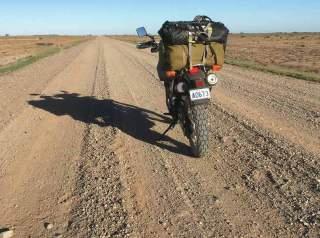
Autumn, when the summer heat has abated, is an ideal time for visiting the ‘Corner Country’. It’s remote and the riding is challenging, testing bike, riding abilities and logistical skills, but also offering a rewarding taste of Australia’s outback.
I’d always wanted to ride the region, and by chance I found myself with some spare time in late March. The DR650 was due for a trip and the camping kit only needed a few tweaks. In a very short time I was ready.
But my travel plans never included a worldwide pandemic or the travellimiting measures that were introduced and quickly escalated.
My intended route was comprised of a loop of about 2500km, half of which was on unsealed roads.

Main: A rewarding taste of Australia’s outback. Left: Gnarly sand, clay, limestone and gravel roads. Right: Author, Paul Williams.
The run from Canberra out to Broken Hill was challenging – maps or apps generally don’t tell road conditions. Hillston was a comfortable 470km, and the country looked superficially green after recent rain. The large farms and orchards near Griffith were a good reminder of the scale of Australia’s fruitand-vege sectors and highlighted the importance of water to prop up our critically important export markets and to keep Australians fed.
The route from Hillston to Menindee Lakes was a smorgasbord of road conditions and scenery. Plenty of wildlife – emus, goats, and sheep – showed some road sense. Kangaroos didn’t. Local cattle had attitude and walked towards the road to stare me down. An obligatory shingleback lizard also appeared midtrack to test my reflexes and brakes.
Big open spaces prompted reflection on the bike’s maintenance schedule and the selection of on-board spares. Although the DR revelled in the conditions, the rider did have a few brown-undie moments. Suffice to say, my respect for Toby Price trebled.
The night’s destination was Menindee Lakes, famous for an excessive fish kill
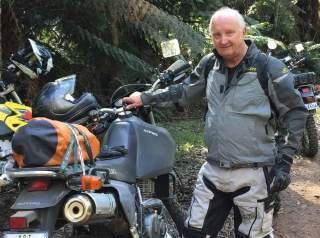
during summer drought conditions. After six-and-a-half hours and 360km – about 310km of which was sand, gravel, clay and limestone – I was looking forward to a beer at day’s end. But FSR the pub was closed. The main lake had no water, and FSR I had to negotiate an entrance to a local campground for a night’s stay.
An early start next morning saw me in Broken Hill for a sit-in-the-gutter Hungry Jacks’ breakfast. A visit to the local tourist information centre saw me sit in the gutter and ring a remote officer. Although it was mid-morning the town was in siesta mode, and FSR all the local campgrounds were closed.
I decided a ride out to Silverton, some 22km, would help me to develop a plan B. I met a couple in a flash RV at Mundi Mundi Lookout. They’d just driven from Victoria to the Western Australian border and FSR had to turn around and drive east to Broken Hill. Their faces told a story, but I felt a bit better having only ridden 1200km before hitting my turn-

around. We shared views about current circumstances, with RV-man appropriately – seeing as we were near Silverton –summarising the situation as: “It’s a bit like Mad Max all over again.” (Look it up, youngsters).
So back to Broken Hill I went to set up an operations centre. I was moved on from McDonald’s for loitering outside, so I walked across the road to sit in the shopping centre. FSR the locals were very friendly and gave me two lounges all to myself. Calls to Tibooburra indicated, FSR, its pubs and camp areas were also closing.
Reality set in. I was 1200km from home, there was no access to campgrounds, food options were limited and there was no water in the rivers or lakes. My dream to run around a metal pole had to wait for another day. I decided to head south where the flowing Murray and Murrumbidgee rivers would hopefully provide an uneventful route back to suburbia.
There’s a flood of phone apps marketed to adventure riders, each proffering benefits to help make our travels easier and more informative. WikiCamps Australia is an app which certainly rates highly when times are tough. I quickly discovered a roadside option about half-

way to the Murray River, and with daylight running out, I left the comfort of my operations centre for a 160km ride south to a ‘Highway Hilton’ – which surprised me with a family of wild goats as my host.
Apart from the sound of goats foraging for anything edible, I was constantly woken throughout the night by the rumble of road trains transporting mineral sands from the Snapper and Ginkgo mines some 170km to Broken Hill for processing. The sleepless night left me less than energised for a morning ride of about 130km to Wentworth for breakfast, a place WikiCamps Australia told me was the gateway to plenty of good camping options along the Murray and Murrumbidgee Rivers.
At Euston, on the Murray, I met – at a safe distance – an enthusiastic group of international 417-visa fruit pickers. They happily shared their work experiences and I learned about the harvesting of almonds and grapes. I applauded their efforts to travel 7000km or more to work in those roles, and it was nice to see a government initiative which successfully distributed benefits to all stakeholders.
I camped some 30 metres from the mighty Murray River, which flowed proudly past a sentinel of river red gums. The locals called them ‘widowmakers’,
Top: Big open spaces prompted reflection.
because heavily laden branches often dislodged with no notice and caused serious injuries or death to humans.
From that point my route provided only bitumen roads, although some backroad detours around Wagga Wagga helped reduce my boredom levels.
My next challenge was to cross the Hay Plain, often touted as one of the flattest places in the world. Travelling east from Balranald to Narrandera it was a 300km stretch of bitumen with a few minor kinks, no doubt designed to keep motorists awake. The section had little appeal on a fully laden DR650, even more so due to the unbelievable air turbulence created by the numerous road trains transporting livestock or goods between key population centres. To stay upright, I quickly developed a technique which saw me chest-hug the Acerbis tank to a point where my helmet rubbed the handlebars. The bike still swayed dangerously sideways with every passing road train, and it wasn’t fun, but it’s an ever-present circumstance of road travel in Australia.
WikiCamps Australia convinced me to spend my last night camping on the banks of the Murrumbidgee River, close to Narrandera. The Murrumbidgee, Australia’s second-longest river, stems from the high plains of the Snowy Mountains and eventually joins the Murray. It’s popular for its sandy beach-
Left: 1200km from home, no access to campgrounds, food options limited and no water in the rivers or lakes. Below: The main lake had no water.
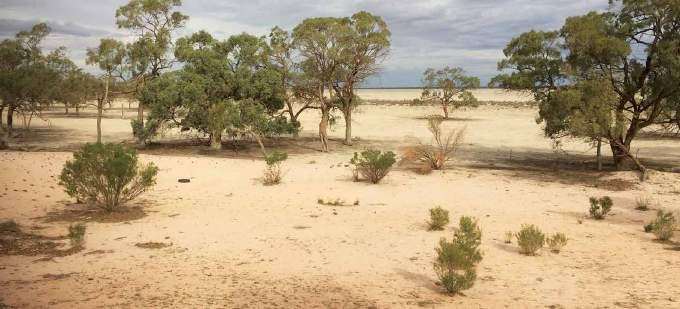
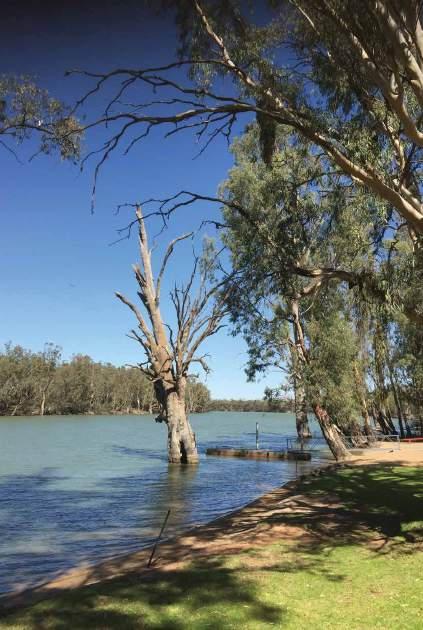
es, good swimming holes and iconic selection of camping areas. WikiCamps Australia got it right again. From the sandy banks of the Murrumbidgee it was only 300km back to suburbia.
As marketing departments usually say, ‘It’s all about the journey’. Every ride should be an adventure, and although FSR I didn’t reach my intended destination, I did see some wonderful country and visit regions which reminded me of the diversity of our great country. I also gained fresh insight into water-management issues for the agricultural sectors within the Murray Darling Basin. So, regardless of the circumstances, I enjoyed my taste of big-sky country. The world will overcome the current circumstances and I’ll revisit these regions and get to dance around a metal post in the red dust. I might also get the chance to meet more of the locals, hear their stories and
use their knowledge to add further to my outback experiences.
I urge all riders to plan a trip out to these regions; it really is a playground for adventure bikes, and it’s a genuine opportunity to use those Facebook tips on tyres, oil, exhausts, ’bars, springs and other things.

Left: Camped some 30 metres from the mighty Murray River
Below: A roadside option thanks to WikiCamps Australia.

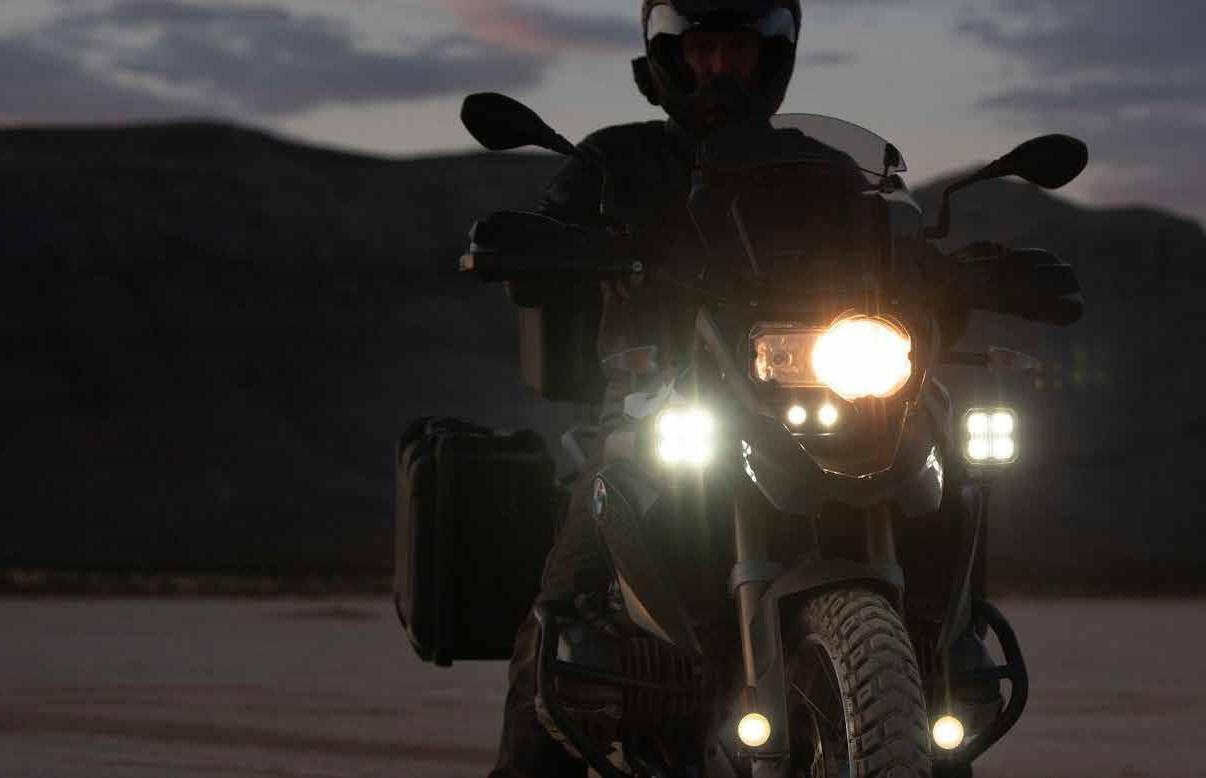



Most riders will need to carry extra fuel at some stage. There’s some good ways and bad ways of doing it.

Most riders have probably filled a plastic softdrink bottle with a litre or two of fuel to get them out of trouble, and while Adventure Rider Magazine doesn’t recommend it, we’ve all had to at some stage. If we were stuck somewhere and had no choice, we’d do it again.
But with the quality and sheer volume of information available these days, no rider really has to set out without knowing the distances between fuel stops, and that allows sensible planning.

A big tank, like an Australia Safari Tanks tank, is a great option for those doing long distances often, but not everyone likes the idea of whopping big bulge between their legs all day, every day (KLR riders are used to it). For those folks there are ancillary tanks and jerry cans, which, as long as they’re certificated fuel cells, are a good option. The only thing with jerries and similar-styled containers is securing them to the bike. That can sometimes be a little difficult and ungainly. Also, when they’re empty they still take up the same amount of room.
Bladders on the other hand, offer a few different considerations.
Like the discussion around soft panniers versus hard panniers, each variety of fuel cell has its pros and cons.
RotoPax makes a hard fuel container that can easily be securely mounted and are as tough as buggery. They have mounts and racks which allow securing horizontally or in the vertical position, either in place of, or on the outside of, panniers or a bike’s existing rack.
But for those who like them mounted in the
position of traditional hard panniers, they’ll still catch the feet in deep sand and ruts. And when they’re empty they take up the same amount of room as when they’re full.
Some other options for a hard fuel cell are the Camel ADV and Australian Safari auxiliary tanks which are specifically made for various model bikes, and of course, a you-beaut jerry from the servo.
Servo jerries generally aren’t designed for the rough-andtumble of adventure riding, but are a considerable step up from a softdrink bottle. Softdrink bottles are made from what’s called a PET plastic, and some PETs will dissolve when exposed to petrol.
Keep that in mind. A good rule for all auxiliary fuel cells is to transfer the fuel to the bike’s main tank ASAP.
Soft on
Soft fuel cells – fuel bladders – usually ride on top of luggage, but it’s not as easy to get them securely mounted, and there’s always the risk they’ll burst. Some bladders are prone to leaking as well. One of the biggest things in favour of a fuel bladder is when it’s empty it can be rolled up and stowed away, taking up much less room.
AdventureMoto has recently started producing its own fuel bladder, and Steve Smith, the big hog at the AdventureMoto trough, was happy to talk us through the thoughts and ideas used to design and produce the ADV Fuel Bag.
“What I found with the bladders I’d tried was they vented a lot,” said Steve, “and the fittings were basically reworked agricultural fittings. We wanted something that was purpose-designed for adventure riding.
“We made sure the bladders fitted well with the easy-pour spout and the caps wouldn’t come loose. Most of the leakage problems we’d seen in the past were to do with the cap, so we trialled the child-proof ratchet cap we’re using now, and it won’t come undone accidentally.
“We also wanted to ensure the inner bladder was really strong. We used a heavier-grade TPU liner. It’s RF-welded, and it’s really strong. The outer liner is a ballistic-nylon bag with MOLLE straps and it’s tough.”
A rider looking for a good-quality bladder should look for one which doesn’t leak too much vapour, doesn’t need continual venting, and has a strong protective cover with good mounting points.
Another factor to keep in mind with soft-versus-hard fuel containers is that, in general, soft containers are for transport and short-term storage of fuel. Hard containers are for longer-term storage and transport.
Those are a few things to think about when deciding which auxiliary fuel option will work best for you.

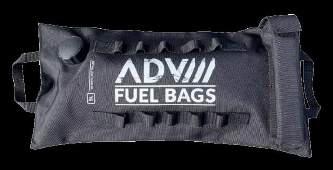

Top: An Australian Safari Tanks cell gives great range, but won’t suit everyone. Above: Adventure Rider Magazine’s editor has given the ADV Fuel Bag a pizzling and it’s held up well.
Above insert: One of the biggest things in favour of a fuel bladder is when it’s empty it can be rolled up and stowed away, taking up much less room.
Below: RotoPax fuel cells can mount vertically or horizontally. They’ll stack on top of each other and lock in place, too.
Below insert: RotoPax are tough, purpose-built auxiliary fuel containers.
Below left: Camel ADV auxiliary tanks are specifically made for various model bikes and are intended to be mounted and left in place.
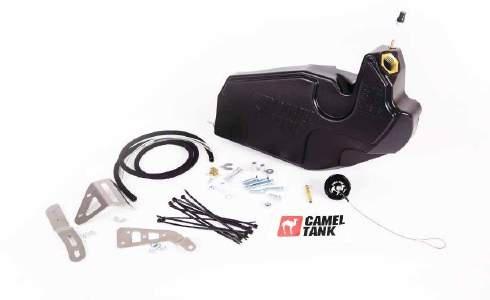

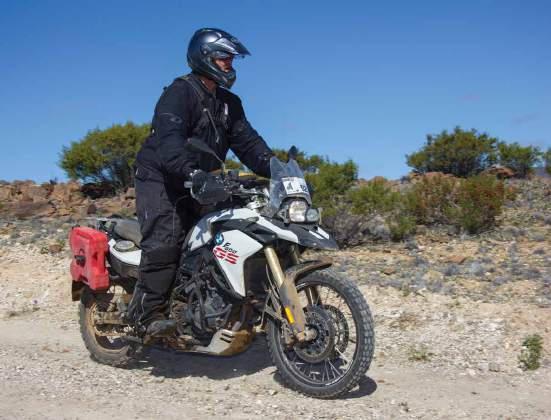
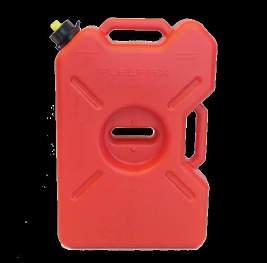
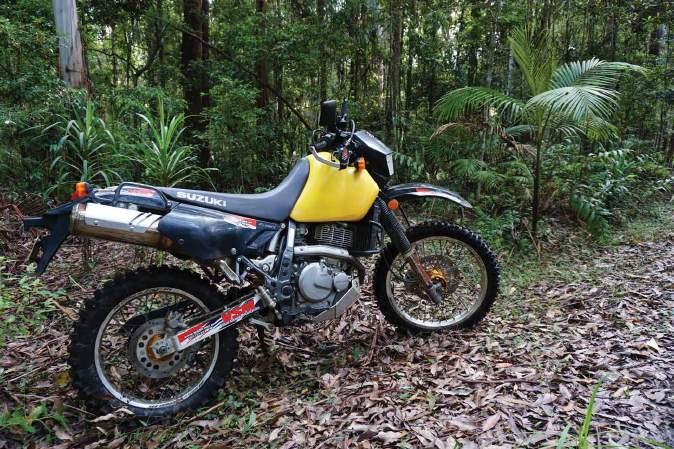
The Corona crisis had unexpected consequences.
Things were bad at home. I had the new Adventure Rider Magazine, the reading room was empty and we were almost out of toilet paper. Then an idea came over me… what if some of the internet gibber about toilet paper growing on trees was right?
It was on the ’net, so it had to be true!
I could go for a ride, find the modern Holy Grail – the toilet-paper tree – harvest some of its smooth, soft, bounty and come home a hero.
I badly needed a ride. It was a win/win situation.
But where?
I fuelled the mighty DR, dressed in my crusty riding gear, grabbed a backpack and set off.
Main: Roll after glorious roll of white toilet tissue hanging from a tree’s low branches.
Left: Surrounded by views of endless forest.
Right: A copy of Adventure Rider Magazine to help with the testing process.
Far right: Surrounded by views of endless forest and ridges.
Bottom right: A small bush with a strange cylindrical growth.
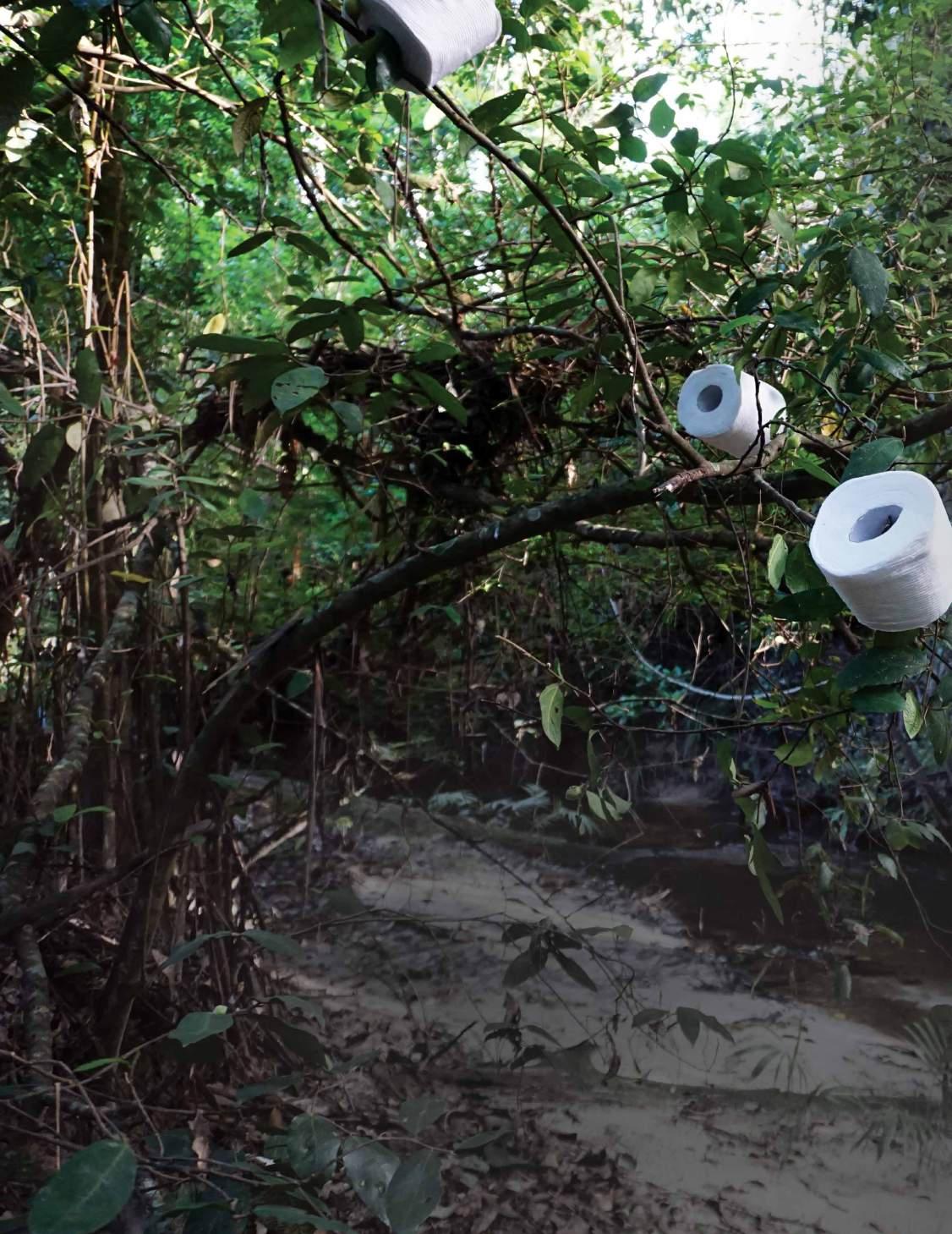
I figured maybe toilet paper grew near paperbarks, so a ride to the swamps it was.
After negotiating slippery, muddy trails a stand of paperbarks appeared. A quick search found lots of mozzies but no toilet paper. I considered paperbark as an alternative, but it wasn’t soft enough and would leave my arse rawer than a long day on a standard DR seat.
The trails were nice as the Suzuki headed for the valleys far from town and a rustle in the scrub caught my attention. A maniacal laugh echoed from an area of thick scrub and a dirty, scruffy bloke crawled out clutching a handful of dark green plants “I got the good shit,” he burbled, “Hooeee!”
My hopes raised. His red eyes grew large and
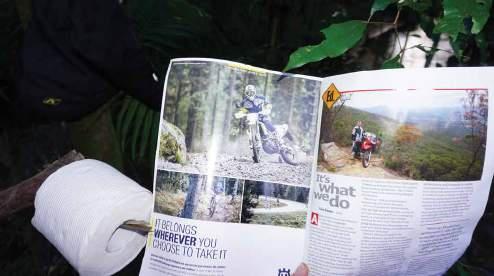
He ran screaming down the track. He clearly hadn’t found the right tree. The leaves he dropped were narrow and serrated. A clean of my more delicate areas with some fragrant green plant wasn’t going to work.
Wilderness
At least the riding was great.
Long, flowing trails climbed and climbed, and soon I was surrounded by views of endless forest and ridges.
Eventually I found myself on the area’s highest peak.
Fires had licked at the summit. One side had been burnt while the other was still green and lush. As I admired the view I began to doubt the existence of a toilet-paper tree. I was turning around to go home when a small bush with a strange cylindrical growth on top caught my eye.
It was toilet-paper roll with the white goodness missing.
Patches of green could be seen in the deep dark gullies untouched by the recent fires. The overgrown bush clawed and scratched at bike and rider as I hopped logs and headed down the slope.
A cutting to a creek looked daunting but promising at the same time, and the 650 slithered down through the thick leaf mulch, pulling up at a sandy creek.
Sand was rare in this area, I knew. Its eerie whiteness contrasted to the rainforest’s dark overtones and brightgreen foliage.
I dismounted, shed some gear and, dropping down a bank, started walking upstream.
Razor-sharp wait-a-whiles clawed at my skin drawing rivers of red blood and

I could almost see the leaches running towards me as I ducked and dived around stinging trees.
Then a touch of white caught my eye.
As I smashed through the last of the thick undergrowth, there in front me was roll after glorious roll of white toilet tissue hanging from a tree’s low branches, almost glowing in the dappled light.
With great excitement I harvested a few rolls off one side of the tree, making sure to leave plenty behind. It smelled like toilet paper and felt soft like toilet paper…but there was only one way to find out for sure.
I grabbed a copy of Adventure Rider Magazine from my backpack to help with the testing process and searched for a suitable log. A few paragraphs later the editor’s words had worked their charm.
I chuckled to myself as I carefully tore some of the soft, white tissue off
the roll and gingerly put it to the test. I shouldn’t have worried. Mission accomplished.
Suitability pleased with myself, I buried the evidence and suited up.
Closer to the main trail I was careful not to leave any big skidmarks, and thanks to the exotic tree my pants were similarly free of branding.
The ride home was even more fun. The bike seemed lighter and a huge smile of contented success filled my helmet.
As I stacked the fresh TP rolls triumphantly on the bench at home, the wife looked over unimpressed and said, “You’ve been riding again, haven’t you? It can’t take that long to go to the shops.”
I explained my dangerous adventure and she rolled her eyes in disbelief.
True story? Or a yarn to justify a ride during lockdown?
You be the judge.
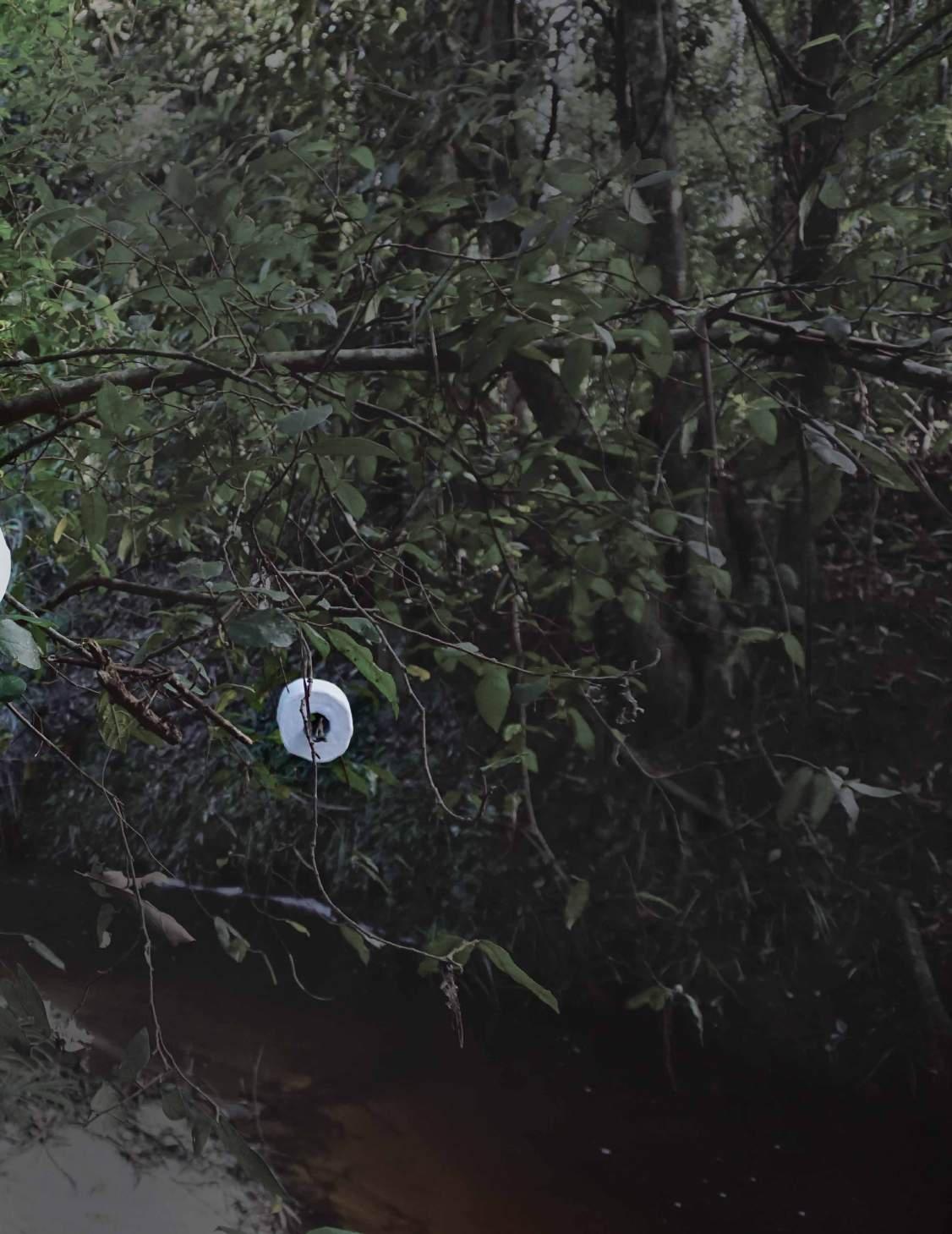

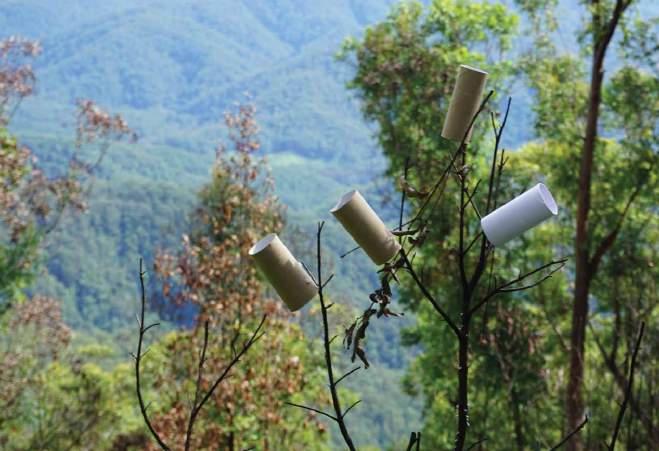
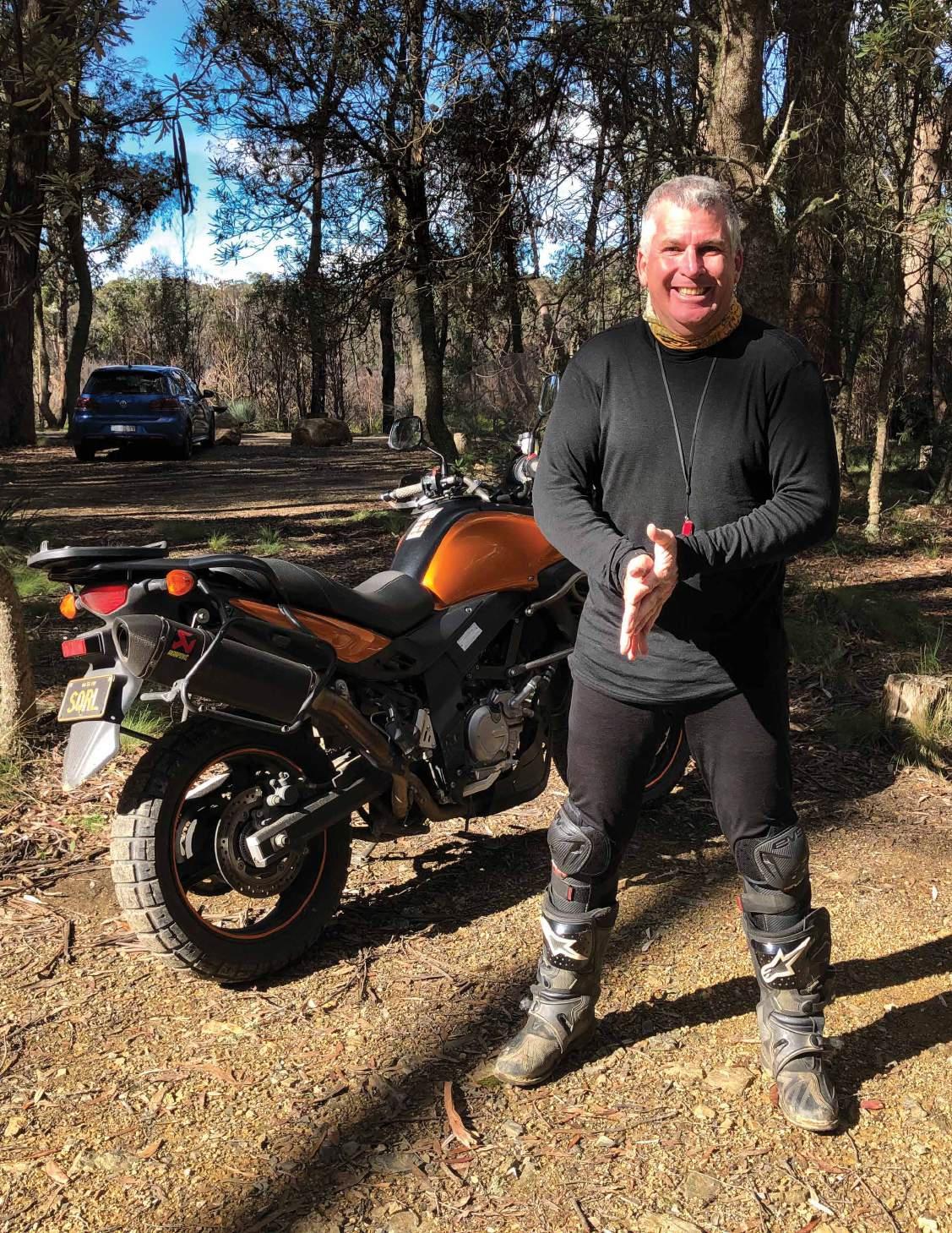

You’ll be reading this towards the end of Australia’s official winter months, and if you’re not already wearing some kind of next-tothe-skin layer designed for warmth, you’re suffering way more than you need to and enjoying your riding way less than you could.
I’ve been wearing Andy Strapz Thermalz for, I guess, over 10 years. I think the set I just ordered is my third, and I’ve paid for all of them.
Believe it or not, I wear Thermalz all year round, in all types of terrain.
I originally bought the first set of Thermalz to help deal with the cold.
I’ve had several sets of synthetic compression gear and they worked well, but the design of Andy’s Thermalz caught my attention. The top is long and has a tail so when I lean forward it doesn’t ride up and leave me with frozen kidneys. The bottom half has a fly. That may sound a little basic, but my synthetic gear didn’t have a fly, and it makes things awkward. You can figure it out. I’m not going to show pics.
On top of all that, Thermalz are made here in Australia.
The marketing material said because


Thermalz were made from not only superfine merino wool, but Australian superfine merino wool, it wouldn’t stink, even if I wore it for days on end.
Lord knows, the synthetic gear became very manky very quickly. Even I couldn’t stand myself after about the second day.
As a huge bonus which I didn’t know about until the first set arrived, Thermalz are a really light and a loose fit, and that was way more comfortable for me than the feeling of being in a sausage skin which I had with the compression gear.
That’s a key difference between synthetic thermal gear and natural-fibre apparel, by the way. Synthetics are at their best with a fit close to the body, while natural fibres are better with a little leeway.
When I started wearing the Thermalz to help deal with cold the result was immediate. I could instantly handle lower temperatures with less stress. I don’t know that the natural fibre kept me any warmer than the synthetics, but the comfort was a big and instantly noticeable factor. Even stopping for a pee was a far less challenging episode, and as promised, I could wear the gear for days at a time and still keep it in the room or tent each night instead of leaving it outside and worrying about it possibly crawling away.
So all that was good.
The real surprise for me was when I decided to start wearing the Thermalz in summer.
v Aussie-made, top quality ultrafine, no-itch merino-wool
v Half-polo neck
v Double front
v Extra body length
v Longer arms and cuffs
v Care instructions in side seams
v Shirt-tail back
v Available in sizes XS to XXL
v Rec retail $86

v Aussie-made, top-quality, ultrafine, no-itch merino-wool
v Warm and comfy

v Designed for the posture, position and varying activity level needed while riding
v Lightweight
v Wicks moisture away from the body
v Integrates well with modern fabrics that are waterproof but breathable
v Adjusts to temperature, warm even when wet
v Have boxer shorts sewn in for extra support and warmth
v The waistband is broad, comfy and high-backed
v Long cuffs from ankle to mid-calf reduce bulk of boots and socks
v Male Pantz have a generous fly
v Ladies-cut Pantz without the fly are available
v Available in sizes S to XL
v Rec retail $86
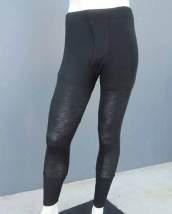

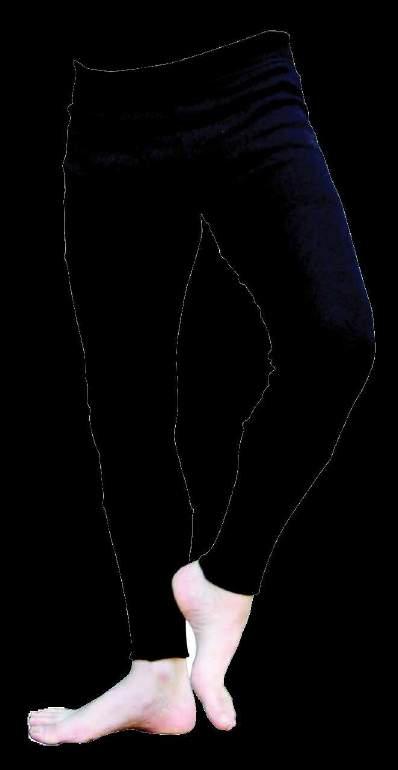
This was some years ago, and I can’t even remember when, but I do remember my reasoning and it still holds today. By the time I pull on knee guards, boots and pushbike pants – or whatever the correct name of those shorts is – there’s very little air actually gets to my legs, especially when I’m sitting on the bike for big distances. I’d tried all kinds of long socks and knee tubes and could never really get happy. They’d always fall down, bunch up or twist so they ended up bloody uncomfortable one way or the other, and the knee guards would go with them. I thought if I wore the Thermalz duds, they’d stay in place, and it wouldn’t matter because not much air gets to my legs anyway.
It turned out to be one of the smartest things I’ve done.
The woollen weave of the Thermalz, integral in holding body heat, allowed whatever air was coming through the venting in my pants to get through to my skin, and the legs and knee guards stayed put. No riding up or down or being otherwise troublesome.
It was a revelation.
These days I wear the Thermalz pants as part of my regular riding apparel, irrespective of which suit I’m using or the external temperature. The top I wear in temperatures up to about 30 degrees because I found it has the same properties. If I open the venting on the external suit, the air flows around the Thermalz top nicely. If I get a bit sweaty the Thermalz top seems to deal with it somehow – the marketing material says it ‘wicks it away’, but where it wicks it away to, I have no idea – and it still doesn’t get smelly or uncomfortable to wear. In the cold it’s a lifesaver – literally, sometimes. In low and extreme-low temperatures it makes a huge difference to the effectiveness of a windproof suit and allows, I believe, one less layer than it would take to cope without Thermalz. If I don’t start the day wearing the top, it’s always in my pack ready to slip on if I need it.
For me, the Andy Strapz Thermalz are top-quality, 100-per-cent effective adventure-riding gear, and I can’t recommend them highly enough.
Just to ensure the recommendation isn’t taken out of context, I can’t wear the Thermalz on enduro-type terrain. They hold way too much body heat when things get physical. But for coping with the extreme climate conditions seen by most adventure riders, I’ve found them to be exceptional.
The replacement tops and duds have been because I’m a tad ham-fisted when I take them off, especially the top. I grab the collar to pull it over my melon, and after a few years the collar comes away. The pants are the same. I grab a handful of fabric to heave them up over the rippling calf and thigh muscles – or whatever it is making my legs big – and over time the weave just unravels a tad. If I’m buying a new top anyway, I figure I may as well get new pants.

Improve your off-road riding skills and have a great time. All brands are welcome! From novice to advanced riders.
NSW, Dargle –September 26-27
Victoria, Bright –October 24-25
Improve your:
v Bike control
v Precision
v Confidence
v Traction
v Balance
Learn about:
v Bike setup
v Tyres
v Suspension
v Throttle
v Clutch
v Cornering
v Powerslides
v Uphill/downhill
v Obstacles
v Wheelies
v Braking
v Sand
On a long ride where the pack is tight I’ll often strip off my riding gear at the end of the day and hang around camp in just the Thermalz – an awesome sight for everyone, I’m sure – and then climb into the swag or tent. The Thermals work equally as well for helping hold body heat overnight and mean I can travel with less bedding.
With 20 years experience in off-road rider

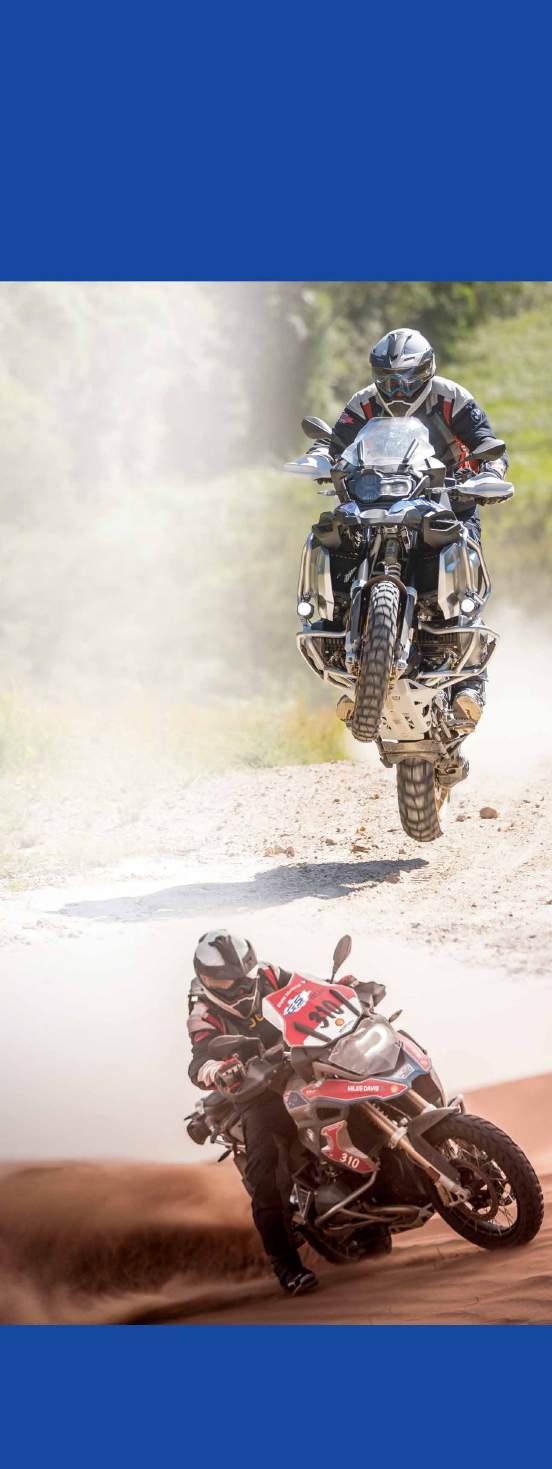
Limited positions available, for more information and bookings www.advridermag.com.au/off-road-training/ or call


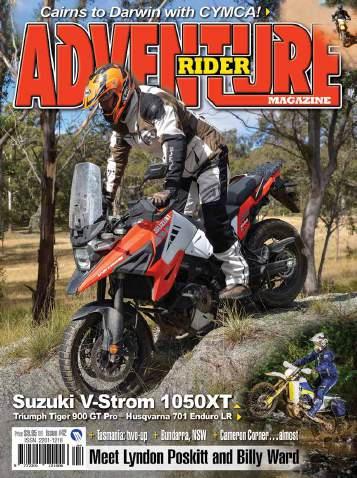

12 issues choc-full of the world’s most isolated destinations and the country’s bucket-list routes written and photographed by the people who were there. For a two-year subscription we’ll include a unique, specially designed Adventure Rider Magazine tee* worth $24.95. That’s a whopping $144.35 value for just $98!
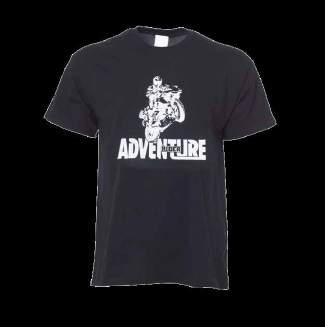
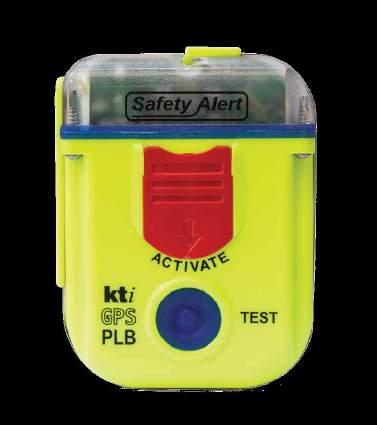
The ultimate adventureriding distress beacon that should be part of every adventure rider’s kit. Provides six independent means of rescue: 406MHZ transmission
121.5 MHZ homing signal GPS location
Visual strobe
Signal mirror Whistle on lanyard Manufactured in Australia. 10-year battery life. 10-year warranty.

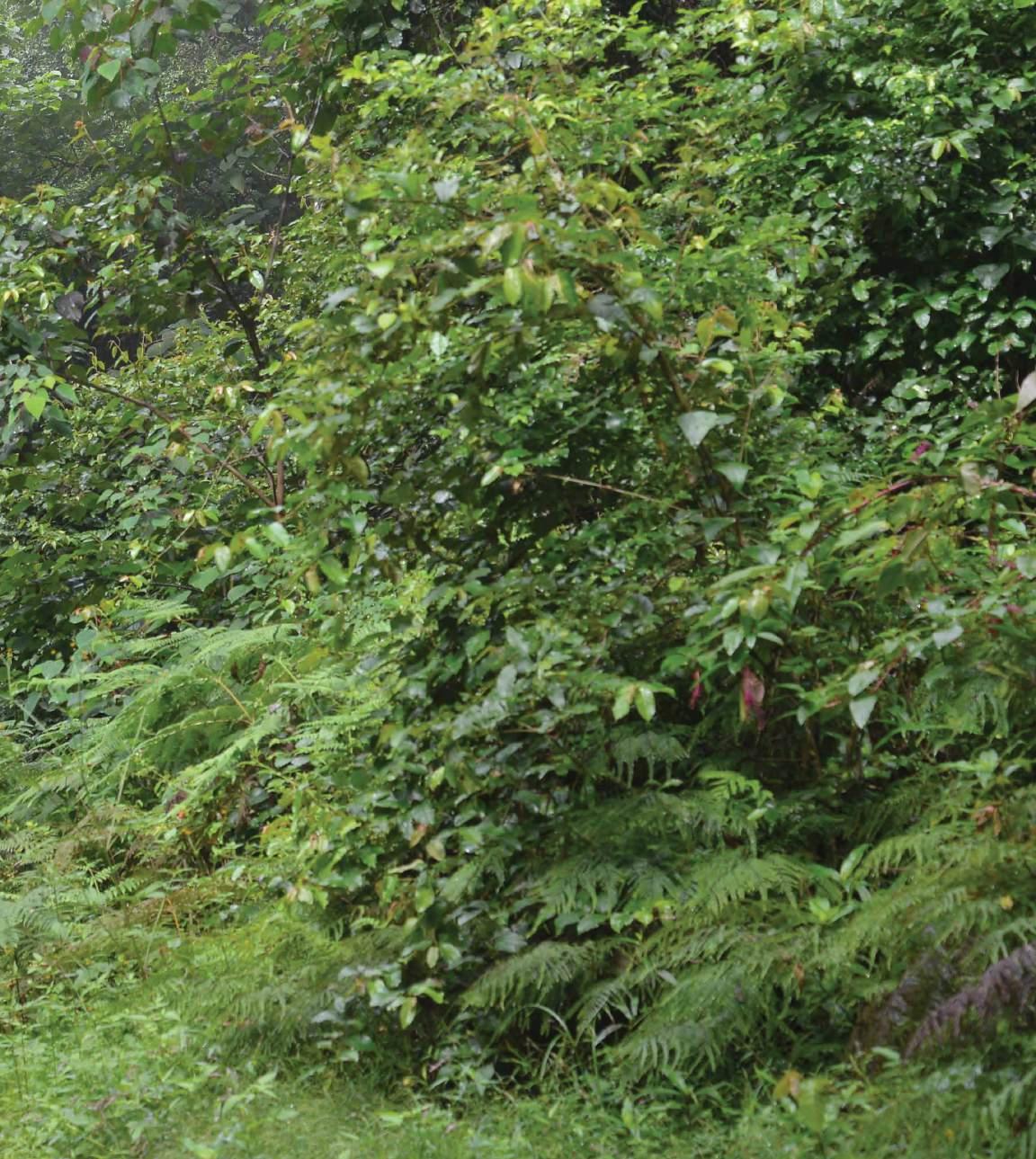



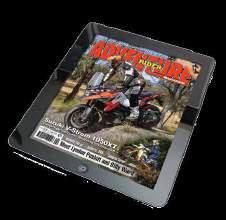

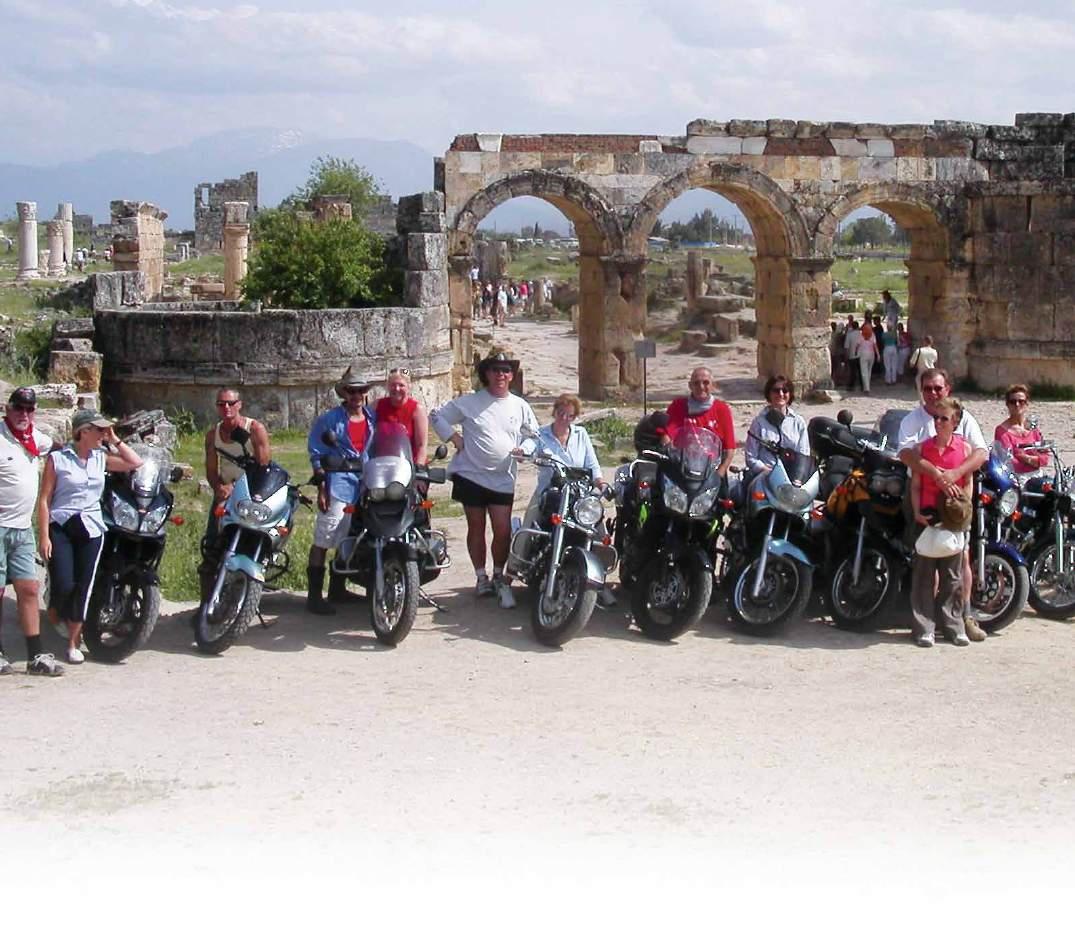
There was a lady called Margaret who wanted to join our Himalayan Heights safari in the early days, 1997. She was in her late 50s and hadn’t been riding for very long, a couple of years at best, but was confident of being able to tackle the various hazards presented by mountains, altitude, and the Indian road system. She and I had a mutual friend who vouched for her, assuring me Margaret was a competent rider, so we took her on and a couple of her other friends signed up too. Quite a well-spoken lady of dulcet tones, her friends would occasionally refer to her as ‘Lady Margaret’.
Recommended
I’m sure Marg won’t mind me telling, but the ride proved to be well beyond her. She dropped her bike almost every day in the first week alone. Remarkably,
she didn’t hurt herself and always bounced up cheerfully, admonishing herself and apologising to me, before mounting up again and continuing. I gave her as much coaching as I could ‘on the fly’ and suggested she might benefit from some advanced rider training when she returned to Sydney. I recommended doing the Australian Superbike course run by Steve Brouggy, as I’d recently done it myself and found it to be excellent tuition. Marg took the advice and indeed completed more than one level of the tier-structured course. But even so, a couple of years later when she enquired about our Andes tour – and now in her 60s – I was a little trepidatious. I suggested instead she might enjoy our tour of Turkey, which is a little less arduous. Marg acknowledged Turkey was in fact on her list of places to visit, and when I mentioned we could put her on a
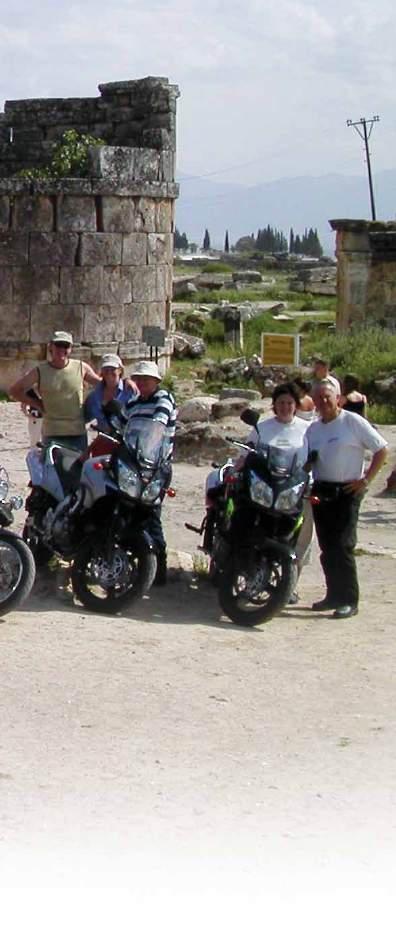
Suzuki 650 Freewind, the same bike she had at home, it was a done deal. She signed up for our Turkish Treasures 2003 ride.
When we subsequently gathered in Istanbul for the start of the tour and introductions were completed, Marg related how she’d had all manner of complications getting her new jacket through the various airport security systems. As an extra safety measure, she’d invested in one of the latest jackets which incorporated an integrated airbag function. If the rider suddenly became separated from the motorcycle, the airbag would inflate in a fraction of a second in the same way airbags do in cars, and it was operated by a lanyard which the rider ‘plugged in’ to a fixed anchor point on the bike. When the lanyard was yanked by a rider launched into orbit, it pulled the pin on a compressed-air cylinder within the jacket, and it was the cylinder which gave the airport authorities cause for concern. Marg had had to produce various specifications and bits of documentation from the manufacturer proving it was safe to carry the jacket in a pressurised aircraft.

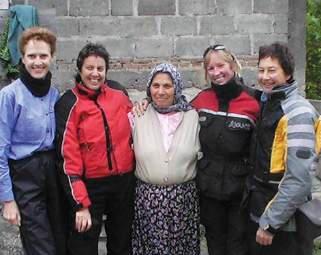
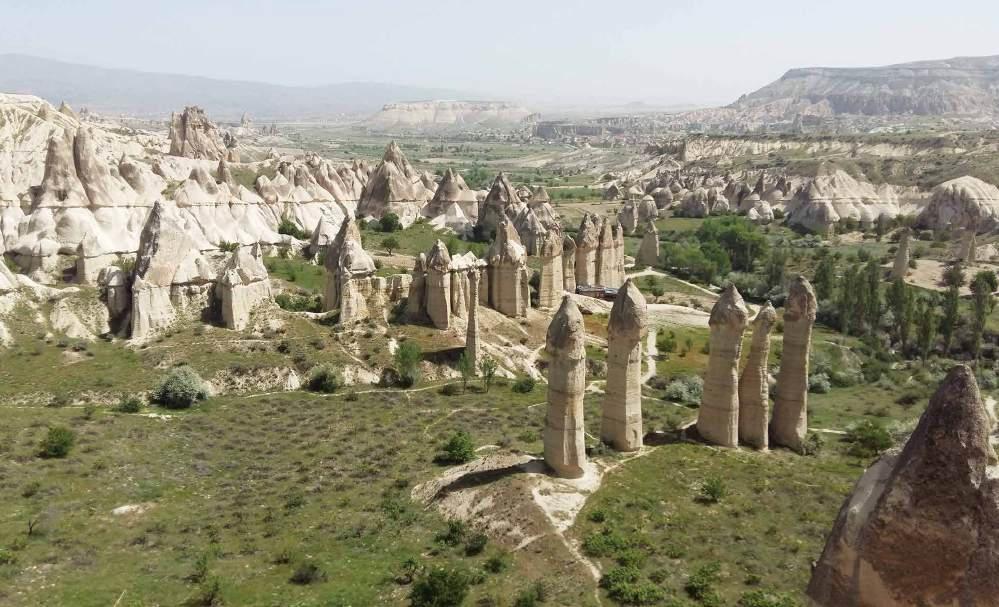

From day one of the tour the improvement in Margaret’s riding was immediately noticeable. The training had sharpened her skills in many departments and she
was much more confident on the bike. She was looking well ahead through the corners, counter-steering nicely, shifting her weight on the seat and was enjoying herself as a better rider. We
visited Gallipoli, the Aegean coast, the Mediterranean beaches, and traversed the eerie landscapes of Cappadocia on our way north to the Black Sea coastline. The land there is a soft volcanic tufa
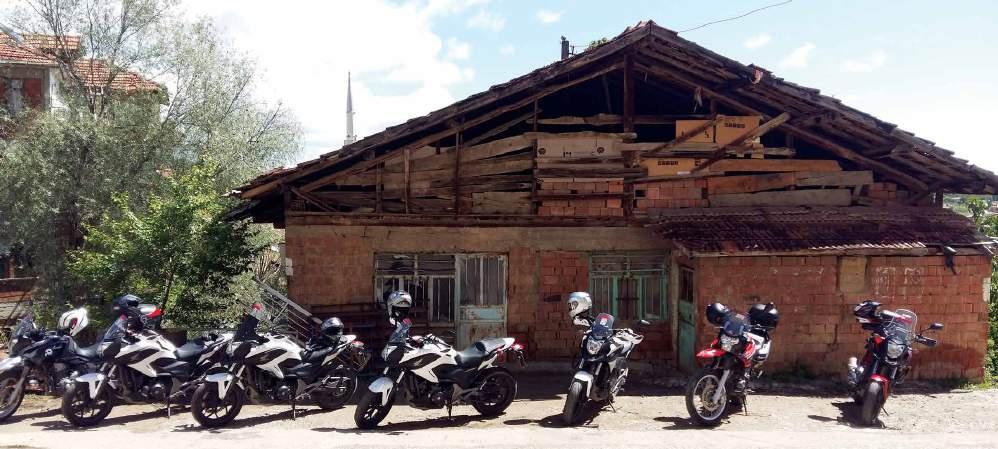

which has been eroded over centuries by wind and rain to form unusual and spectacular shapes including ‘fairy chimneys’. Marg and the other ladies had quite a chuckle when I took the group to observe the nearby Phallus Valley.
As we continued north the next day, on a gently sweeping uphill corner somewhere high on the Anatolian Plateau, the unthinkable happened. Marg hit a greasy patch on the road, the back end of the bike went past the front, and she was flung from the saddle. She went one way, the bike went another, and both slid down the road on divergent paths – fortunately at a fairly slow speed.
She had an audience of course. There were three of us riding with her at the time, and we all stopped quickly and helped pick them both up, brush them down, and make sure Marg was okay. True to form she had bounced up, unhurt, almost before she even stopped sliding.
“So, Marg,” I was dying to know, “How well did that new airbag-jacketthingy work?”
Far left: The ancient Roman library in Ephesus. Bottom left: A rustic rural parking lot. Above: Yes, it can get very cold in Turkey. Below: “Airbag jackets? Nah, pull ya head in.” Right: Marg’s high-vis airbag jacket.



It was the only time I ever heard Lady Margaret use an expletive. She looked at me with an exasperated expression and spluttered, “I forgot to plug the fucking thing in!”
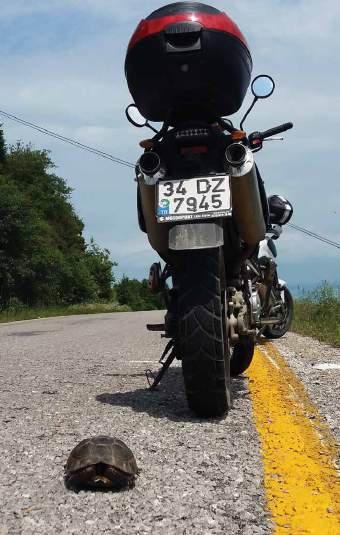
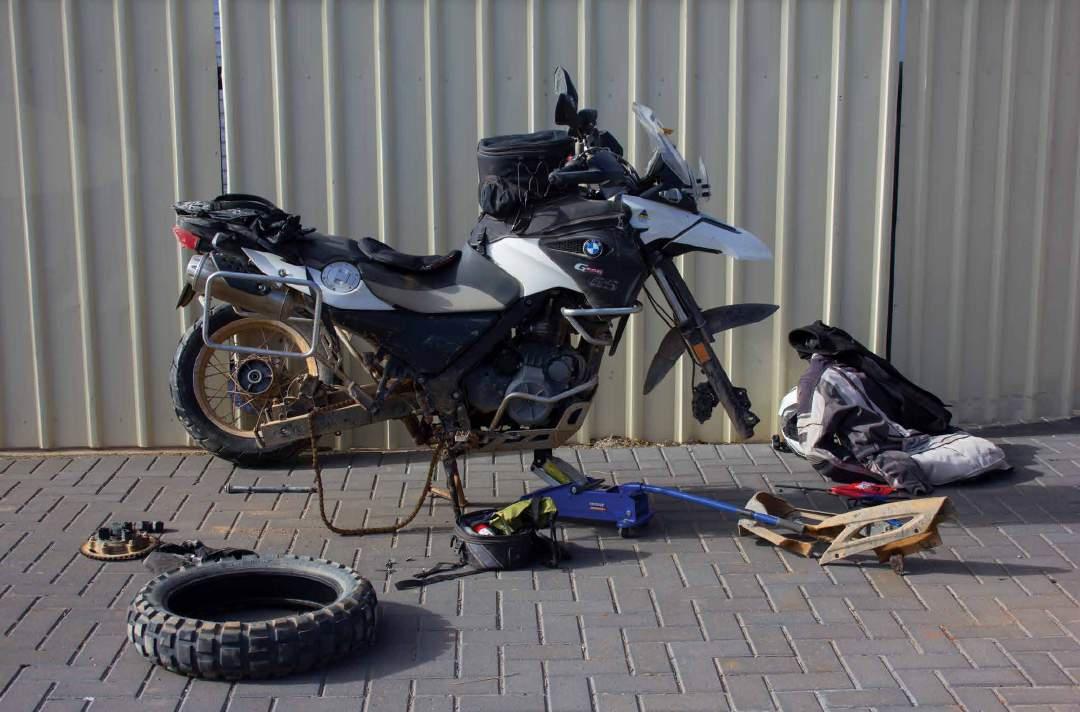
A little care can go a long way. A lack of care for a bike and its systems can mean it won’t go very far at all.
“L
ove your bike and it will love you back.”
These are the classic words from Klaus Mueller during one of his Desert Sunset tours in Victoria about 10 years ago. I like the saying and have borrowed it regularly. You and your bike are a team. As an adventure rider you end up in some remote situations and the last thing you need is a problem that could have been easily avoided.
When you think about it, most riders simply put fuel in their bike and ride it. There isn’t much of a
preventative strategy at all. Good technique and some mechanical sympathy can go a long way to more successful adventure rides, less breakdowns and more fun.
It isn’t uncommon for riders to apply small-bike riding attitudes to their generally bigger adventure bikes, bikes that have a lot more power and mass. The temptation to launch off erosion mounds or fly through rocky sections doesn’t always go unpunished. Rim damage is quite common and there is lots of banter about ‘soft’ rims and ‘dodgy’ suspension. Generally, I see it quite differently. You need to understand you and your bike’s capabilities and ride accordingly. Believe it or not, most of this sort of damage can be avoided with better technique and a smarter strategy. A term I like is ‘float like a butterfly’. It means to choose the right speed, choose good lines, and use body position to

take the impacts out of the bike. A typical scenario is:
v Rider not looking far enough ahead. Doesn’t see obstacles soon enough
v Riding too fast to be able to slow down before impact. Chops the throttle, grips the bike tight and holds on like Lego Man
v All the forces are multiplied through suspension to wheels and rim damage happens, even on quite small rocks, holes and so forth.
The ideal scenario is:
v Look ahead, pick smooth, flowing lines. Slow down when situations are seen ahead
v Be smooth on the throttle, sometimes adding a controlled blip to make the bike float. Use body position to soak up impacts.
Done well the bike barely notices the same obstacles that cause wheel damage to Lego Man and his mates.
Adventure bikes’ suspension is generally medium to soft to provide comfort over long distances. Some riders see this as a weakness and spend a lot of
coin to firm it up so it can handle bigger impacts. This can put even more stress on the rims. It’s all a bit of a balance, but technique always trumps.
Riding off-road is quite unique compared to many other types of riding or driving.
Clutch control is one of the most helpful skills a rider can have to navigate slow technical terrain, up hills and so on. Whenever clutch control is mentioned, it goes hand-in-hand with throttle control. Get a rider to attempt full-lock circles on a flat, firm surface and in about five seconds a pretty good idea of a rider’s clutch and balance skills will be obvious.
This exercise can challenge many experienced riders, too.
Many adventure bikes are powerful and torquey and with bad clutch control in some situations it’s possible to fry a clutch in about 60 seconds or 100 metres. I’ve seen it happen on trusty DRs, GSs, orange bikes…nothing is immune. It’s simple: high revs and high clutch slip is the killer.

Far left: Keep an eye on sprockets, wheel bearings, brake pads, steering-head bearings, spokes and tyres for cuts, nails, screws and a stack of other potential problems.
Left: Taking off in soft sand you need some revs as the back wheel will need to be spinning, but you don’t need clutch slip.
On the flipside, slipping the clutch smoothly, generally in first gear at lower revs, will not wear or damage a clutch. I think about two scenarios where less-experienced riders can be easily caught out.
First is getting stuck on hill climbs. Sometimes the rider isn’t aware they got stuck in second gear, then they bring on heaps of revs and lots of clutch slip to try and get going and their clutch is in a world of hurt. Even in first gear this sort of thing can easily cook a clutch.
Second is riding in sand.
Taking off in soft sand you need some revs as the back wheel will need to be spinning, but you don’t need clutch slip. Let the clutch out with a few revs, get the back wheel turning and hopefully the bike moving forward, then let the clutch out fully and manage spin, revs and drive with the throttle only.
Another situation where I see clutches getting a tough time is riders attempting wheelies, especially on the road where there’s lots of grip.
There’s a bit more technique to wheelies that simply pulling in the clutch, adding lots of revs, then dumping the clutch. This can put lots of strain on the complete drive train.
It’s important to know how much a clutch can contribute to technical riding control and to try to be smooth and sympathetic to it. Depending on your
bike, you could get up to, or over, 100,000km/many years without any issue.
We can ride in some dusty conditions in this country and this can be really tough on airfilters and engines. Some bikes come with paper filters, others oiled foam. Regardless of the type of filter you need to inspect and service it before your filter fails and your engine sucks a lungful of dust. Foam prefilter socks are a great addition for adventure riding and can be easier to inspect and service than the main filter element.
Before, during and after each ride you should be taking time to keep an eye on your bike. Check for loose or missing bolts. Use Loctite on key bolts and carry a few spares in your kit. Keep an eye on your oil level, know the correct procedure to check the level (warm engine and let sit? Dipstick or sight window? Wet sump or dry sump? And so forth) and be ready to add as required. If you’re crossing creeks and a bike tips over make sure you check the engine hasn’t had a guzzle and turned the oil to caramel milkshake. This can kill an engine before you can say, “This will be expensive”. And don’t forget to keep an eye on
chains, sprockets and joining links, wheel bearings, brake pads, steeringhead bearings, spokes and tyres for cuts, nails, screws and a stack of other potential problems. Kick your tyres at the end of the day and first thing in the morning so any issues can be dealt with before everyone is kitted up with engines running and ready to go.
Keep your bike serviced, lubricate the chain and other parts as required. Have some key spares in your tool kit or in your workshop so you can quickly replace things before you begin a ride badly prepared…things like brake pads, chain links, airfilters and any other consumables particular to your bike.


Main: “Love your bike and it will love you back.”
Below: We can ride in some dusty conditions in this country.
Below right: Don’t forget to keep an eye on chains and joining links.
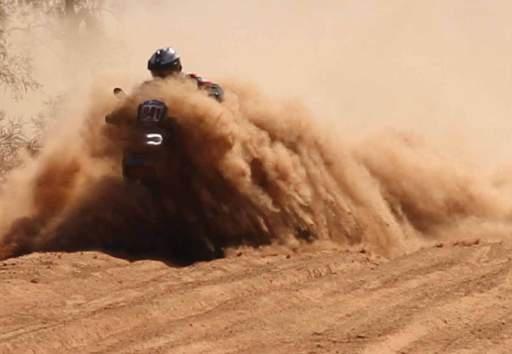
Top right: Good technique and some mechanical sympathy can go a long way to more successful adventure rides.
Top far right: Before, during and after each ride you should be taking time to keep an eye on your bike.
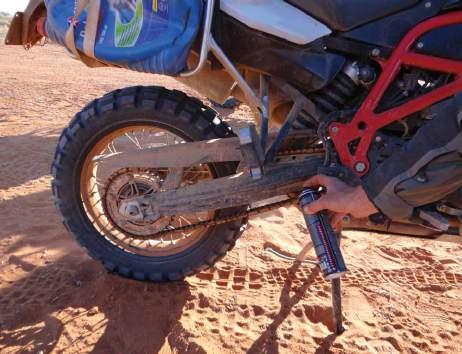
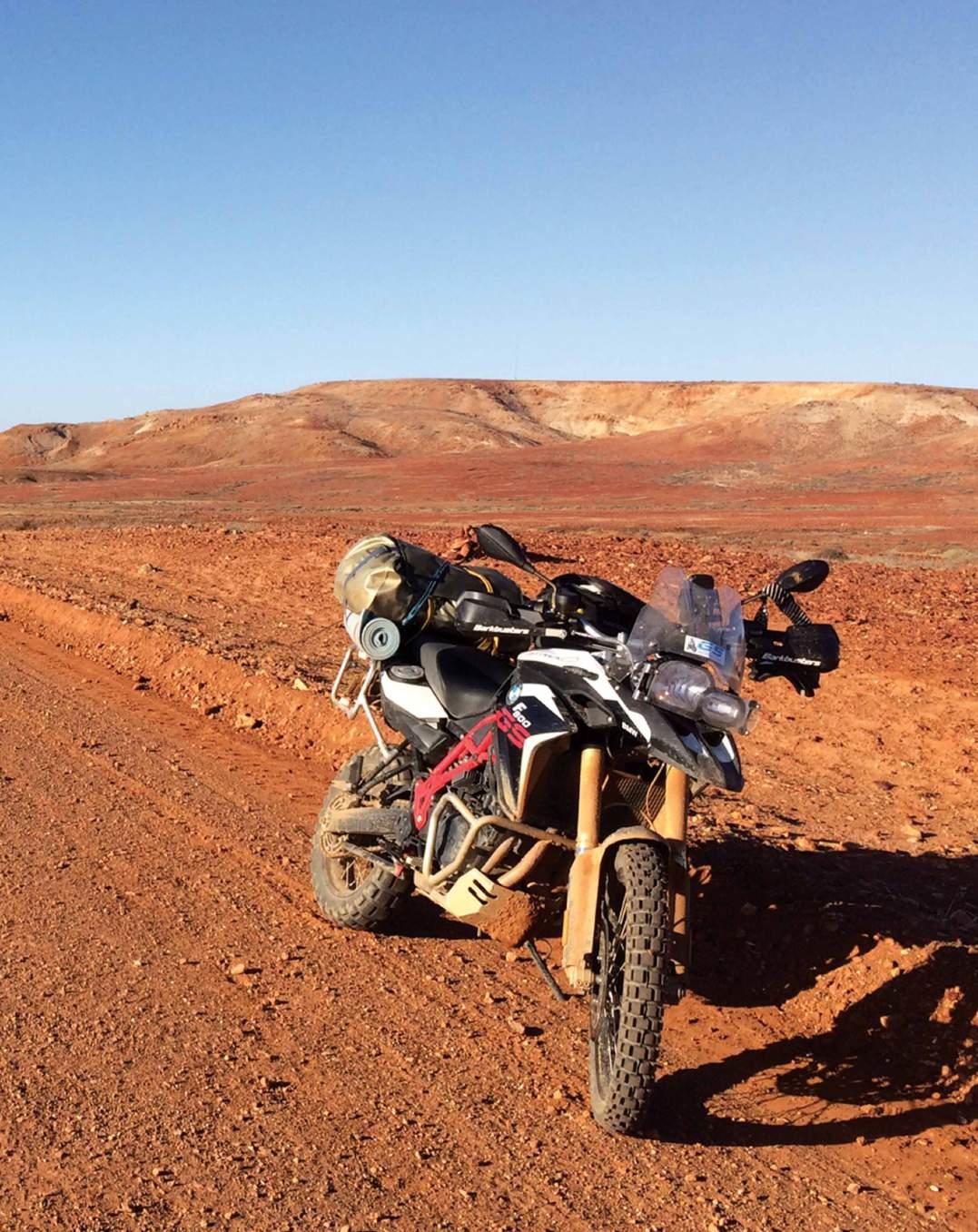
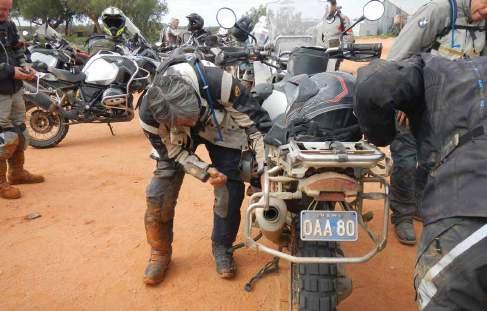
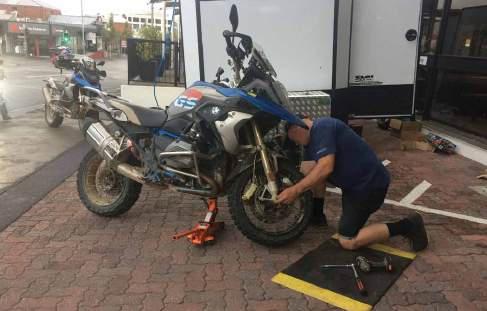
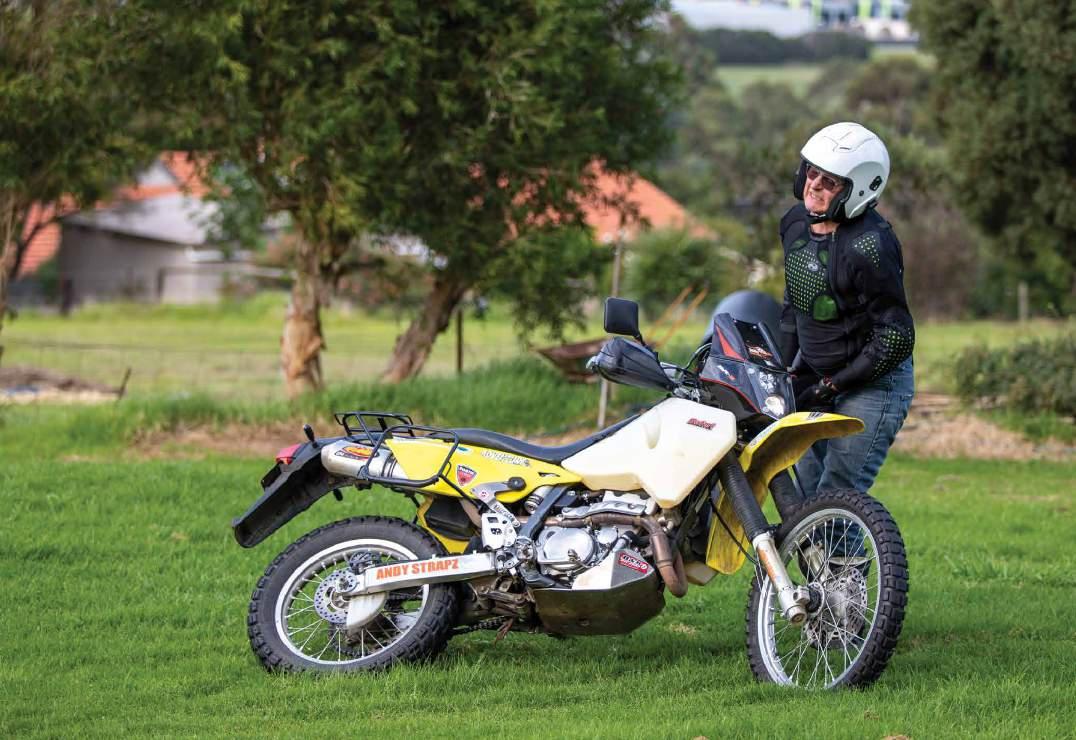
This year certainly has been one of change and challenge. No sooner had we set a plan to spread the love in the bushfire-ravaged areas than we got locked in the shed.
There are only so many times I can check the tyre pressures and chain tension. And…a tidy shed is like a tidy desk; a sign of a sick mind. I’m not going that far.
There is only so much non-riding time this little

black drake can cope with. With a bung ankle, bushfire road closures and now the Mexican Beer Virus, I haven’t ridden for nearly six months and there’s not much more than a lit fart at the end of that tunnel.
I remembered a mate telling me he wore out his first bike, a BSA Bantam, doing laps of the backyard. Never one to be short of an idea (or let common sense get in the way), I thought, ‘Why not use the yard as a training ground?’ Wheelie bins, lemon trees, clotheslines, treated pine logs and hunks of firewood made for a pretty passable obstacle course. Those who live in an apartment block might find a whole world of strife if they were to set up a training course on their property, but my little patch of paradise has enough twists, turns and changes of level to get a sweat up. Slippery grass adds to the work of controlling clutch and throttle. Picking up the bike occasionally just after realising control was lost, again, gets the heart rate up.
Maybe we’ll be a bit freer by the time this edition hits your place. The first few weeks AC (After COVID) are
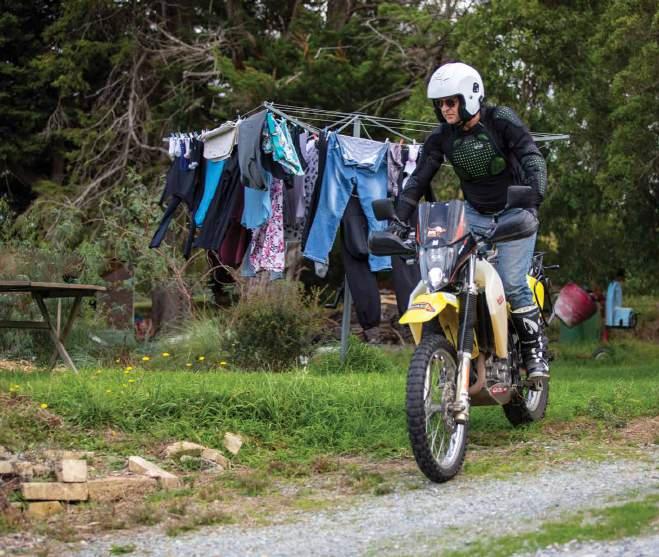
Left: Picking up the bike occasionally gets the heart rate up.
Bottom left: Why not use the yard as a training ground?
Above: Wheelie bins, lemon trees, clotheslines, treated pine logs and hunks of firewood make for a passable obstacle course.
Below: Every rider ever endowed with a pair of handlebars is ready for the moment Scomo drops the flag.
likely to be absolute chaos as every rider ever endowed with a pair of handlebars will hit the road (I expect too many will… literally) and head for the furthest source of carousing, sticky carpet and parmies. How cool will it be to share a camp spot or front bar with a whole lot of other addled, like-minded riders, tonguin’ for a good time and a yarn? Dr Z is parked with the front wheel facing the garage door ready for a rapid exit the moment Scomo drops the flag.

Bikes will be overpacked. We’ve had months to gather the gear for our next trip. I find the longer I have to prepare, the more I convince myself I need another useless bit of kit along…just in case.
Fuel will be stale; the bikes will cough and splutter until the first fuel stop. Bums will be road-soft and wrists will ache from lack of use (don’t go there). Our sleeping bag will smell like a rat died in it (it just might have). Testosterone will ooze like a sea fog and long-dormant skills will be awakened. We might have to take a roll of duct tape and mark out social-distance Xs around the campfire, but none of this will matter as we get the wind on our balding heads, bugs on the visor and dust in our teeth.
So, check yer helmet for spiders, shake the cockroaches out of ya jacket and get ready for an old-fashioned Baja start. And be bloody careful. Keep abilities and ambition balanced!


Words: Karen Ramsay

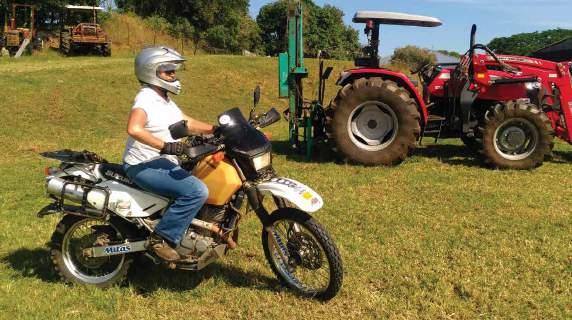
If you’re anything like me, you’ll have spent the time during closures, self-isolation and social distancing getting ready for the moment when you can freely ride. Your bike (or bikes) will have been dismantled and reassembled, serviced, cleaned and ready for riding. You’ll have reorganised your parts and tools, washed and polished all your gear and done all the maintenance you don’t have time for when you’re out riding. You’ll also have been doing a rigorous fitness regime putting you in tip-top shape for the moment you can get out on your bike again. Maybe you’ve done some training exercise on the bike within the confines of your garage, like static balances. Plus, you’ll have done hours of research into the best gear for travelling and practised packing
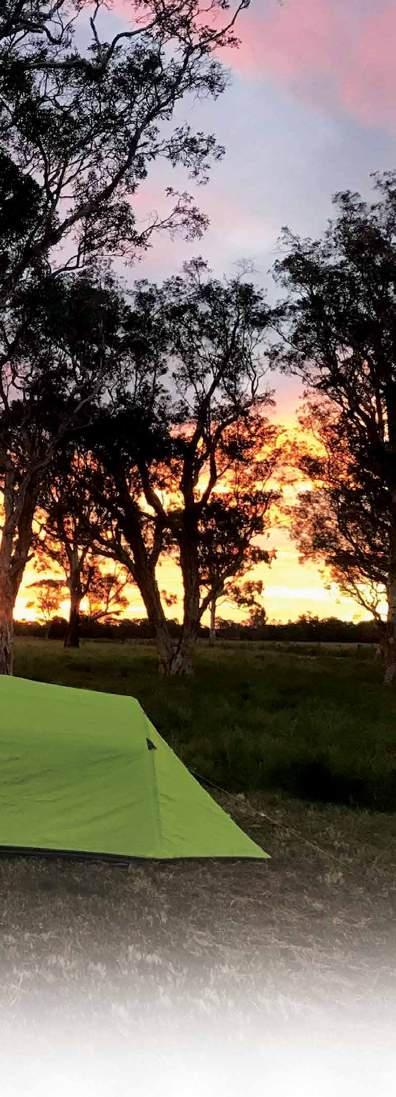
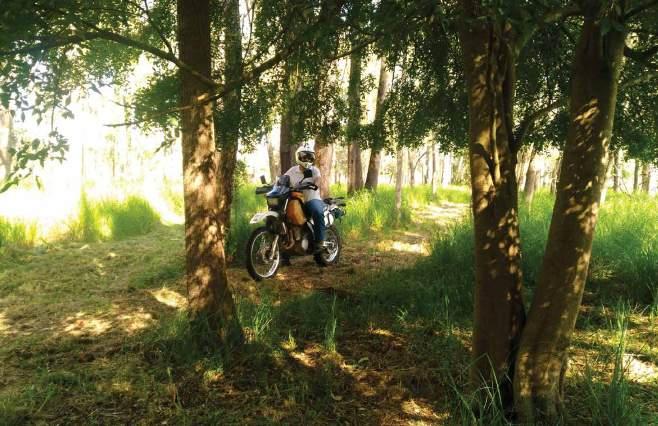
‘How hard could it be?’ I thought to myself.
I set about watching some video clips for techniques and tips. People made it look easy, giving pointers as they climbed all over their bikes (I’m not sure why anyone would need to mount their bike via the front wheel and over the screen, but it does look cool). They gave the basics, such as walking around your bike first to get the feel of where it’s balanced, having it on the centrestand (or in the case of the DR, on the sidestand) and getting the feel of standing up without pulling on

Main: Sunset at the COVID camp. Bottom left: Eyes up and ready to stand. Left: Checking out the slashed tracks. Below: A big ride. All the way to the front gate.
the handlebars, and keeping your weight evenly distributed.
Armed with my new-found knowledge, a goal and a helmet-full of determination I was ready to conquer the skill and become an amazingly more proficient rider in the process. A couple of full lock figure-eights (okay, they were nowhere near full lock. But in my mind I was aiming for full lock), several laps holding and walking around the bike, and I was ready to conquer the skill.
If I was being kind to myself, I’d make excuses about the DR being a lot bigger and heavier than the little dirt bikes in
your bike with various weight and load distributions to find the optimum travelling configuration. You’ll have meticulously planned tracks and routes. Actually, if you’re anything like me, you would have thought about all of that and not done most of it.
I did spend a couple of hours trying to static balance on my bike.
I was inspired by a friend, Tara, who proudly (and rightly so) proclaimed to have achieved around eight minutes of balancing after two hours practice.

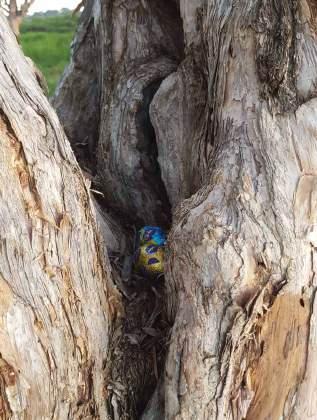
the video examples on the web. I’d blame the wind and perhaps the moon phase.
The reality was, I sucked.
And I tried. Boy, did I try.
I know balance is not my thing, but this took it to a whole new level of embarrassment. Eventually I coerced Dave into holding the bike so I could at least get up on the ’pegs. I reckon I
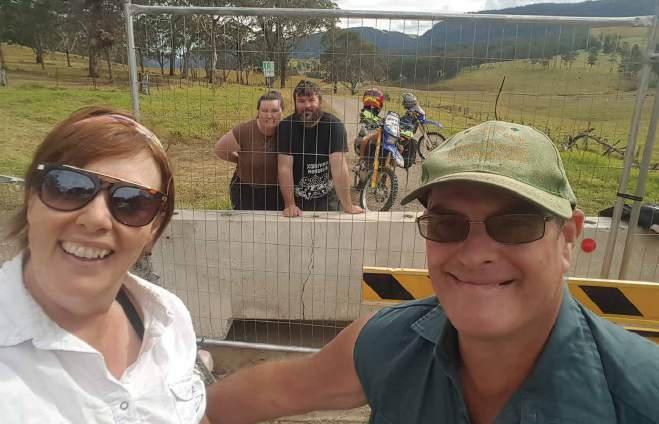
managed about eight seconds without him holding the bike. At the end of a couple of hours I was exhausted and disheartened. Perhaps when the next pandemic comes along I’ll try again.
On a positive note, I’m more mindful of my weight distribution while riding, especially when riding slowly, which is good.


The other bike-related activity was an Easter camping trip.
Dave thought it’d be fun to put the idea up as a ride event on social media – a ‘covert COVID campout’. The whole idea was for everyone pack their bike and head off for a night or two over Easter and go camping around their own homes



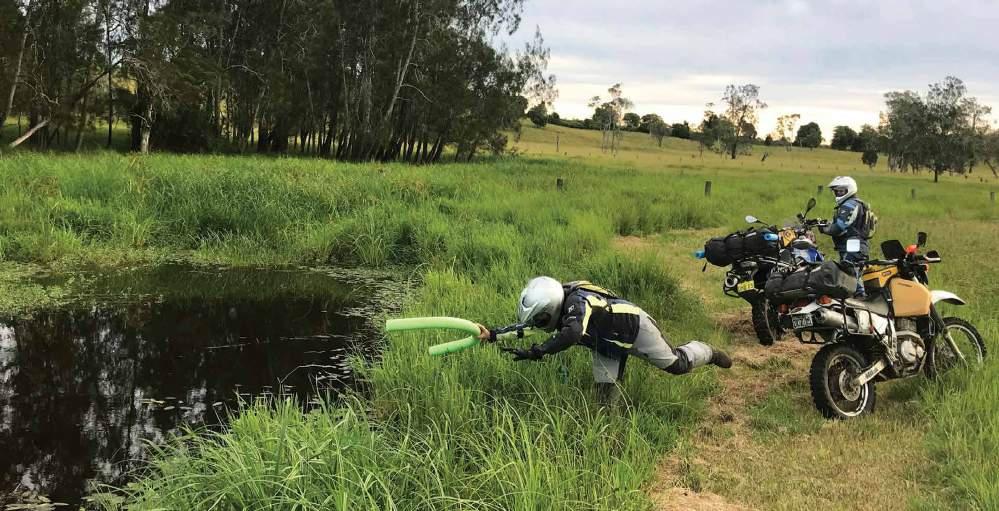
and properties, whether it was backyards, back paddocks or back verandahs. Dave did a recce ride for us and even slashed the track. There’s something to be said for
Far top left: The Easter bilby found the campers.
Top left: Queenslanders Andrea and Hicksy behind their locked border.
Above: The pull of the pool noodle. Pic by Bessy.
Below: Socially distant border picnic.
Right: Who would’ve thought they’d elope?
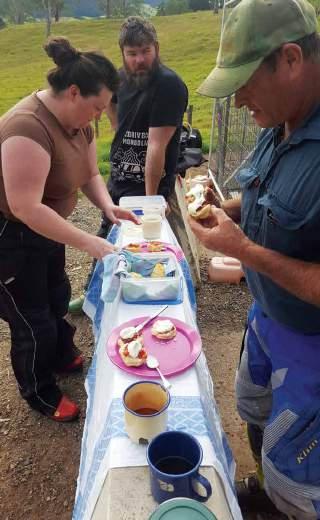
turning up at a campsite in the afternoon and not have to light a fire or put up the tent because you already did it earlier in the day! Not to mention the esky full of ice and refreshments.
Living close to the Queensland border provided us with a unique experience. Once we were free to travel within NSW we organised a border picnic with Dave and Andrea at a ‘hard-road closure’. There’s no way anyone was sneaking through those crossings!
It was great to get out for a decent ride and even better to catch up with friends. Scones and egg sandwiches and a nice cup of tea. There’s no doubt that we’re hard-core adventure riders.
In other news, we got a phone call from our daughter Tinonee in New Zealand to say she’d got engaged to her partner Jamie! That was exciting news. Who would’ve thought that less than a week later they’d ring us up and tell us they’d eloped?
After six weeks in lockdown they were the first wedding in town. Of course, they didn’t have rings and had to borrow clothes. Now we’ll have to start hoping travel to the UK will be open by September next year so we can head to Scotland for a party.
We might even fit in a wee spot of riding.


what i’ve learned
R Static balancing is hard
R Adventure riders are a resourceful and resilient bunch
R Illicit cross-border picnics could catch on
R Possum-skin coats and colourful jackets make perfect COVID wedding clothes
R We’ll all appreciate catching up with friends again
Two-stage heated-grips kit allows the heating elements to be fitted neatly and discretely under OEM or aftermarket grips.
R Easy to install
R Two heat settings
R Suitable for all types of bikes
R Elements attach with Mylar tape
R Three-amp draw (36W) on the ‘high’ position
R No external resistor or other parts are needed
R Three-position (off, high, low) metal toggle switch or surface-mounted plastic rocker switch
R Extend the riding season
RRP: $79.95 plus postage
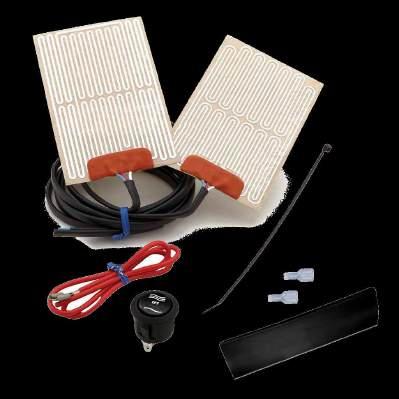
Available from: Adventure Bike Australia Web: adventurebikeaustralia.com.au
For the roughest singletrack to the urban blacktop.
R Integrated anti-fog, anti-scratch faceshield
R Shield flips up and has enough room for goggles
R Shield can be removed completely
R Adjustable visor can be removed
R MIPS protection
R Velocity Flow ventilation
R Removable, washable, anti-microbial liner
RRP: From $349 ($379.95 for model shown)
Available from: All good motorcycle retailers Web: cassons.com.au
Back country cuiSine freeze-DrieD mealS
Easy to prepare and great tasting.
R Freeze-dried vegetables and meats with sauce mixes processed to retain their natural flavours
R Can be prepared in the pack in 10 minutes
R Add boiling water
R After packing, the food is heat-sealed in foil pouches, then the air is removed and replaced with nitrogen gas and replaced with nitrogen gas
R Safe and flavoursome years without the
RRP: One-person meal $11.95
Two-person meal $14.95
Available from: AdventureMoto Web: adventuremoto.com.au
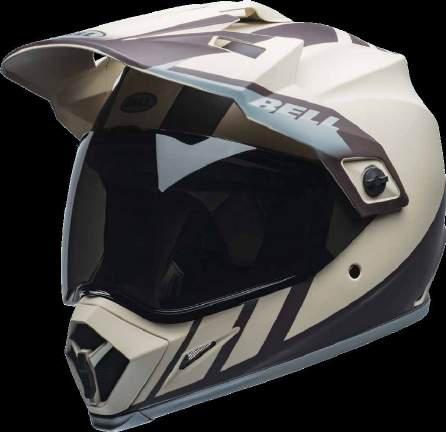
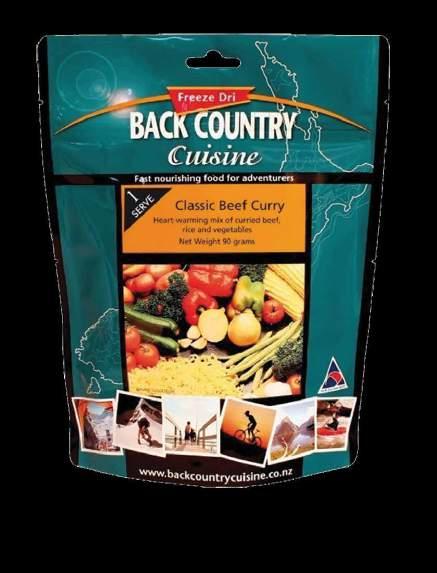

Unmatched cooking and eating convenience.
R Metal handles
R Optimized spoon angle
R Unbeatable simmer control
R Regulated for consistent performance
R Convenient, reliable pushbutton igniter
R Drink-through lid with pour spout and strainer
R Bottom cover doubles as a measuring cup and bowl
R Compatible accessories include a Grande coffee press, pot support, utensils, FluxRing fry pan and FluxRing cooking pot
RRP: $299.95 AdventureMoto $245
Available from: AdventureMoto

Web: adventuremoto.com.au
Gore-tex gloves with Gore 2in1 technology.
R SAS-TEC knuckle protection
R Ball of thumb reinforced with SuperFabric-brand material (32% Polyester, 68% Epoxidharz)
R Reinforced edge of hand
R Taslan (100-per-cent polyester), leather detailed back
R Highly abrasion-resistant kangaroo-leather palm
R Colourfast and sweatproof
R Available in black only
R Sizes 7, 8, 9, 10, 11, 12
A terrific all-day sock.
R Made in Victoria using fine merino wool
R Six-centimetre extra length over standard boot socks
R Heels, toes and soles are reinforced and padded with cotton
R Sizes 2-8, 6-10 and 11-14
RRP: $17 plus post or three for $47 posted
Available from: Andy Strapz
Phone: (03) 9786 3445
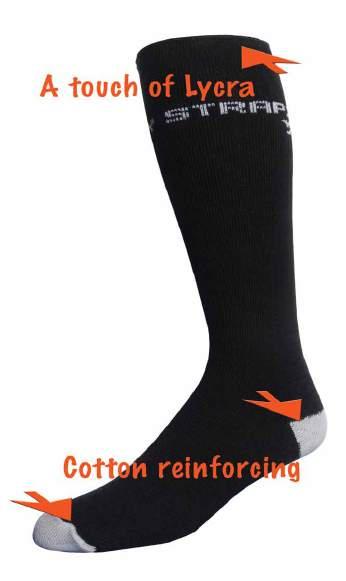
Email: info@andystrapz.com Web: andystrapz.com
The newest addition to Shinko’s hybrid off-road tyre range.
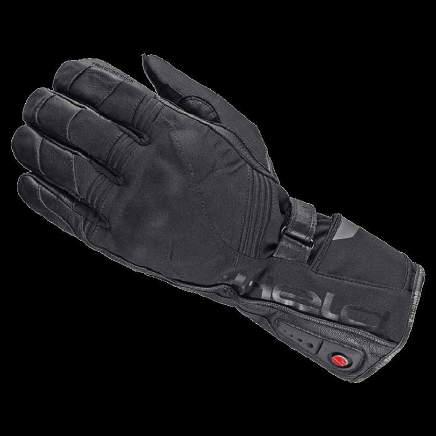
R Large rolling diameter and section width
Made to handle all kinds of uneven and difficult surfaces
Reinforced outer knobs
Recommended for extreme enduro DOT approved and FIM marked (although not recommended for highway use)
More details available at shinkotyres.com.au/shop/ sr216-cheater/
RRP: $119 including GST
Available from: All good motorcycle dealers
Web: shinkotyres.com.au
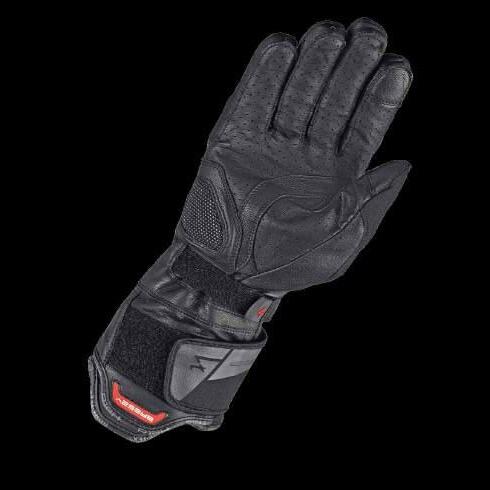
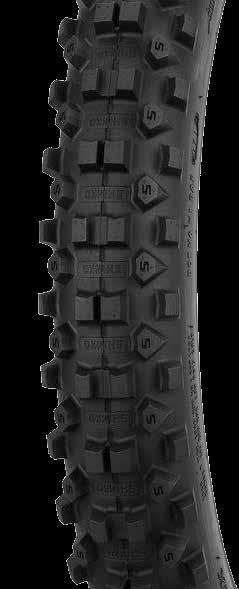
One of the editor’s red-hot favourites.
R Leather and microfibre construction
R Heavy-duty sole, fully perimeter stitched and fully replaceable
R Full waterproof and breathable Gore-tex lining
R Two easy-operation, adjustable-length Tech buckles
A lid with a youth model the same as the adult, only smaller.
R Proprietary KPA shell
R Multi-density EPS liner
R LS2’s Emergency Release System
R Pre-curved comfort liner
R Multiple intake and exhaust channelled ports
R Lateral ankle protection
protection layer covers the internal heel counter and toe box Heel is encased
external protector Ankle protector
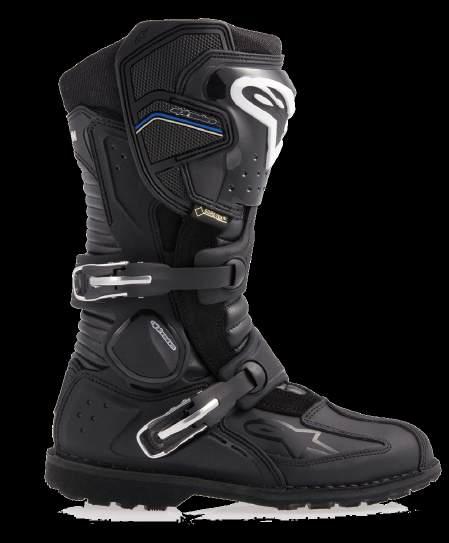
RRP: $569.95
Available from: All motorcycle stores Web: monzaimports.com.au
Higher cranking power and higher amp-hour ratings.
R Patented QuadFlex multi-fit terminals
R Absorbed Glass Mat technology
R Fully sealed
R No initial charging
R Maintenance-free
R 20 per cent more cold cranking amps (CCA)
R Easy accessory connection with multiple terminals
RRP: From
MBTX9U $97.97.
MBTZ14S $134.71.
MBY16H $157
Available from: Most motorcycle dealers Web: whitesmoto.com.au/pages/motobatt
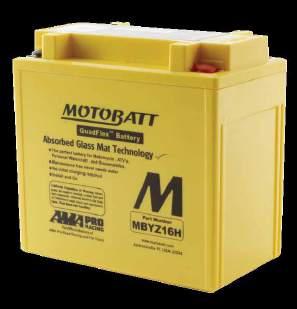
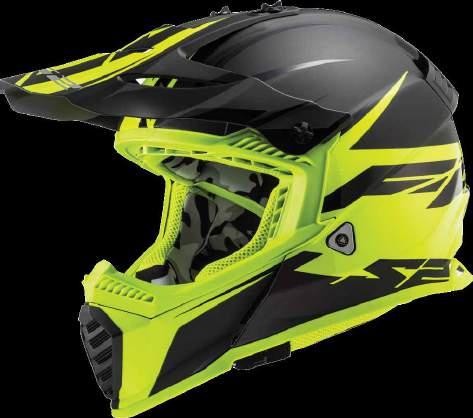
RRP: Youth $179. Solid $189, Graphics $199
Available from: Any LS2 helmet dealer Web: ls2helmets.com.au/collections/ ls2-mx437-fast-helmet
Specially made using the original Suzuki seats.
R Available to buy or exchange
R Slightly concave
R 50mm wider than standard under the bum

and then send the original DR650 seat and, provided it’s in good condition, VSM will refund $100
Available from: Vince Strang Motorcycles Web: vsm.net.au
macna ion gloveS
Electric heated gloves.
R Waterproof
R Fitted with lithium-ion batteries in the cuff
R Up to 6.5 hours of warmth
R Four heat settings
R Optional connection cable to power the gloves straight from the bike
R Men’s sizes S to 4XL
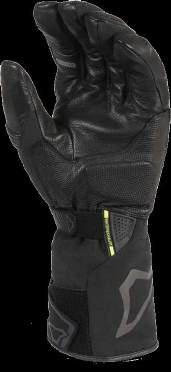
RRP: From $399.95

Available from: All leading motorcycle dealerships Web: macnaridinggear.com.au
motopreSSor Digital tyre preSSure
anD DeptH gauge
Includes a small LED light for low-light conditions.
R Digital tyre tread-depth and pressure measurements
R Tyre pressure units in either PSI, BAR, kPa or kg/cm²
R Tread depth displayed in millimetres or inches
R LCD backlit display (35mm x 25mm)
R Compact design for hard-to-access air valves and dual-disc brake systems
R Automatic 30-second shut-off
R Weighs 40gm
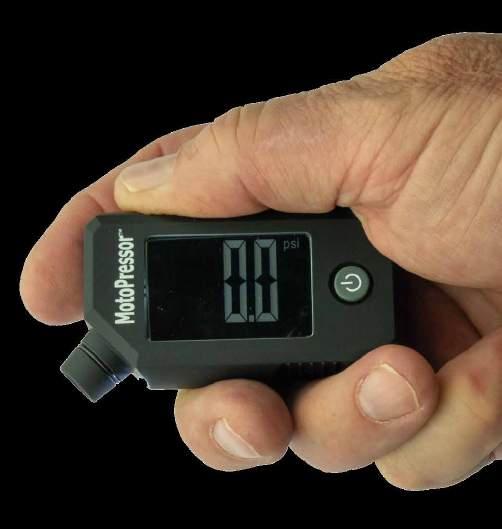
RRP: $26.95 plus postage and handling
Available from: Rocky Creek Designs and all good motorcycle stores through Pro Accessories Web: rockycreekdesigns.com.au
Increases the volume of the original BMW aluminium pannier by 12 litres.
R Place the Volume Booster between the pannier and the lid to increase the height of the pannier by 11cm
R Engages in the lockable latch of the pannier
R Open, load and close the pannier as usual
R Made from the same high-quality materials as the BMW pannier
R Waterproof due to a special seal in the plastic frame
R Robust construction from Germany
R Compatible with BMW aluminium pannier for: BMW R1250GS; BMW R1250GS Adventure; BMW R1200GS (LC); BMW R1200GS Adventure (LC) and BMW F850GS Adventure
R Approximately 27cm x 44cm x 11cm
RRP: From $343.14
Available from: www.shop.touratech.com.au Web: www.touratech.com.au

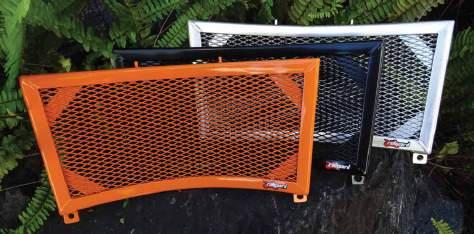
raD guarD ktm 690 enDuro r 2019-20 raDiator guarD
An essential aftermarket part.
R For the hardcore adventure rider
R Easy to fit
R Video fitting instructions available
R Lightweight and doesn’t restrict air flow
R Made from 6060 T1 – T5 aluminium
R Available in black, polished alloy and orange
R Three-year worldwide warranty
R Australian made
RRP: $228. On special for $179
Available from: Rad Guard
Phone: (02) 6658 0060
Web: radguard.com.au
A hard-wearing men’s jacket.
R Robust jacket with the adventure look
R Cotton/polyamide blend with wax finish
R Two waterproof front pockets, one large back pocket
R Inner rain jacket available separately
R Stretch on shoulders and sleeves for freedom of movement
An aftermarket ride-by-wire cruise control!
R Everything needed is supplied in the kit
R Purpose-built switch with backlights
R CAN compatible using the bike’s CAN signals

R Back and chest ventilation for a pleasant body temperature Web:
Panniers are available in three colours: Black, Frozen Grey and Raw Aluminium.
R Three size options: 35-litre and 31-litre, 40-litre and 36-litre and 45-litre and 41-litre. Please note one pannier is smaller to fit around the exhaust
R Stainless-steel fittings, including a lockable quick-release mechanism
R Friction hinges so the lid doesn’t close unexpectedly
R Two-milllimetre aluminium structure with smooth, powder-coat finish inside and out for Black and Frozen Grey
R 100% waterproof construction
R Many accessories available: lid-organiser bag, inner-liner bag, removable carry handle and more
R Designed for KTM, BMW, Honda, Ducati, Triumph, Suzuki, Husqvarna, Yamaha and Moto Guzzi adventure bikes
RRP: $1979
Available from: Adventure Bike Shop
Phone: 0428 536 519
Web: adventurebikeshop.com.au
R Sophisticated, built-in, LED-driven diagnostic and troubleshooting features
R Built for motorcyclists by motorcyclists
R Waterproof computer module and harness connections
R Compatibility with some really exciting innovations due for release soon
RRP: From $799
Web: mccruise.com
Phone: 03 9808 2804

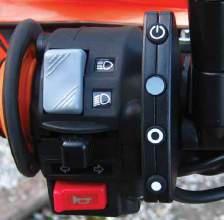
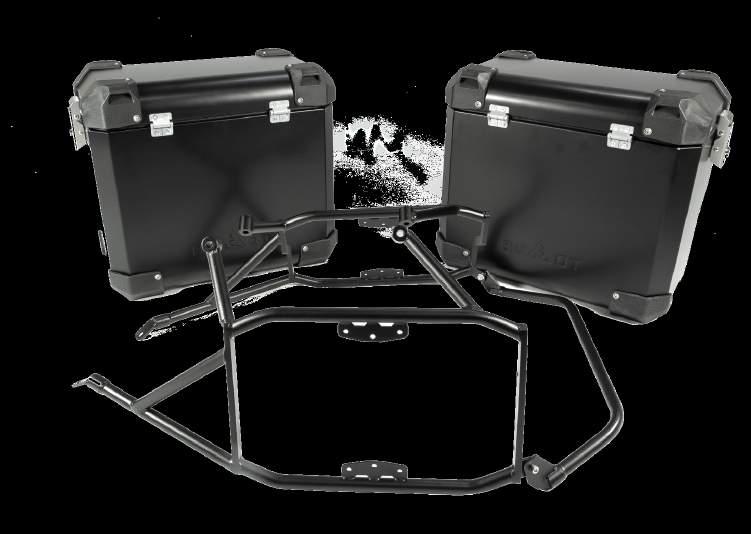
A mixture of race wets and touring outer wear.
R 2.5-layer, stretch-fabric, breathable outer shell
R Two external pockets, one inner pocket
R Velcro closure at wrists, zips and Velcro at ankles
R Small pack size
R Held Clip-in Technology including bag
R Reflective sections
R Available in black-white or black-fluorescent yellow
R Sizes S to 5XL
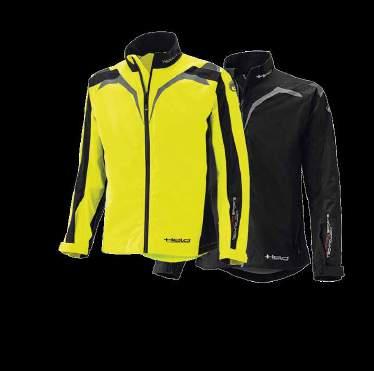
A good size for dualsport and enduro bikes. Rigg gear lifetime warranty
100-per-cent waterproof, PVC tarpaulin with welded seams
UV-coated outer material
Quick-release strap system
Straps in base to help secure belongings
Clear touch-screen-device-friendly top pocket
RRP: Top $160. Base $160
Web: heldaustralia.com.au
Email: info@mig.bike
Phone: 1300 916 916

rokform ruggeD pHone caSe
For iPhone or Galaxy smartphones.
R Dual-compound, ultralight shockproof case
R Hard polycarbonate outer shell with soft, impact-resistant core
R Exceeds military drop test standards MIL-STD 801G-516.6
R Mount your phone to a variety of optional accessories for bikes, cars, motorcycles and more
R Specially designed Neodymium magnet allows sticking phone to almost any magnetic surface
R Will not negatively impact GPS, credit cards, Wi-Fi, Apple Pay, Bluetooth, camera or data transfer
RRP: $69.95
Available from: Bike shops Web: ctaaustralia.com.au
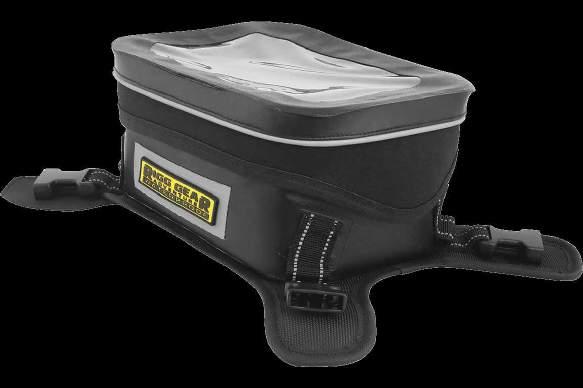

Go light, even with pannier frames. Designed and tested by Lyndon Poskitt.
R No additional mounting plate required
R Fully water, dust, mud and snow proof
R Fit 18mm-diameter racks
R Easy fastening, quick removal
R Can be used on the right and left side of the motorcycle
R Four compression straps and interfaces to attach bottle/can holsters
R Two interfaces to attach fender bags S or L
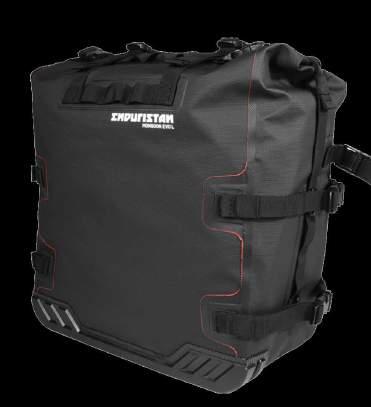
R Small 24 litres. Large 34 litres
RRP: Small $539. Large $569
Available from: Motorcycle Adventure Products Phone: 1300 898 560 Web: motorcycleadventure.com.au

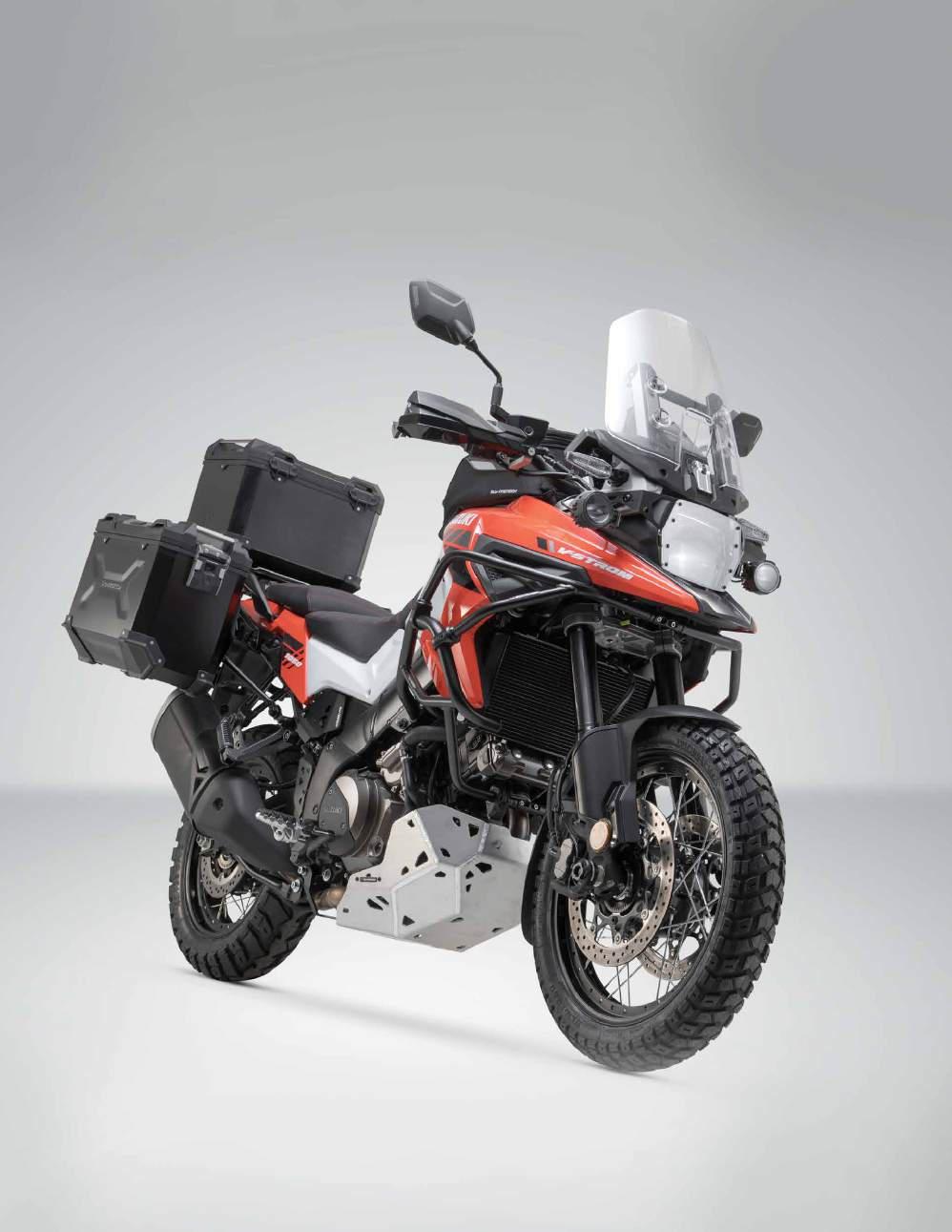


TraX Adventure hard case luggage and accessories are the choice of experienced world travellers like Nicki and Moe. Water and dust proof, tough and secure, no matter what the continent or how extreme the conditions, there’s no place on earth these things wont go.
If you’re travelling near or far, make TraX Adventure luggage part of your adventure.
